CHCDIV001: Learner Workbook - Working Effectively with Diverse People
VerifiedAdded on 2023/06/11

Work with diverse people
Learner Workbook
Paraphrase This Document
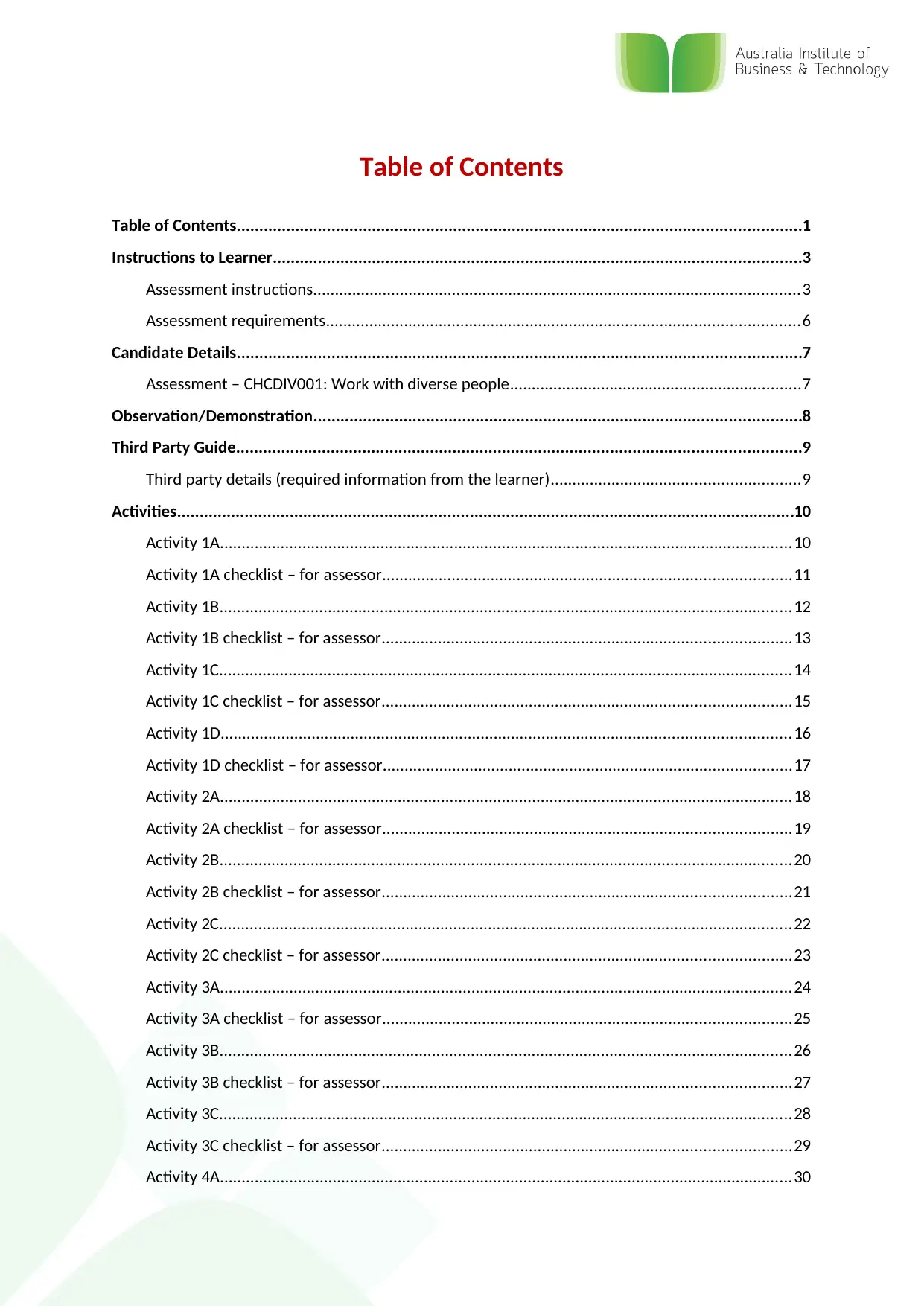
Table of Contents.............................................................................................................................1
Instructions to Learner.....................................................................................................................3
Assessment instructions................................................................................................................3
Assessment requirements.............................................................................................................6
Candidate Details.............................................................................................................................7
Assessment – CHCDIV001: Work with diverse people...................................................................7
Observation/Demonstration............................................................................................................8
Third Party Guide.............................................................................................................................9
Third party details (required information from the learner).........................................................9
Activities.........................................................................................................................................10
Activity 1A....................................................................................................................................10
Activity 1A checklist – for assessor..............................................................................................11
Activity 1B....................................................................................................................................12
Activity 1B checklist – for assessor..............................................................................................13
Activity 1C....................................................................................................................................14
Activity 1C checklist – for assessor..............................................................................................15
Activity 1D...................................................................................................................................16
Activity 1D checklist – for assessor..............................................................................................17
Activity 2A....................................................................................................................................18
Activity 2A checklist – for assessor..............................................................................................19
Activity 2B....................................................................................................................................20
Activity 2B checklist – for assessor..............................................................................................21
Activity 2C....................................................................................................................................22
Activity 2C checklist – for assessor..............................................................................................23
Activity 3A....................................................................................................................................24
Activity 3A checklist – for assessor..............................................................................................25
Activity 3B....................................................................................................................................26
Activity 3B checklist – for assessor..............................................................................................27
Activity 3C....................................................................................................................................28
Activity 3C checklist – for assessor..............................................................................................29
Activity 4A....................................................................................................................................30

Activity 4B....................................................................................................................................32
Activity 4B checklist – for assessor..............................................................................................33
Summative Assessments................................................................................................................34
Section A: Skills Activity...............................................................................................................35
Section B: Knowledge Activity (Q & A).........................................................................................36
Summative Assessments: Section B checklist..............................................................................38
Section C: Performance Activity...................................................................................................39
Summative Assessments: Section C checklist..............................................................................40
Workplace Documentation – for learner........................................................................................41
Workplace documents checklist..................................................................................................41
Supplementary Oral Questions (optional) – for assessor................................................................42
Competency record to be completed by assessor...........................................................................45
⊘ This is a preview!⊘
Do you want full access?
Subscribe today to unlock all pages.

Trusted by 1+ million students worldwide
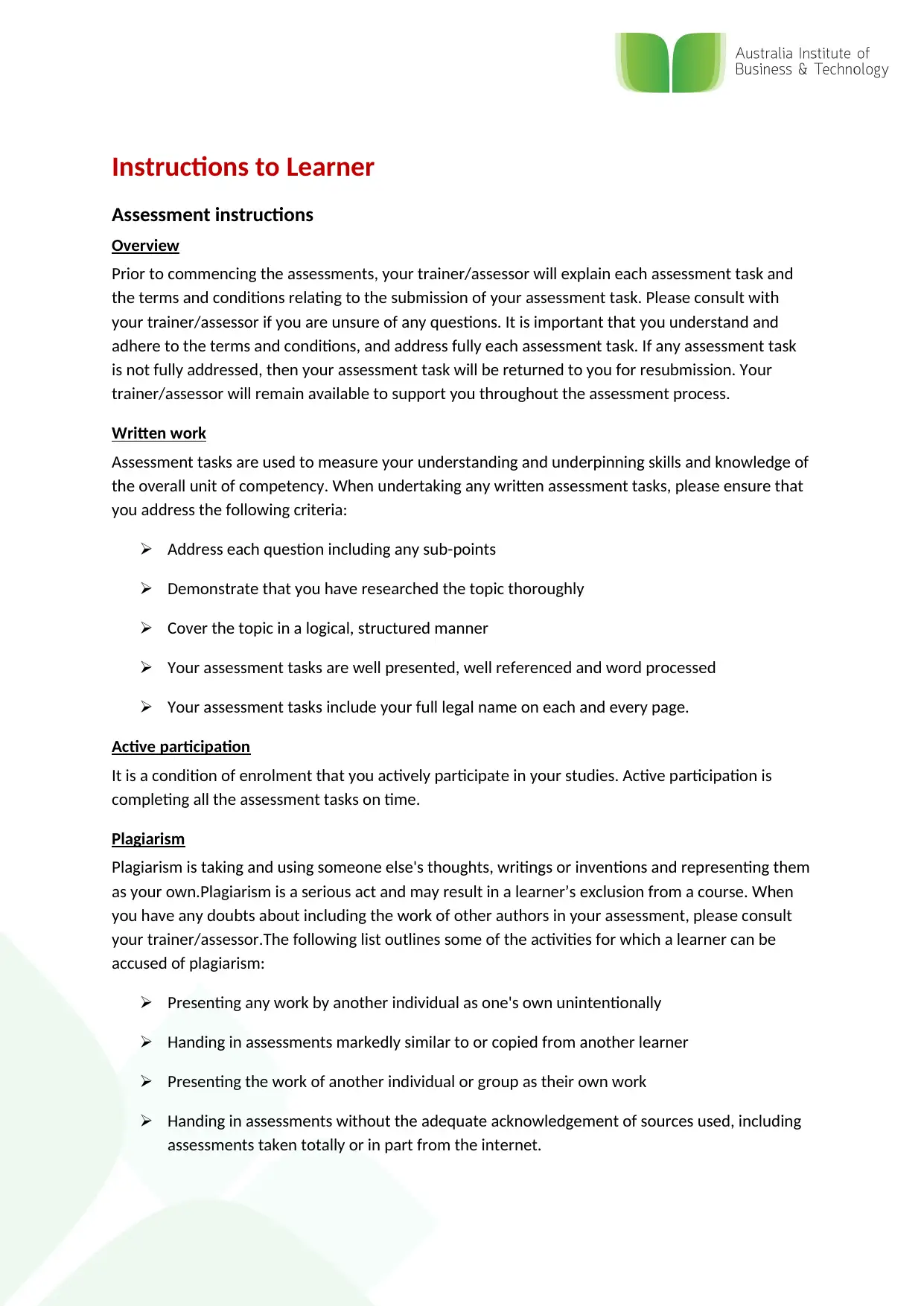
Assessment instructions
Overview
Prior to commencing the assessments, your trainer/assessor will explain each assessment task and
the terms and conditions relating to the submission of your assessment task. Please consult with
your trainer/assessor if you are unsure of any questions. It is important that you understand and
adhere to the terms and conditions, and address fully each assessment task. If any assessment task
is not fully addressed, then your assessment task will be returned to you for resubmission. Your
trainer/assessor will remain available to support you throughout the assessment process.
Written work
Assessment tasks are used to measure your understanding and underpinning skills and knowledge of
the overall unit of competency. When undertaking any written assessment tasks, please ensure that
you address the following criteria:
Address each question including any sub-points
Demonstrate that you have researched the topic thoroughly
Cover the topic in a logical, structured manner
Your assessment tasks are well presented, well referenced and word processed
Your assessment tasks include your full legal name on each and every page.
Active participation
It is a condition of enrolment that you actively participate in your studies. Active participation is
completing all the assessment tasks on time.
Plagiarism
Plagiarism is taking and using someone else's thoughts, writings or inventions and representing them
as your own.Plagiarism is a serious act and may result in a learner’s exclusion from a course. When
you have any doubts about including the work of other authors in your assessment, please consult
your trainer/assessor.The following list outlines some of the activities for which a learner can be
accused of plagiarism:
Presenting any work by another individual as one's own unintentionally
Handing in assessments markedly similar to or copied from another learner
Presenting the work of another individual or group as their own work
Handing in assessments without the adequate acknowledgement of sources used, including
assessments taken totally or in part from the internet.
Paraphrase This Document
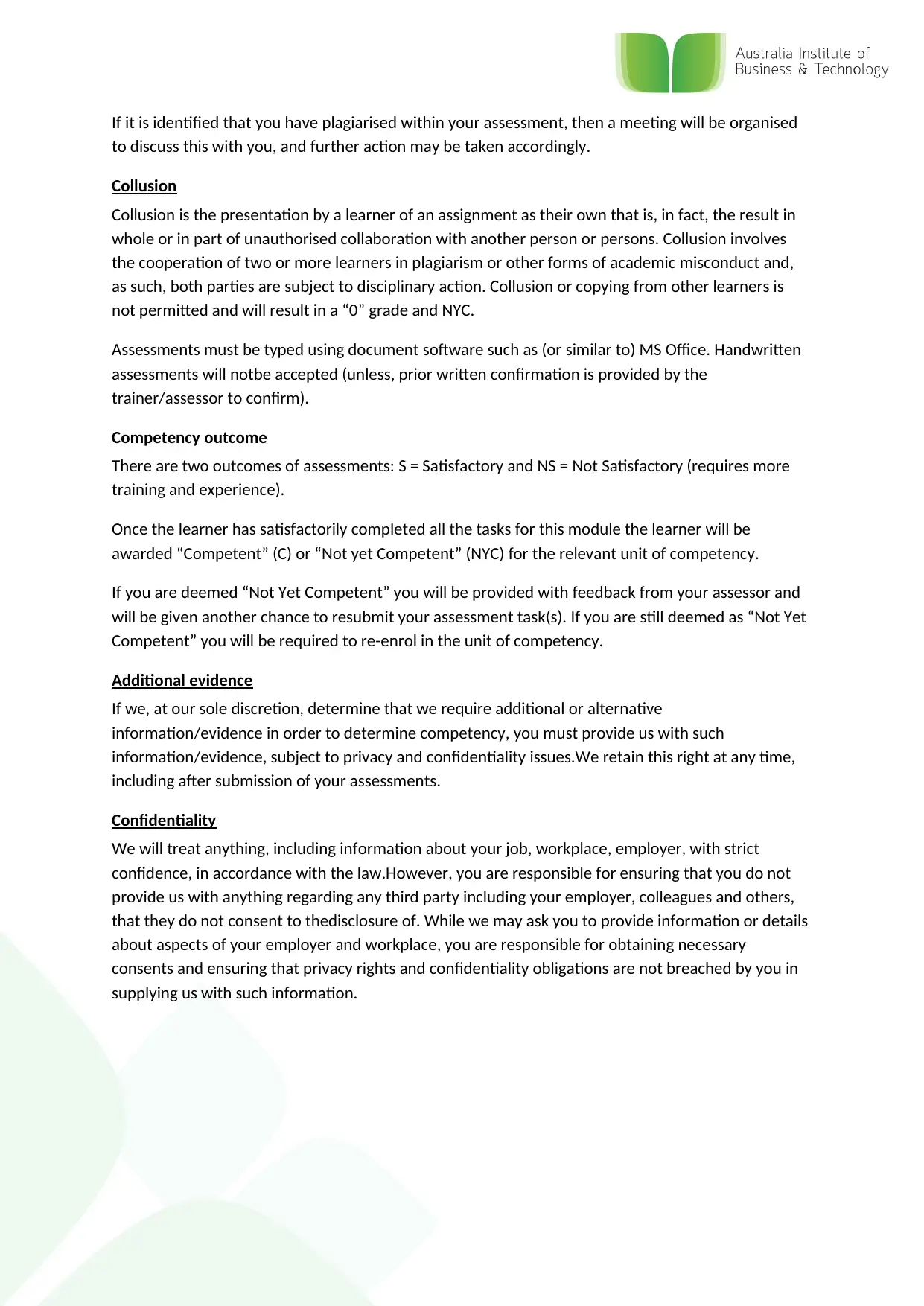
to discuss this with you, and further action may be taken accordingly.
Collusion
Collusion is the presentation by a learner of an assignment as their own that is, in fact, the result in
whole or in part of unauthorised collaboration with another person or persons. Collusion involves
the cooperation of two or more learners in plagiarism or other forms of academic misconduct and,
as such, both parties are subject to disciplinary action. Collusion or copying from other learners is
not permitted and will result in a “0” grade and NYC.
Assessments must be typed using document software such as (or similar to) MS Office. Handwritten
assessments will notbe accepted (unless, prior written confirmation is provided by the
trainer/assessor to confirm).
Competency outcome
There are two outcomes of assessments: S = Satisfactory and NS = Not Satisfactory (requires more
training and experience).
Once the learner has satisfactorily completed all the tasks for this module the learner will be
awarded “Competent” (C) or “Not yet Competent” (NYC) for the relevant unit of competency.
If you are deemed “Not Yet Competent” you will be provided with feedback from your assessor and
will be given another chance to resubmit your assessment task(s). If you are still deemed as “Not Yet
Competent” you will be required to re-enrol in the unit of competency.
Additional evidence
If we, at our sole discretion, determine that we require additional or alternative
information/evidence in order to determine competency, you must provide us with such
information/evidence, subject to privacy and confidentiality issues.We retain this right at any time,
including after submission of your assessments.
Confidentiality
We will treat anything, including information about your job, workplace, employer, with strict
confidence, in accordance with the law.However, you are responsible for ensuring that you do not
provide us with anything regarding any third party including your employer, colleagues and others,
that they do not consent to thedisclosure of. While we may ask you to provide information or details
about aspects of your employer and workplace, you are responsible for obtaining necessary
consents and ensuring that privacy rights and confidentiality obligations are not breached by you in
supplying us with such information.
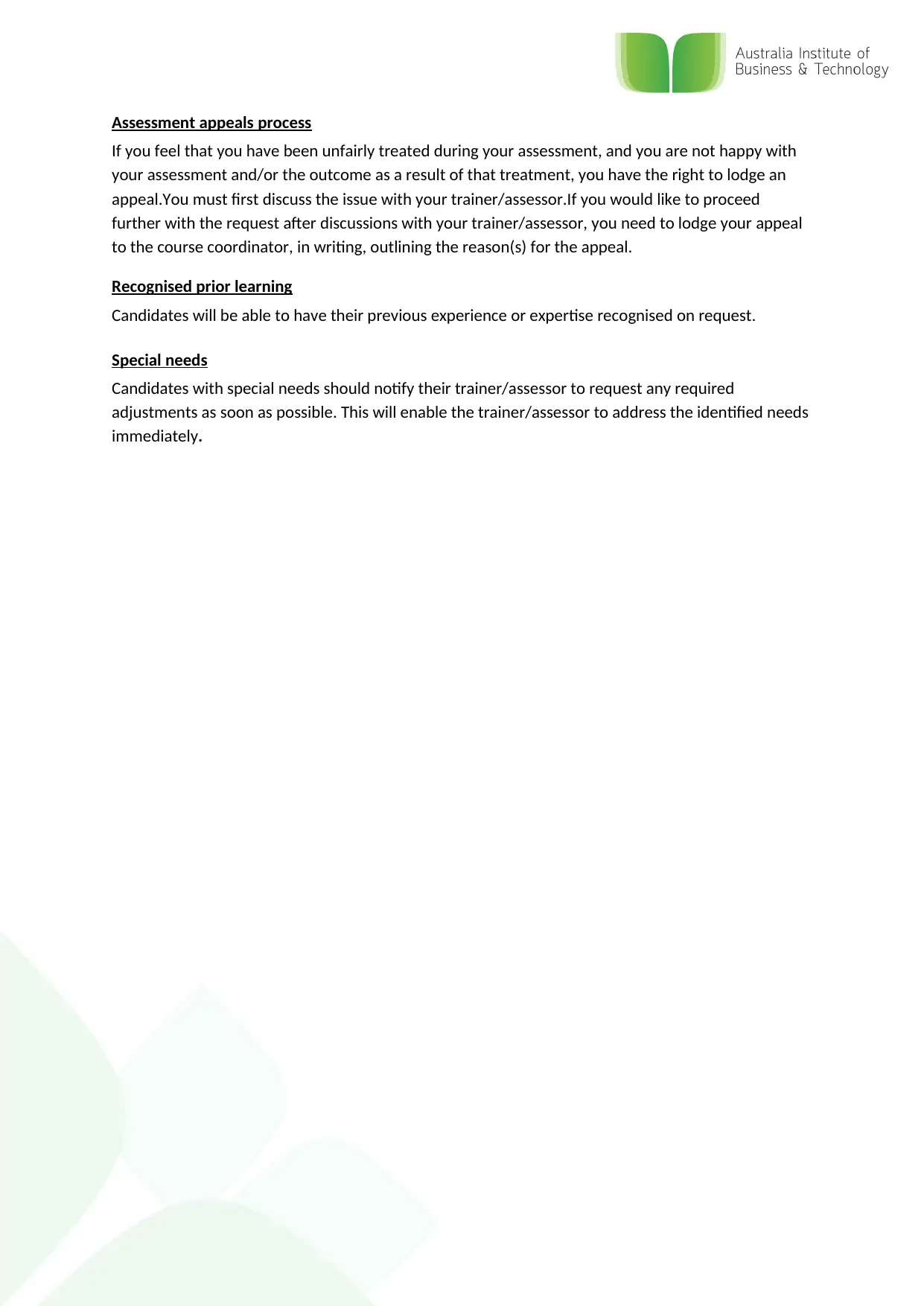
If you feel that you have been unfairly treated during your assessment, and you are not happy with
your assessment and/or the outcome as a result of that treatment, you have the right to lodge an
appeal.You must first discuss the issue with your trainer/assessor.If you would like to proceed
further with the request after discussions with your trainer/assessor, you need to lodge your appeal
to the course coordinator, in writing, outlining the reason(s) for the appeal.
Recognised prior learning
Candidates will be able to have their previous experience or expertise recognised on request.
Special needs
Candidates with special needs should notify their trainer/assessor to request any required
adjustments as soon as possible. This will enable the trainer/assessor to address the identified needs
immediately .
⊘ This is a preview!⊘
Do you want full access?
Subscribe today to unlock all pages.

Trusted by 1+ million students worldwide
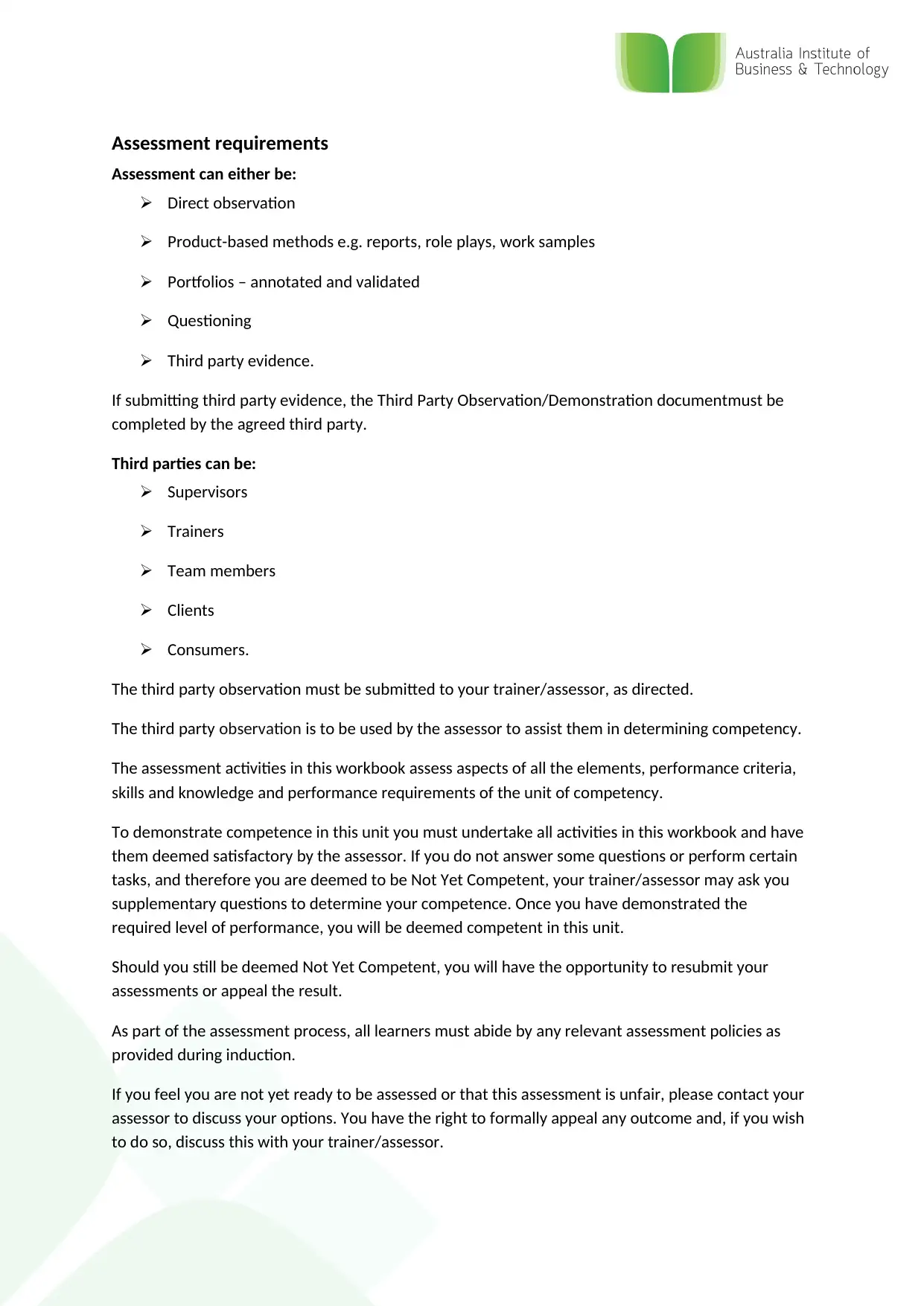
Assessment can either be:
Direct observation
Product-based methods e.g. reports, role plays, work samples
Portfolios – annotated and validated
Questioning
Third party evidence.
If submitting third party evidence, the Third Party Observation/Demonstration documentmust be
completed by the agreed third party.
Third parties can be:
Supervisors
Trainers
Team members
Clients
Consumers.
The third party observation must be submitted to your trainer/assessor, as directed.
The third party observation is to be used by the assessor to assist them in determining competency.
The assessment activities in this workbook assess aspects of all the elements, performance criteria,
skills and knowledge and performance requirements of the unit of competency.
To demonstrate competence in this unit you must undertake all activities in this workbook and have
them deemed satisfactory by the assessor. If you do not answer some questions or perform certain
tasks, and therefore you are deemed to be Not Yet Competent, your trainer/assessor may ask you
supplementary questions to determine your competence. Once you have demonstrated the
required level of performance, you will be deemed competent in this unit.
Should you still be deemed Not Yet Competent, you will have the opportunity to resubmit your
assessments or appeal the result.
As part of the assessment process, all learners must abide by any relevant assessment policies as
provided during induction.
If you feel you are not yet ready to be assessed or that this assessment is unfair, please contact your
assessor to discuss your options. You have the right to formally appeal any outcome and, if you wish
to do so, discuss this with your trainer/assessor.
Paraphrase This Document
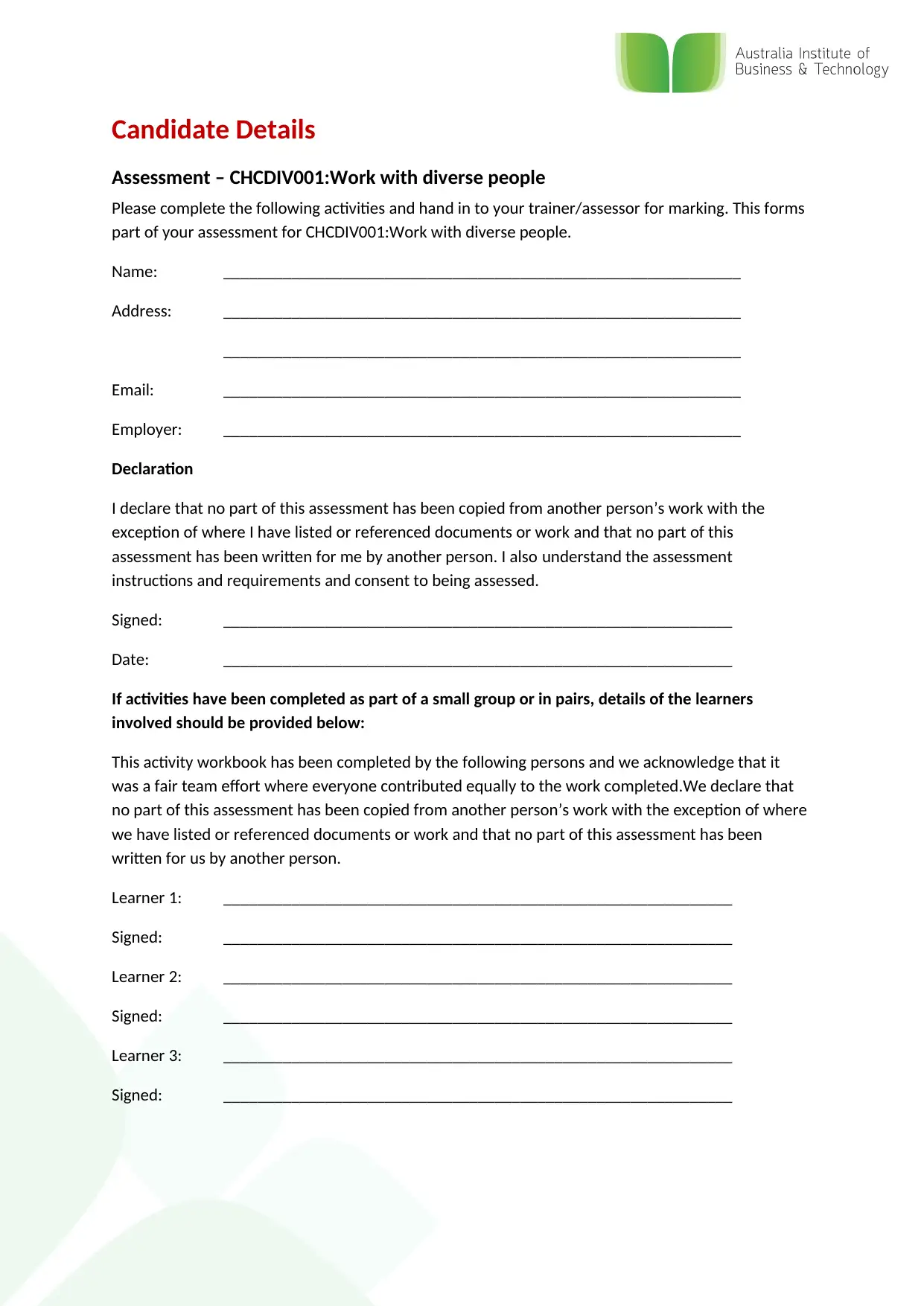
Assessment – CHCDIV001:Work with diverse people
Please complete the following activities and hand in to your trainer/assessor for marking. This forms
part of your assessment for CHCDIV001:Work with diverse people.
Name: _____________________________________________________________
Address: _____________________________________________________________
_____________________________________________________________
Email: _____________________________________________________________
Employer: _____________________________________________________________
Declaration
I declare that no part of this assessment has been copied from another person’s work with the
exception of where I have listed or referenced documents or work and that no part of this
assessment has been written for me by another person. I also understand the assessment
instructions and requirements and consent to being assessed.
Signed: ____________________________________________________________
Date: ____________________________________________________________
If activities have been completed as part of a small group or in pairs, details of the learners
involved should be provided below:
This activity workbook has been completed by the following persons and we acknowledge that it
was a fair team effort where everyone contributed equally to the work completed.We declare that
no part of this assessment has been copied from another person’s work with the exception of where
we have listed or referenced documents or work and that no part of this assessment has been
written for us by another person.
Learner 1: ____________________________________________________________
Signed: ____________________________________________________________
Learner 2: ____________________________________________________________
Signed: ____________________________________________________________
Learner 3: ____________________________________________________________
Signed: ____________________________________________________________
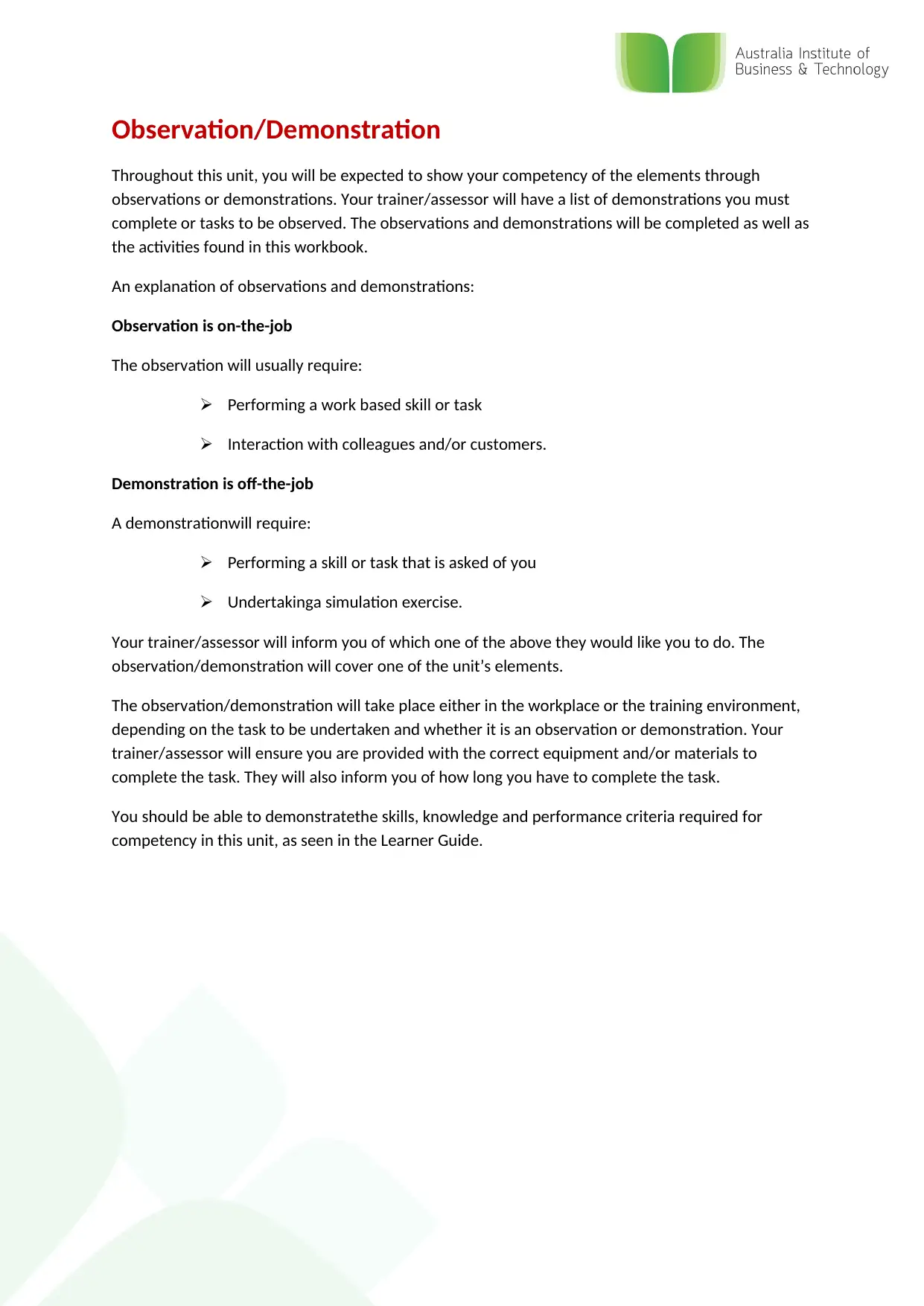
Throughout this unit, you will be expected to show your competency of the elements through
observations or demonstrations. Your trainer/assessor will have a list of demonstrations you must
complete or tasks to be observed. The observations and demonstrations will be completed as well as
the activities found in this workbook.
An explanation of observations and demonstrations:
Observation is on-the-job
The observation will usually require:
Performing a work based skill or task
Interaction with colleagues and/or customers.
Demonstration is off-the-job
A demonstrationwill require:
Performing a skill or task that is asked of you
Undertakinga simulation exercise.
Your trainer/assessor will inform you of which one of the above they would like you to do. The
observation/demonstration will cover one of the unit’s elements.
The observation/demonstration will take place either in the workplace or the training environment,
depending on the task to be undertaken and whether it is an observation or demonstration. Your
trainer/assessor will ensure you are provided with the correct equipment and/or materials to
complete the task. They will also inform you of how long you have to complete the task.
You should be able to demonstratethe skills, knowledge and performance criteria required for
competency in this unit, as seen in the Learner Guide.
⊘ This is a preview!⊘
Do you want full access?
Subscribe today to unlock all pages.

Trusted by 1+ million students worldwide
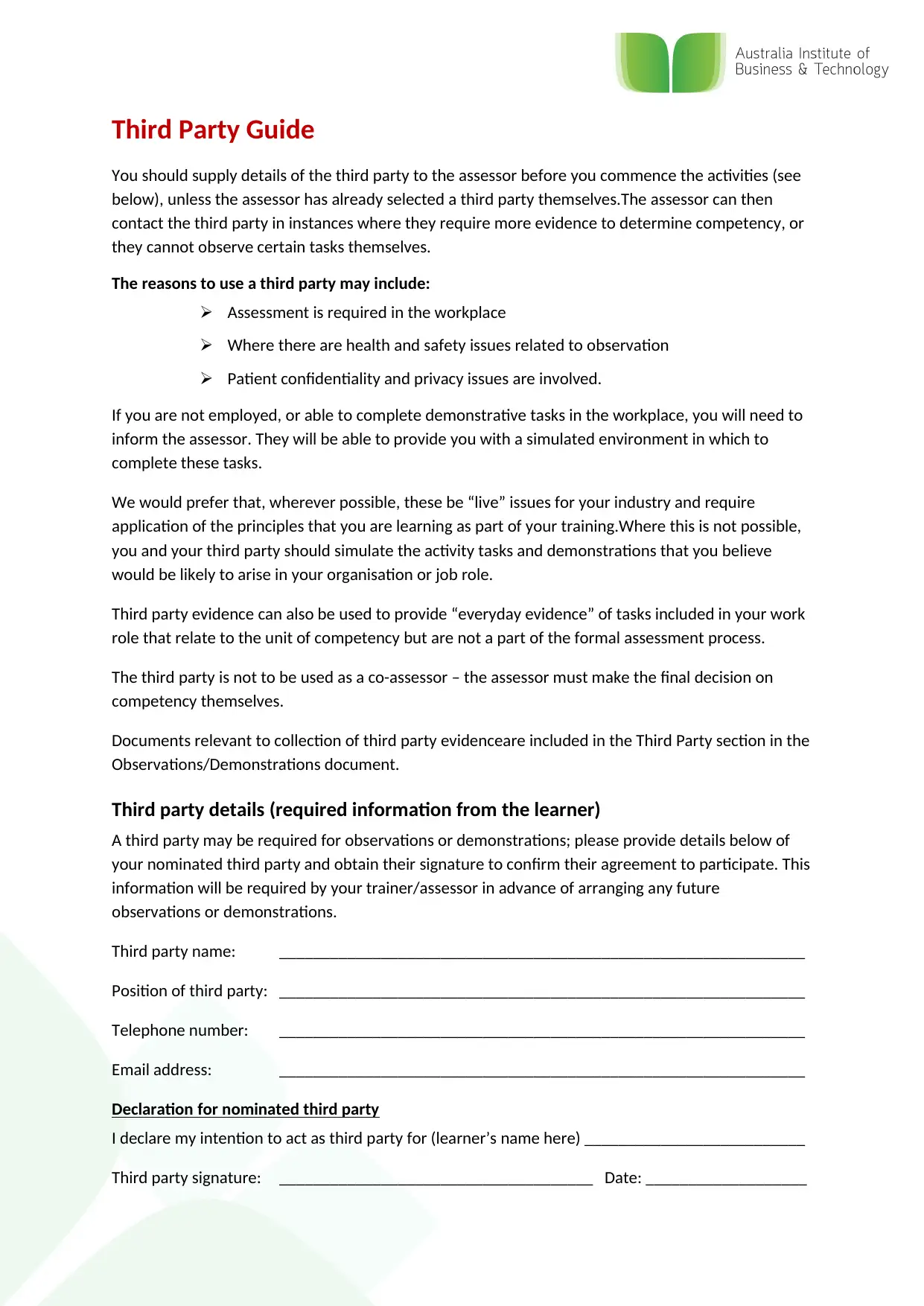
You should supply details of the third party to the assessor before you commence the activities (see
below), unless the assessor has already selected a third party themselves.The assessor can then
contact the third party in instances where they require more evidence to determine competency, or
they cannot observe certain tasks themselves.
The reasons to use a third party may include:
Assessment is required in the workplace
Where there are health and safety issues related to observation
Patient confidentiality and privacy issues are involved.
If you are not employed, or able to complete demonstrative tasks in the workplace, you will need to
inform the assessor. They will be able to provide you with a simulated environment in which to
complete these tasks.
We would prefer that, wherever possible, these be “live” issues for your industry and require
application of the principles that you are learning as part of your training.Where this is not possible,
you and your third party should simulate the activity tasks and demonstrations that you believe
would be likely to arise in your organisation or job role.
Third party evidence can also be used to provide “everyday evidence” of tasks included in your work
role that relate to the unit of competency but are not a part of the formal assessment process.
The third party is not to be used as a co-assessor – the assessor must make the final decision on
competency themselves.
Documents relevant to collection of third party evidenceare included in the Third Party section in the
Observations/Demonstrations document.
Third party details (required information from the learner)
A third party may be required for observations or demonstrations; please provide details below of
your nominated third party and obtain their signature to confirm their agreement to participate. This
information will be required by your trainer/assessor in advance of arranging any future
observations or demonstrations.
Third party name: ______________________________________________________________
Position of third party: ______________________________________________________________
Telephone number: ______________________________________________________________
Email address: ______________________________________________________________
Declaration for nominated third party
I declare my intention to act as third party for (learner’s name here) __________________________
Third party signature: _____________________________________ Date: ___________________
Paraphrase This Document

Complete the following activities individually or in a group (as applicable to the specific activity
and the assessment environment).
Activity 1A
Estimated Time 30 Minutes
Objective To provide you with an opportunity to identify and reflect on own social and
cultural perspectives and biases
Complete the reflection technique described in Chapter 1.1 for ten different
diverse groups. Identify at least one of your cultural biases.
Diverse groups
Muslim. They value the attribute of helping the less fortunate in the society. Their women
wear gowns that cover the whole body. They value their personal space and maintain a
minimal eye contact while conversing.
Orthodox. Males do not shake females’ hands unless except within a marriage (Lavin,
2014). Their daily lives are influenced by the five books of Moses (Torah).
Aboriginal. The group values personal space. They give priority to family and the society.
In a conversation, they might remain silent as this shows respect and that they are listening
attentively.
Millennial. These generation values communication that is brief and precise, but also wants
details provided to them. The millennials command to be treated with respect. The group is
highly flexible, and they are open to online communications round the clock.
Gay. The group includes lesbians and gay men. A majority of these people face
discrimination in areas such as healthcare, housing, etc.
Transgender. They include women who dress as males and men who dress like ladies.
Some even under surgery to change their gender.
African Australians. The group values the input of the family as the basic unit. They
believe that the male is the head of the family. They practice different music genres
including hip-hop, rap, break-dancing, etc.
European Australians. English is their primary language, and they originate from Europe.
They influenced the formation of Australian patriotic songs. They emphasize punctuality
and independence.
Christianity. The group is highly related to the European culture (Dawson & Olsen, 1961).
They value the importance of education, monogamous marriage, and hard work.
Baby boomers. They are believed to be self-reliant, hardworking, goal-oriented, and
competitive (Kane, 2009).
Cultural Bias
I used to believe that the millennial generation is not independent compared with the baby
boomers (Kane, 2009). However, millennials like working in environments that offer
growth.

This should be used by the trainer/assessor to document the learner’s skills, knowledge and
performance as relevant to the unit activity. Indicate in the table below if the learner is deemed
satisfactory (S) or not satisfactory (NS) for theactivity or if reassessment is required.
Learner’s name
Assessor’s name
Unit of Competence
(Code and Title)
Date(s) of assessment
Has the activity been answered and performed fully, as required to assess the
competency of the learner?
Yes No
⊘ This is a preview!⊘
Do you want full access?
Subscribe today to unlock all pages.

Trusted by 1+ million students worldwide

Has sufficient evidence and information been provided by the learner for the
activity?
Yes No
(Please circle)
Comments
Provide your comments here:
The learner’s
performance was: Not yet satisfactory Satisfactory
If not yet satisfactory, date for reassessment:
Feedback to learner:
Learner’s signature
Assessor’s signature
Activity 1B
Estimated Time 30 Minutes
Objective To provide you with an opportunity to work with awareness of own limitations
in self and social awareness
Explain how one of the social biases identified in Activity 1A may affect your
work, and how you can improve it.
1B
As a nurse, it is my responsibility to offer the best quality for all patient without
discrimination. The inability to acknowledge that the whites need holistic care too has
resulted in me failing to provide complete health messages to my clients. Health message
improves the patient outcomes because through it the clients understand their condition and
Paraphrase This Document

client on ways to prevent the reoccurrence of the same situation, therefore, reducing the
need for the patient to frequently visiting the hospital.
Delivering best nursing services is my priority and thus why I confront the problem by
being friendlier to all my client. Asking for feedback is another technique for dealing with
this biases. Spending time with the whites also have enabled me to have a better
understanding of the whites and their health needs. Being friends with the client offers an
opportunity for development of rapport with clients fostering effective communication such
that if I overlooked something, then the client will feel free to ask me.
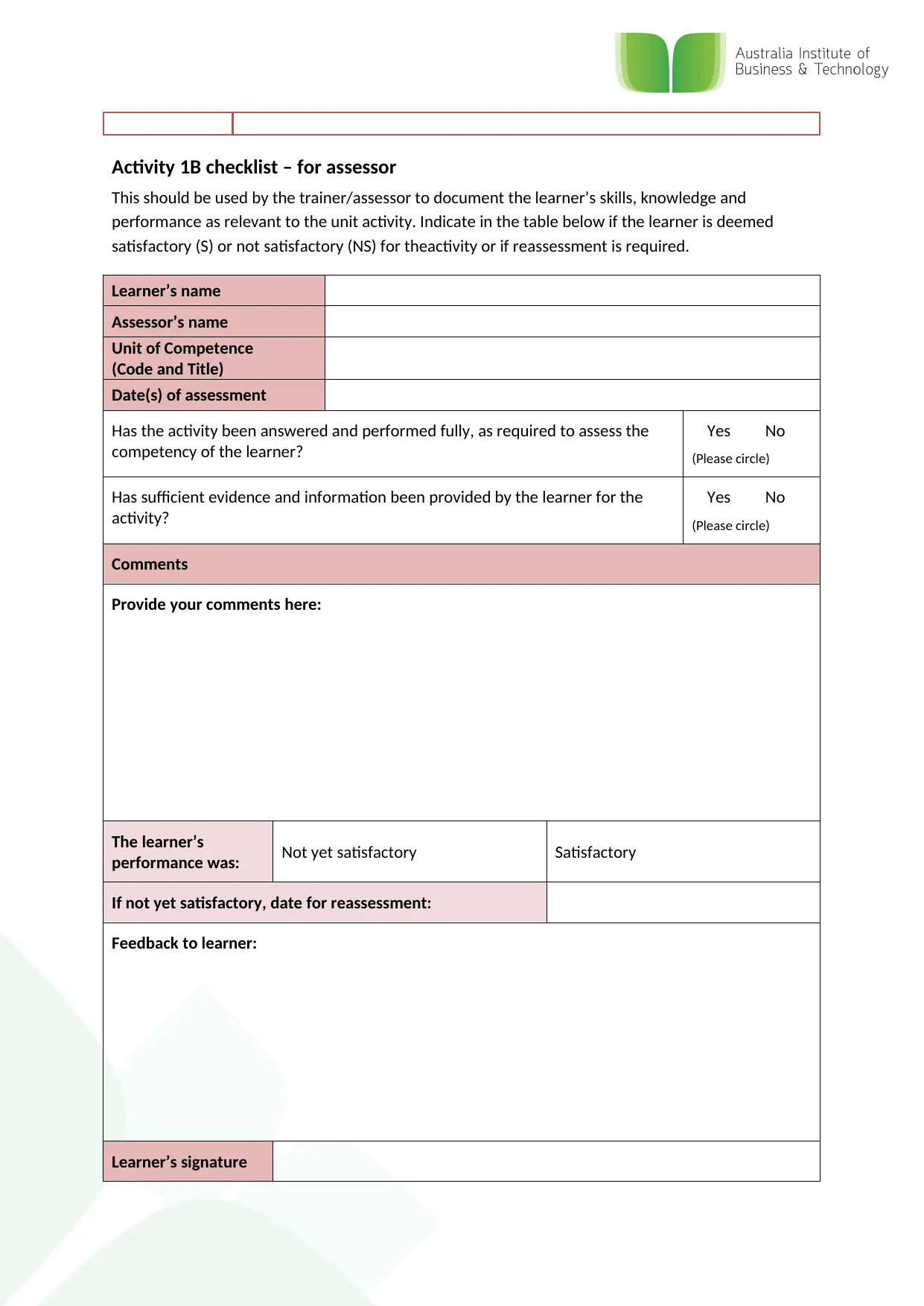
This should be used by the trainer/assessor to document the learner’s skills, knowledge and
performance as relevant to the unit activity. Indicate in the table below if the learner is deemed
satisfactory (S) or not satisfactory (NS) for theactivity or if reassessment is required.
Learner’s name
Assessor’s name
Unit of Competence
(Code and Title)
Date(s) of assessment
Has the activity been answered and performed fully, as required to assess the
competency of the learner?
Yes No
(Please circle)
Has sufficient evidence and information been provided by the learner for the
activity?
Yes No
(Please circle)
Comments
Provide your comments here:
The learner’s
performance was: Not yet satisfactory Satisfactory
If not yet satisfactory, date for reassessment:
Feedback to learner:
Learner’s signature
⊘ This is a preview!⊘
Do you want full access?
Subscribe today to unlock all pages.

Trusted by 1+ million students worldwide

Activity 1C
Estimated Time 30 Minutes
Objective To provide you with an opportunity to use reflection to support own ability to
work inclusively and with understanding of others
1. What is meant by non-judgemental practice? What values may affect it?
2. Considering your responses to Activities 1A and 1B, write a short 250-word
summary of how you can use the results of your personal reflection to
ensure that your work is inclusive and understanding of others.
1C
This is keeping one's opinion to him or herself and giving the client a chance to tell their
story. It entails the aspect of not interrupting or asking blame question with an honest
interest in understanding what the client is saying. People from different background have
different values and norms and the fact that they did something that is bad in a different
culture it might be ideal for them. It is the responsibility of the caregivers to remain non-
judgemental while dealing with diversity.
Values which affect one remain non-judgmental include personal beliefs, religious beliefs,
the level of knowledge one has, the level of freedom and respect for others. Personal belief
is number one factor affecting non-judgmental practice because ones believe is what makes
up the person. Personal point of view develops from what one believes and as a result if
one is not careful can impose his or her own understanding of others. This translates to one
judging others instead of listening to them carefully which result in the client withholding
vital information and sometimes becoming violent. Religious believes also have been
known to alter practice because have different values governing their religion. As a
healthcare provider, one ought to respect other people religion so as to remain non-
judgemental. Knowledge also affects the ability to remain non-judgemental. Respect
enables the health practitioner to remain non-judgmental while serving his or her clients.
1
Cultural biases hinder offering of high-quality services. Being biased I was not able to
practice without judging my clients. Through the reflection, I learned that I needed to
confront biases through being friendly to my clients so as to be able to deal with them
inclusively. I also venture my time in caring for my clients of different walks of life thus
being able to be culturally competent. Frequent and continuously asking for feedback and
rehearsing giving health message to my clients have enabled me to improve my skills. The
ability to listen keenly to my clients also allows me to understand my clients and therefore
being able to serve them best. I have also learned about treating the client with respect to
remaining non-judgmental. This is through encouraging them to give their point of view
without me adding my point of view which hinders the process of service delivery. When
client are handled with a nun-judgmental approach they share essential information thus
enabling me to help them better. Initially I was faced with a challenge due to my belief,
where I would interrupt the client or judge them to know something and as a result, the
client would be hostile and uncooperative. The ultimate outcome for this was delivery of
low-quality care and from my side feeling unsatisfied with the care I offered. In conclusion,
a health care provider should practice being non-judgmental, and purpose of confronting
his or her cultural biases so as to be able to understand the client and offer them best care
inclusively.
Paraphrase This Document
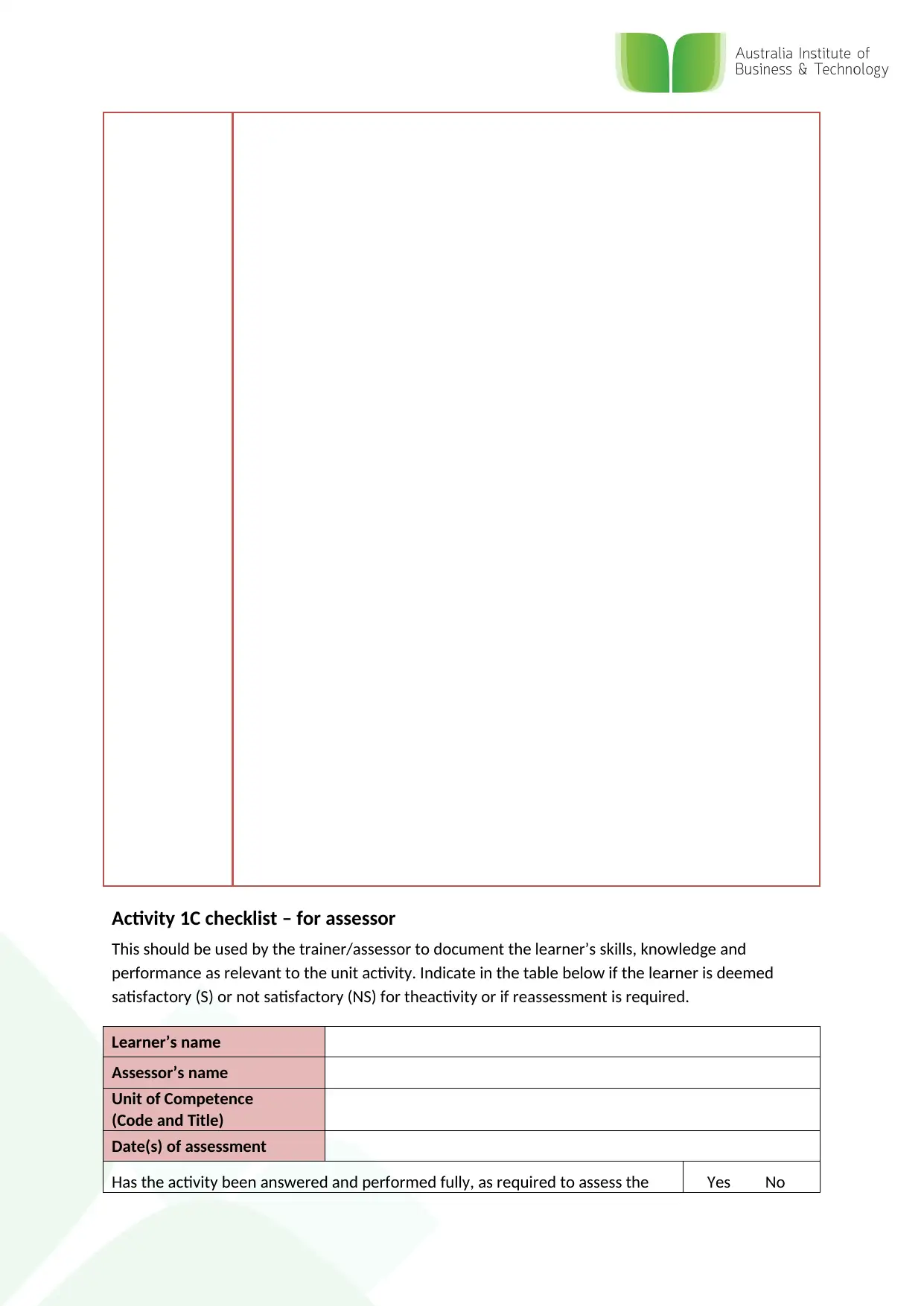
This should be used by the trainer/assessor to document the learner’s skills, knowledge and
performance as relevant to the unit activity. Indicate in the table below if the learner is deemed
satisfactory (S) or not satisfactory (NS) for theactivity or if reassessment is required.
Learner’s name
Assessor’s name
Unit of Competence
(Code and Title)
Date(s) of assessment
Has the activity been answered and performed fully, as required to assess the Yes No
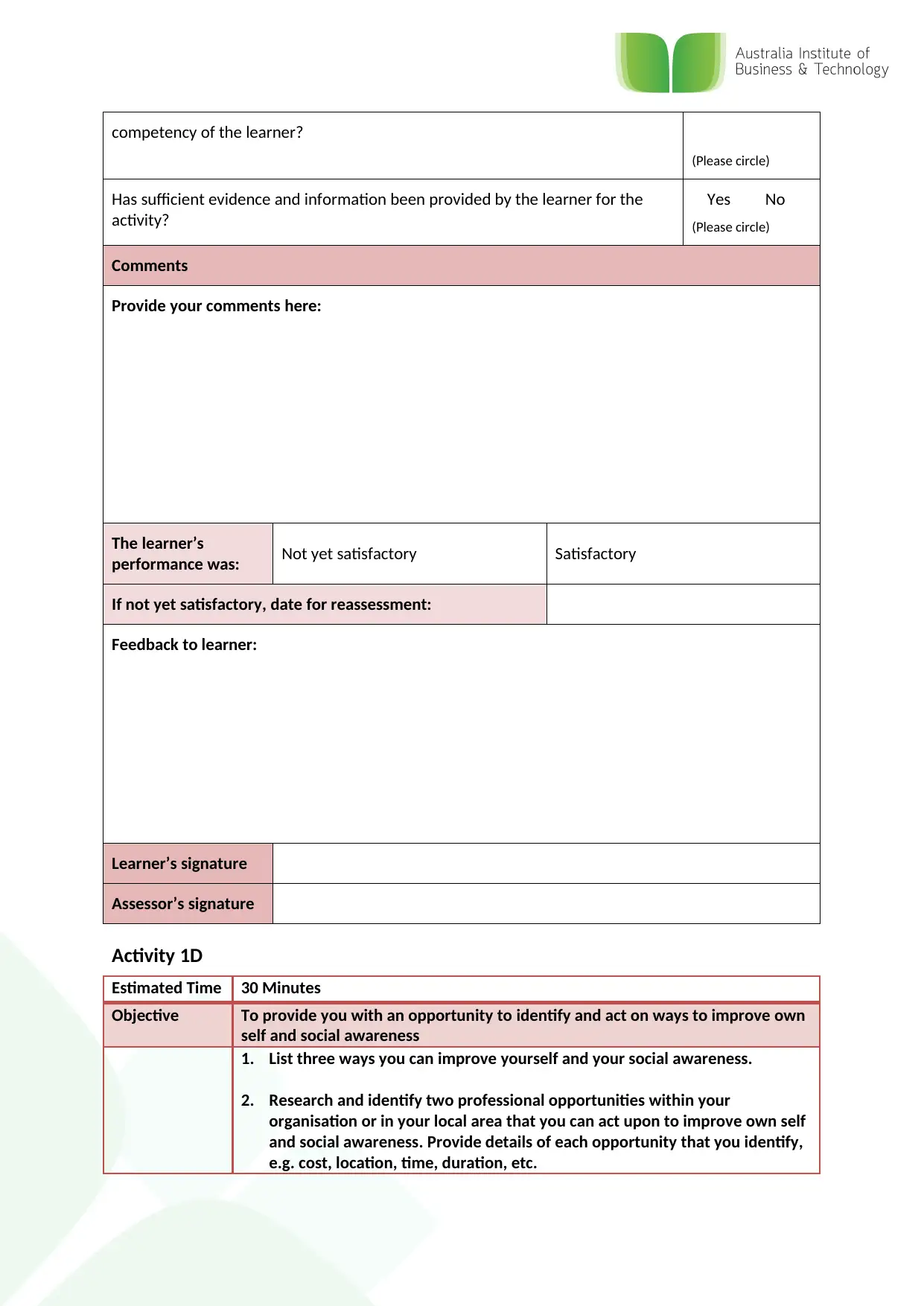
(Please circle)
Has sufficient evidence and information been provided by the learner for the
activity?
Yes No
(Please circle)
Comments
Provide your comments here:
The learner’s
performance was: Not yet satisfactory Satisfactory
If not yet satisfactory, date for reassessment:
Feedback to learner:
Learner’s signature
Assessor’s signature
Activity 1D
Estimated Time 30 Minutes
Objective To provide you with an opportunity to identify and act on ways to improve own
self and social awareness
1. List three ways you can improve yourself and your social awareness.
2. Research and identify two professional opportunities within your
organisation or in your local area that you can act upon to improve own self
and social awareness. Provide details of each opportunity that you identify,
e.g. cost, location, time, duration, etc.
⊘ This is a preview!⊘
Do you want full access?
Subscribe today to unlock all pages.

Trusted by 1+ million students worldwide
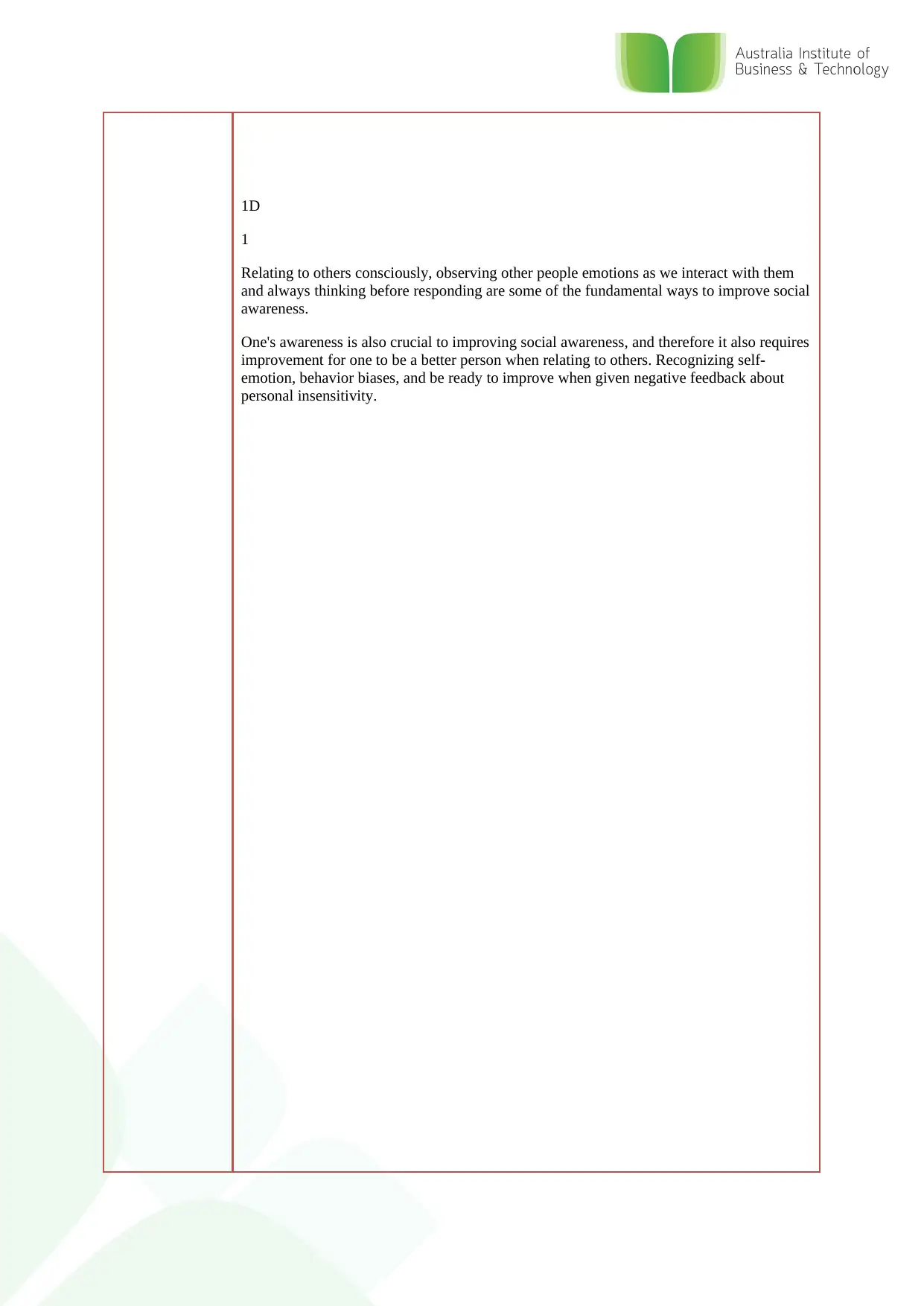
1
Relating to others consciously, observing other people emotions as we interact with them
and always thinking before responding are some of the fundamental ways to improve social
awareness.
One's awareness is also crucial to improving social awareness, and therefore it also requires
improvement for one to be a better person when relating to others. Recognizing self-
emotion, behavior biases, and be ready to improve when given negative feedback about
personal insensitivity.
Paraphrase This Document
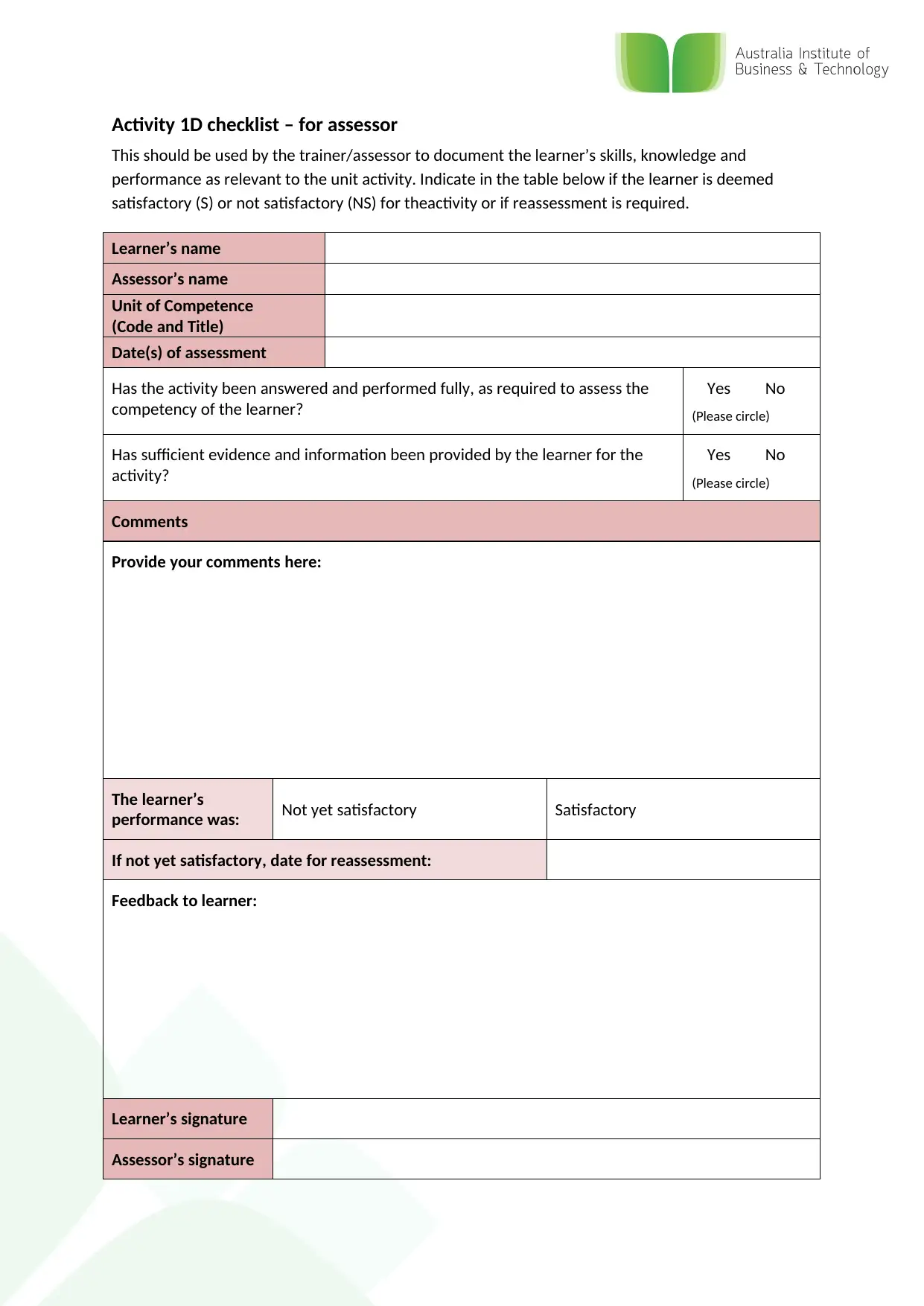
This should be used by the trainer/assessor to document the learner’s skills, knowledge and
performance as relevant to the unit activity. Indicate in the table below if the learner is deemed
satisfactory (S) or not satisfactory (NS) for theactivity or if reassessment is required.
Learner’s name
Assessor’s name
Unit of Competence
(Code and Title)
Date(s) of assessment
Has the activity been answered and performed fully, as required to assess the
competency of the learner?
Yes No
(Please circle)
Has sufficient evidence and information been provided by the learner for the
activity?
Yes No
(Please circle)
Comments
Provide your comments here:
The learner’s
performance was: Not yet satisfactory Satisfactory
If not yet satisfactory, date for reassessment:
Feedback to learner:
Learner’s signature
Assessor’s signature
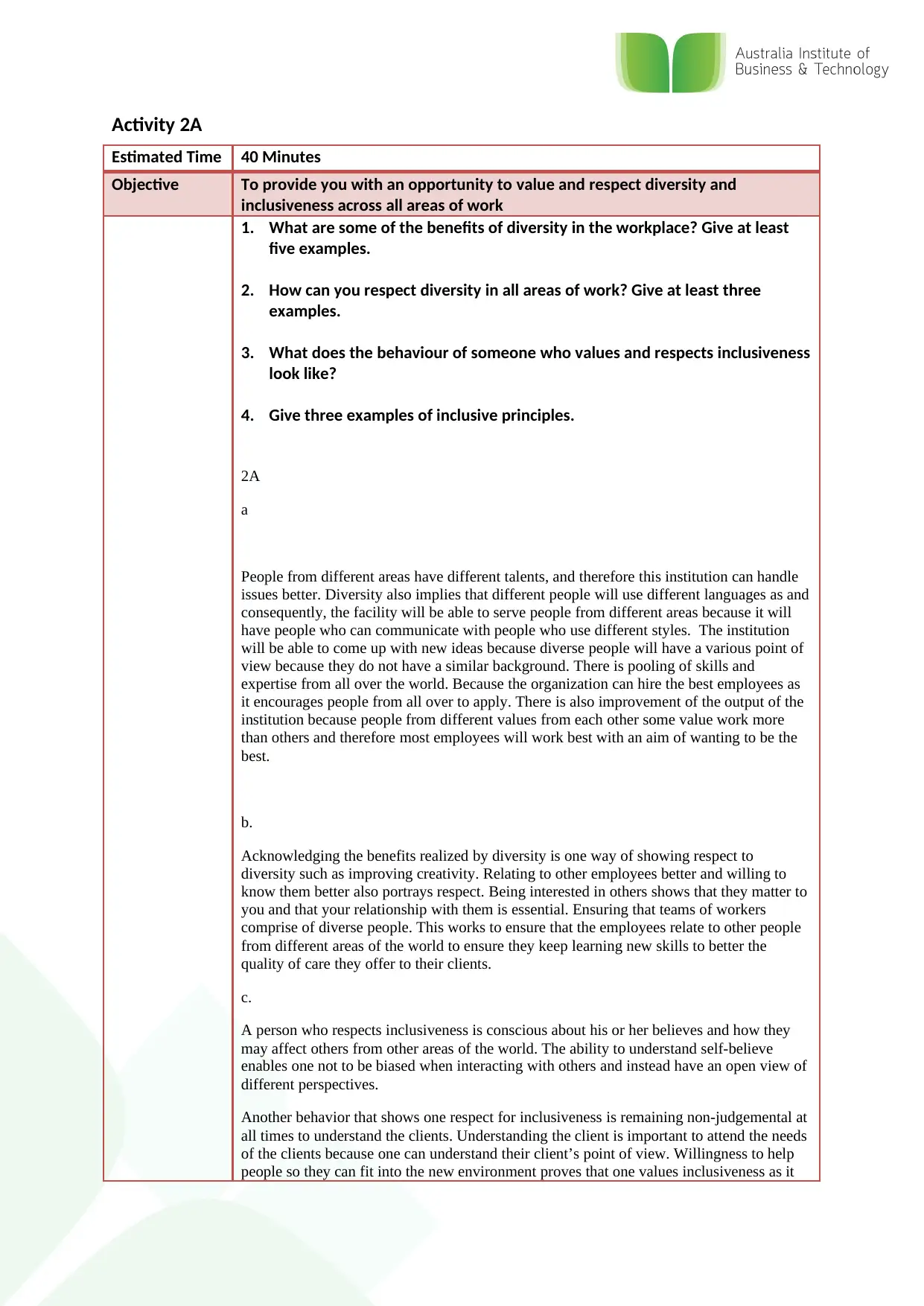
Estimated Time 40 Minutes
Objective To provide you with an opportunity to value and respect diversity and
inclusiveness across all areas of work
1. What are some of the benefits of diversity in the workplace? Give at least
five examples.
2. How can you respect diversity in all areas of work? Give at least three
examples.
3. What does the behaviour of someone who values and respects inclusiveness
look like?
4. Give three examples of inclusive principles.
2A
a
People from different areas have different talents, and therefore this institution can handle
issues better. Diversity also implies that different people will use different languages as and
consequently, the facility will be able to serve people from different areas because it will
have people who can communicate with people who use different styles. The institution
will be able to come up with new ideas because diverse people will have a various point of
view because they do not have a similar background. There is pooling of skills and
expertise from all over the world. Because the organization can hire the best employees as
it encourages people from all over to apply. There is also improvement of the output of the
institution because people from different values from each other some value work more
than others and therefore most employees will work best with an aim of wanting to be the
best.
b.
Acknowledging the benefits realized by diversity is one way of showing respect to
diversity such as improving creativity. Relating to other employees better and willing to
know them better also portrays respect. Being interested in others shows that they matter to
you and that your relationship with them is essential. Ensuring that teams of workers
comprise of diverse people. This works to ensure that the employees relate to other people
from different areas of the world to ensure they keep learning new skills to better the
quality of care they offer to their clients.
c.
A person who respects inclusiveness is conscious about his or her believes and how they
may affect others from other areas of the world. The ability to understand self-believe
enables one not to be biased when interacting with others and instead have an open view of
different perspectives.
Another behavior that shows one respect for inclusiveness is remaining non-judgemental at
all times to understand the clients. Understanding the client is important to attend the needs
of the clients because one can understand their client’s point of view. Willingness to help
people so they can fit into the new environment proves that one values inclusiveness as it
⊘ This is a preview!⊘
Do you want full access?
Subscribe today to unlock all pages.

Trusted by 1+ million students worldwide
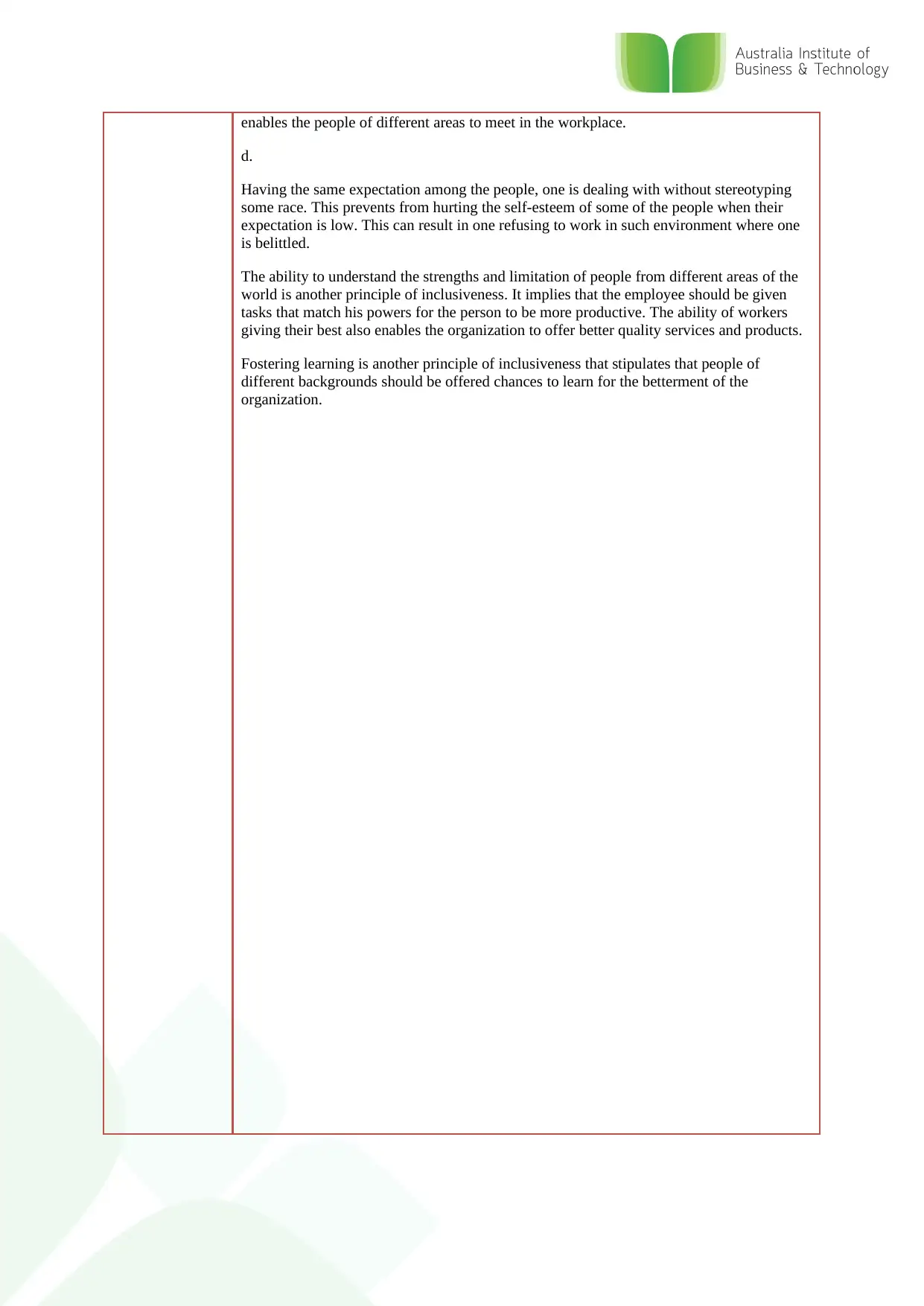
d.
Having the same expectation among the people, one is dealing with without stereotyping
some race. This prevents from hurting the self-esteem of some of the people when their
expectation is low. This can result in one refusing to work in such environment where one
is belittled.
The ability to understand the strengths and limitation of people from different areas of the
world is another principle of inclusiveness. It implies that the employee should be given
tasks that match his powers for the person to be more productive. The ability of workers
giving their best also enables the organization to offer better quality services and products.
Fostering learning is another principle of inclusiveness that stipulates that people of
different backgrounds should be offered chances to learn for the betterment of the
organization.
Paraphrase This Document
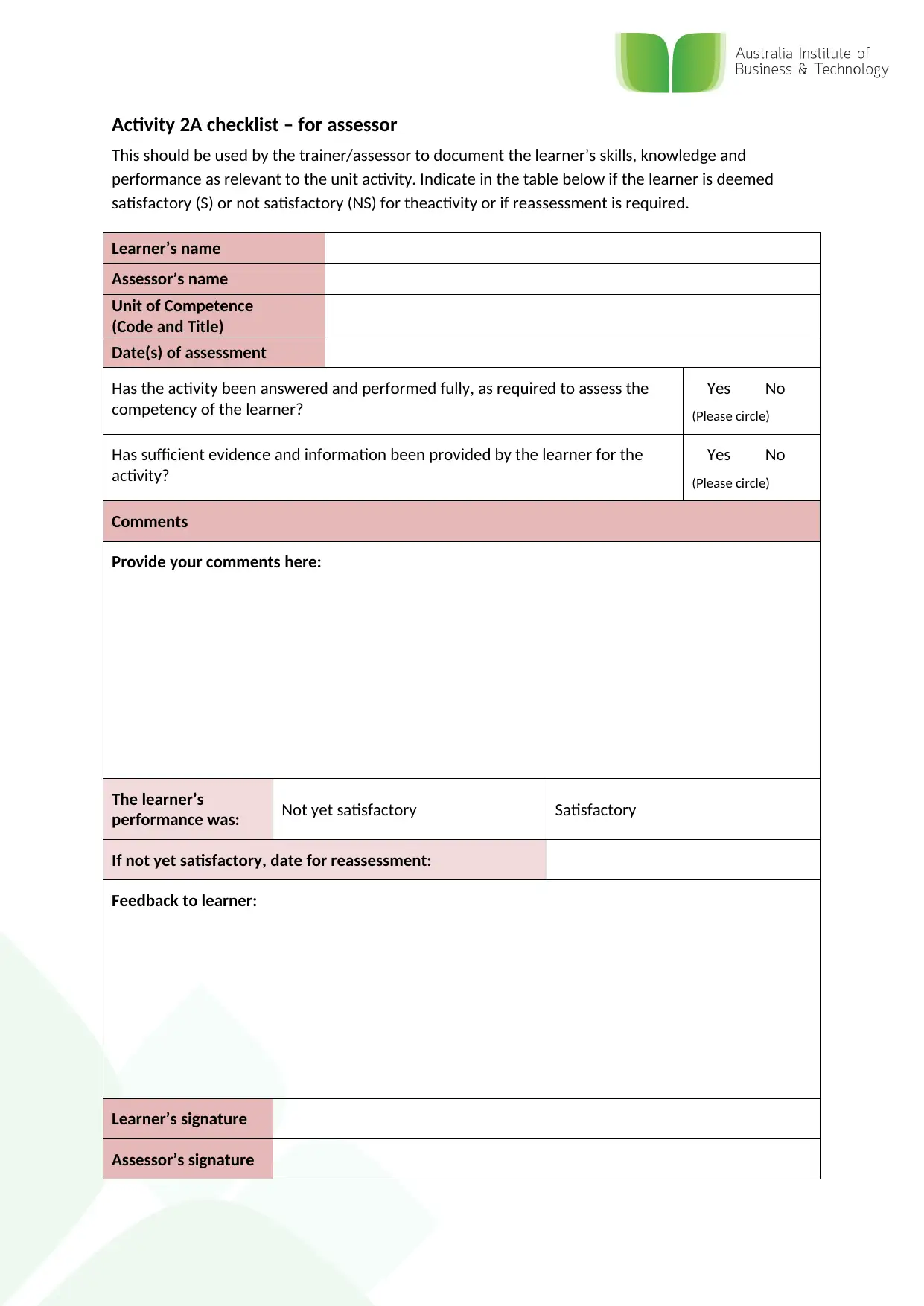
This should be used by the trainer/assessor to document the learner’s skills, knowledge and
performance as relevant to the unit activity. Indicate in the table below if the learner is deemed
satisfactory (S) or not satisfactory (NS) for theactivity or if reassessment is required.
Learner’s name
Assessor’s name
Unit of Competence
(Code and Title)
Date(s) of assessment
Has the activity been answered and performed fully, as required to assess the
competency of the learner?
Yes No
(Please circle)
Has sufficient evidence and information been provided by the learner for the
activity?
Yes No
(Please circle)
Comments
Provide your comments here:
The learner’s
performance was: Not yet satisfactory Satisfactory
If not yet satisfactory, date for reassessment:
Feedback to learner:
Learner’s signature
Assessor’s signature
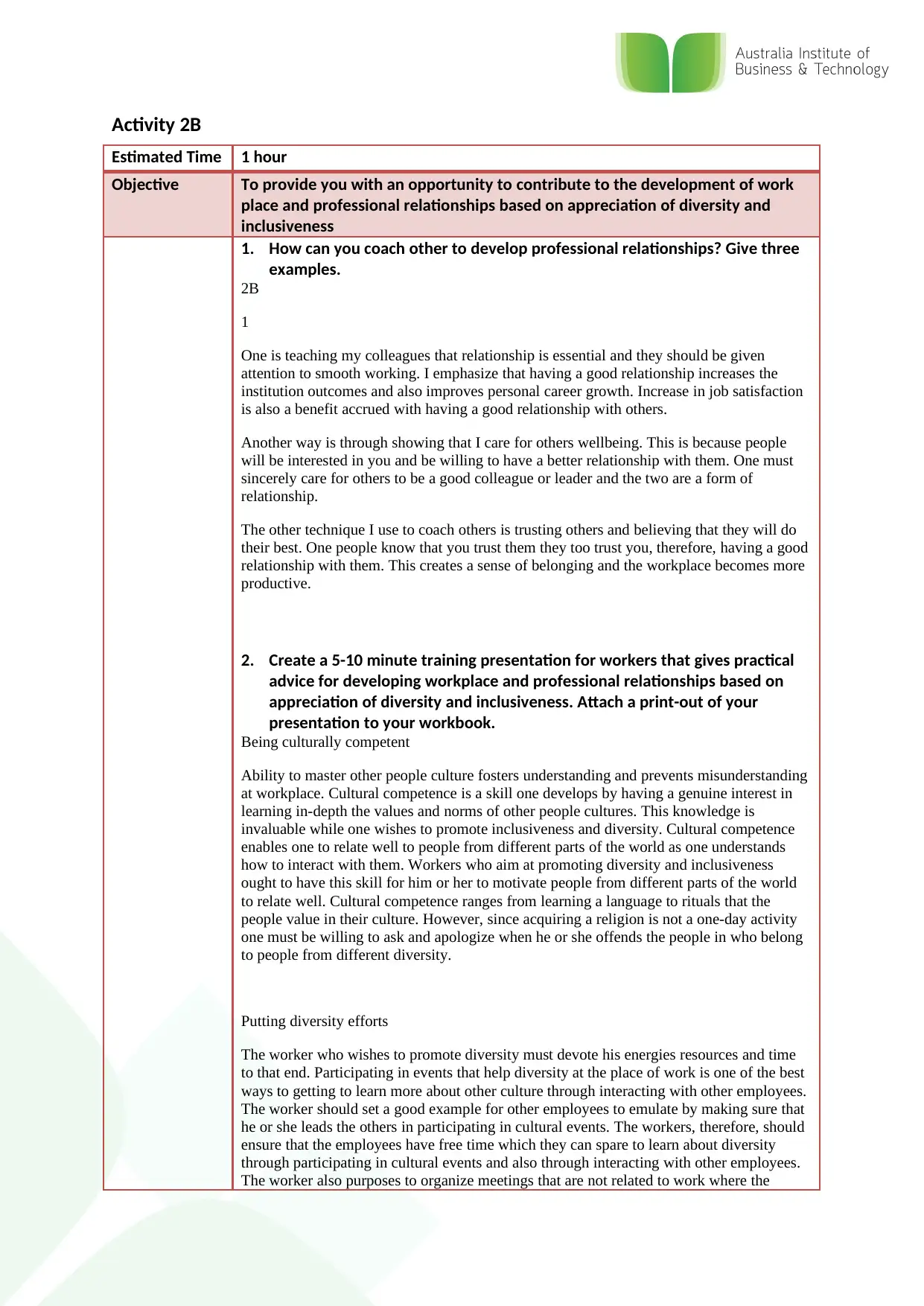
Estimated Time 1 hour
Objective To provide you with an opportunity to contribute to the development of work
place and professional relationships based on appreciation of diversity and
inclusiveness
1. How can you coach other to develop professional relationships? Give three
examples.
2B
1
One is teaching my colleagues that relationship is essential and they should be given
attention to smooth working. I emphasize that having a good relationship increases the
institution outcomes and also improves personal career growth. Increase in job satisfaction
is also a benefit accrued with having a good relationship with others.
Another way is through showing that I care for others wellbeing. This is because people
will be interested in you and be willing to have a better relationship with them. One must
sincerely care for others to be a good colleague or leader and the two are a form of
relationship.
The other technique I use to coach others is trusting others and believing that they will do
their best. One people know that you trust them they too trust you, therefore, having a good
relationship with them. This creates a sense of belonging and the workplace becomes more
productive.
2. Create a 5-10 minute training presentation for workers that gives practical
advice for developing workplace and professional relationships based on
appreciation of diversity and inclusiveness. Attach a print-out of your
presentation to your workbook.
Being culturally competent
Ability to master other people culture fosters understanding and prevents misunderstanding
at workplace. Cultural competence is a skill one develops by having a genuine interest in
learning in-depth the values and norms of other people cultures. This knowledge is
invaluable while one wishes to promote inclusiveness and diversity. Cultural competence
enables one to relate well to people from different parts of the world as one understands
how to interact with them. Workers who aim at promoting diversity and inclusiveness
ought to have this skill for him or her to motivate people from different parts of the world
to relate well. Cultural competence ranges from learning a language to rituals that the
people value in their culture. However, since acquiring a religion is not a one-day activity
one must be willing to ask and apologize when he or she offends the people in who belong
to people from different diversity.
Putting diversity efforts
The worker who wishes to promote diversity must devote his energies resources and time
to that end. Participating in events that help diversity at the place of work is one of the best
ways to getting to learn more about other culture through interacting with other employees.
The worker should set a good example for other employees to emulate by making sure that
he or she leads the others in participating in cultural events. The workers, therefore, should
ensure that the employees have free time which they can spare to learn about diversity
through participating in cultural events and also through interacting with other employees.
The worker also purposes to organize meetings that are not related to work where the
⊘ This is a preview!⊘
Do you want full access?
Subscribe today to unlock all pages.

Trusted by 1+ million students worldwide
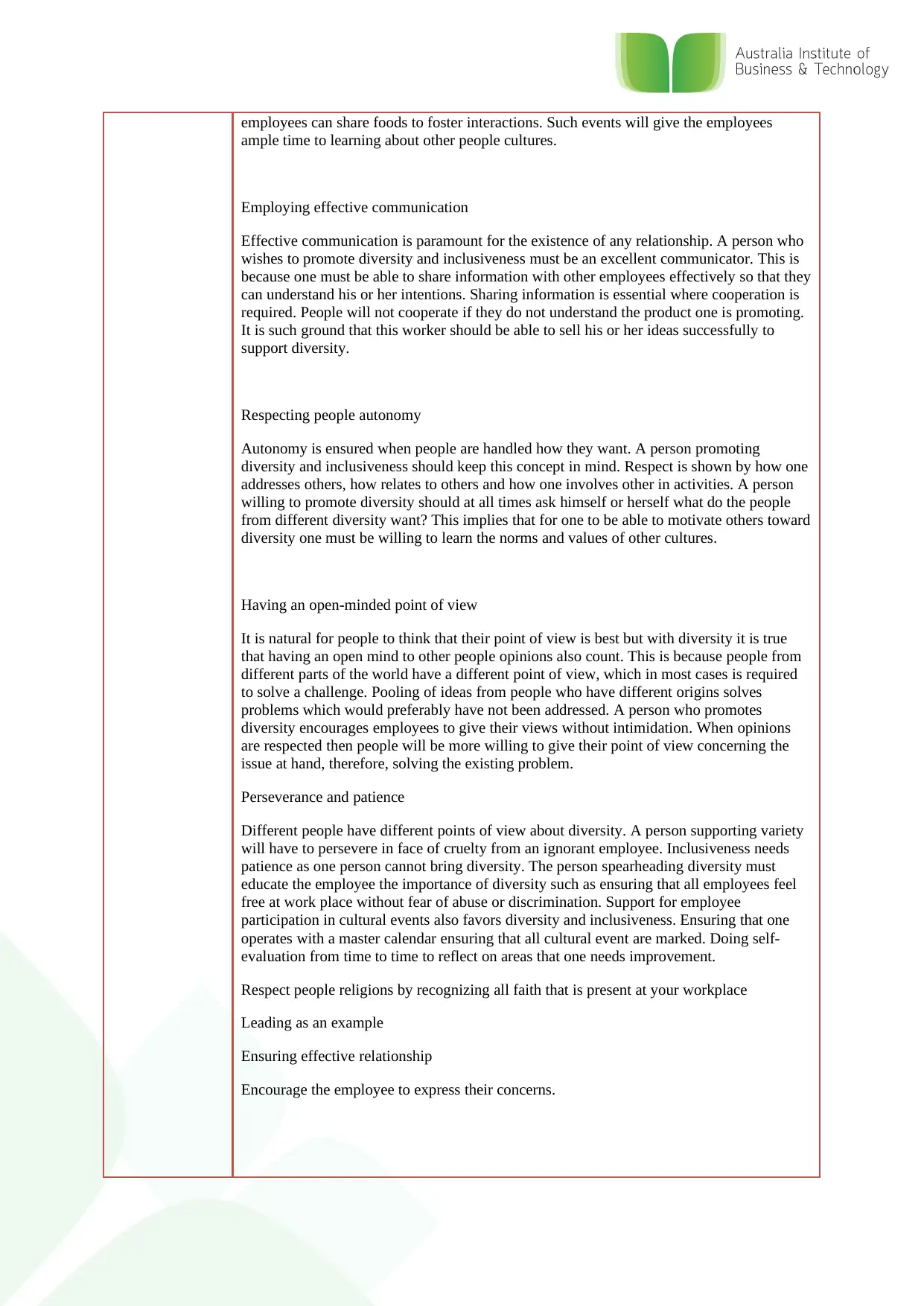
ample time to learning about other people cultures.
Employing effective communication
Effective communication is paramount for the existence of any relationship. A person who
wishes to promote diversity and inclusiveness must be an excellent communicator. This is
because one must be able to share information with other employees effectively so that they
can understand his or her intentions. Sharing information is essential where cooperation is
required. People will not cooperate if they do not understand the product one is promoting.
It is such ground that this worker should be able to sell his or her ideas successfully to
support diversity.
Respecting people autonomy
Autonomy is ensured when people are handled how they want. A person promoting
diversity and inclusiveness should keep this concept in mind. Respect is shown by how one
addresses others, how relates to others and how one involves other in activities. A person
willing to promote diversity should at all times ask himself or herself what do the people
from different diversity want? This implies that for one to be able to motivate others toward
diversity one must be willing to learn the norms and values of other cultures.
Having an open-minded point of view
It is natural for people to think that their point of view is best but with diversity it is true
that having an open mind to other people opinions also count. This is because people from
different parts of the world have a different point of view, which in most cases is required
to solve a challenge. Pooling of ideas from people who have different origins solves
problems which would preferably have not been addressed. A person who promotes
diversity encourages employees to give their views without intimidation. When opinions
are respected then people will be more willing to give their point of view concerning the
issue at hand, therefore, solving the existing problem.
Perseverance and patience
Different people have different points of view about diversity. A person supporting variety
will have to persevere in face of cruelty from an ignorant employee. Inclusiveness needs
patience as one person cannot bring diversity. The person spearheading diversity must
educate the employee the importance of diversity such as ensuring that all employees feel
free at work place without fear of abuse or discrimination. Support for employee
participation in cultural events also favors diversity and inclusiveness. Ensuring that one
operates with a master calendar ensuring that all cultural event are marked. Doing self-
evaluation from time to time to reflect on areas that one needs improvement.
Respect people religions by recognizing all faith that is present at your workplace
Leading as an example
Ensuring effective relationship
Encourage the employee to express their concerns.
Paraphrase This Document

This should be used by the trainer/assessor to document the learner’s skills, knowledge and
performance as relevant to the unit activity. Indicate in the table below if the learner is deemed
satisfactory (S) or not satisfactory (NS) for theactivity or if reassessment is required.
Learner’s name
Assessor’s name
Unit of Competence
(Code and Title)
Date(s) of assessment
Has the activity been answered and performed fully, as required to assess the
competency of the learner?
Yes No
(Please circle)
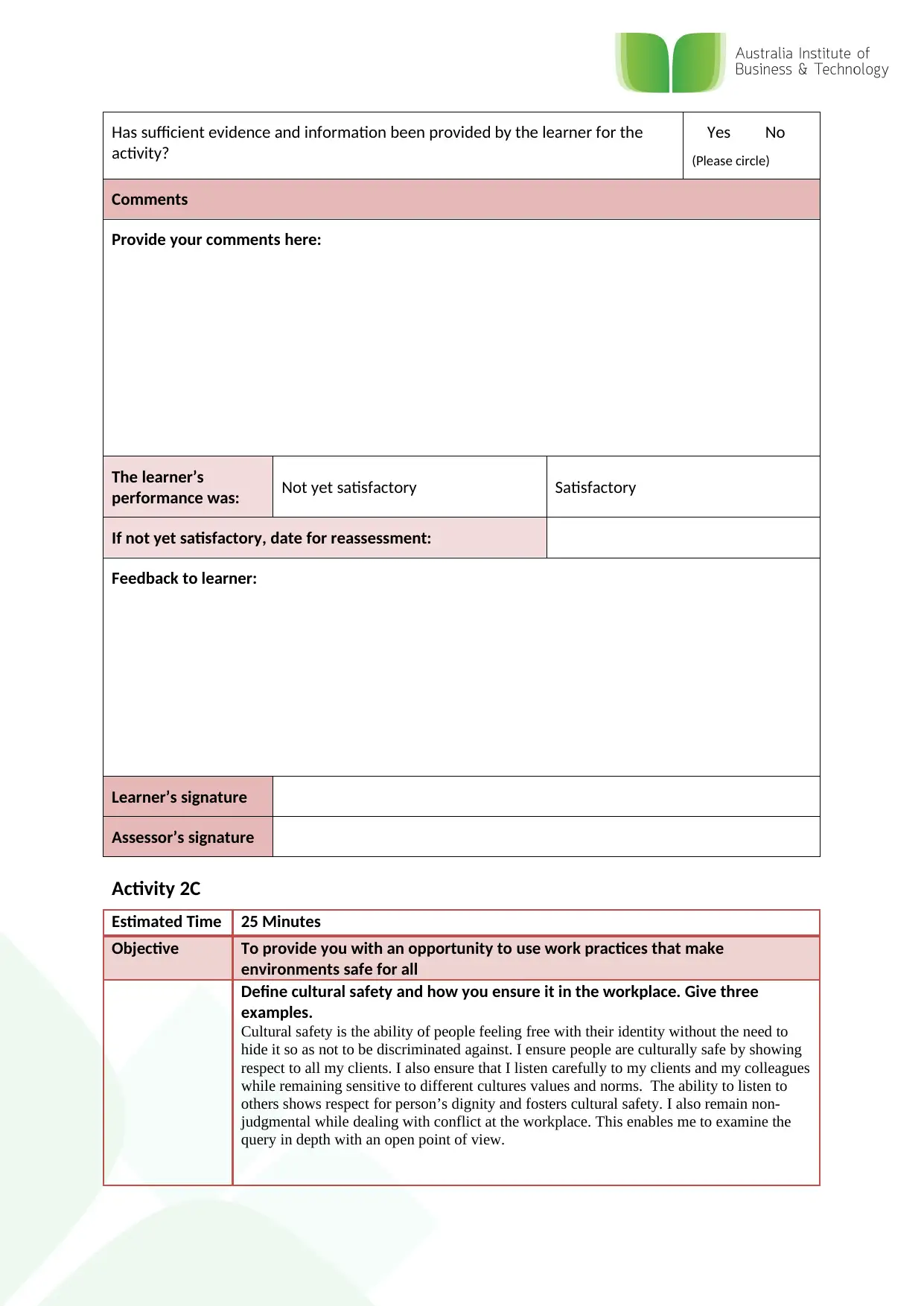
activity?
Yes No
(Please circle)
Comments
Provide your comments here:
The learner’s
performance was: Not yet satisfactory Satisfactory
If not yet satisfactory, date for reassessment:
Feedback to learner:
Learner’s signature
Assessor’s signature
Activity 2C
Estimated Time 25 Minutes
Objective To provide you with an opportunity to use work practices that make
environments safe for all
Define cultural safety and how you ensure it in the workplace. Give three
examples.
Cultural safety is the ability of people feeling free with their identity without the need to
hide it so as not to be discriminated against. I ensure people are culturally safe by showing
respect to all my clients. I also ensure that I listen carefully to my clients and my colleagues
while remaining sensitive to different cultures values and norms. The ability to listen to
others shows respect for person’s dignity and fosters cultural safety. I also remain non-
judgmental while dealing with conflict at the workplace. This enables me to examine the
query in depth with an open point of view.
⊘ This is a preview!⊘
Do you want full access?
Subscribe today to unlock all pages.

Trusted by 1+ million students worldwide
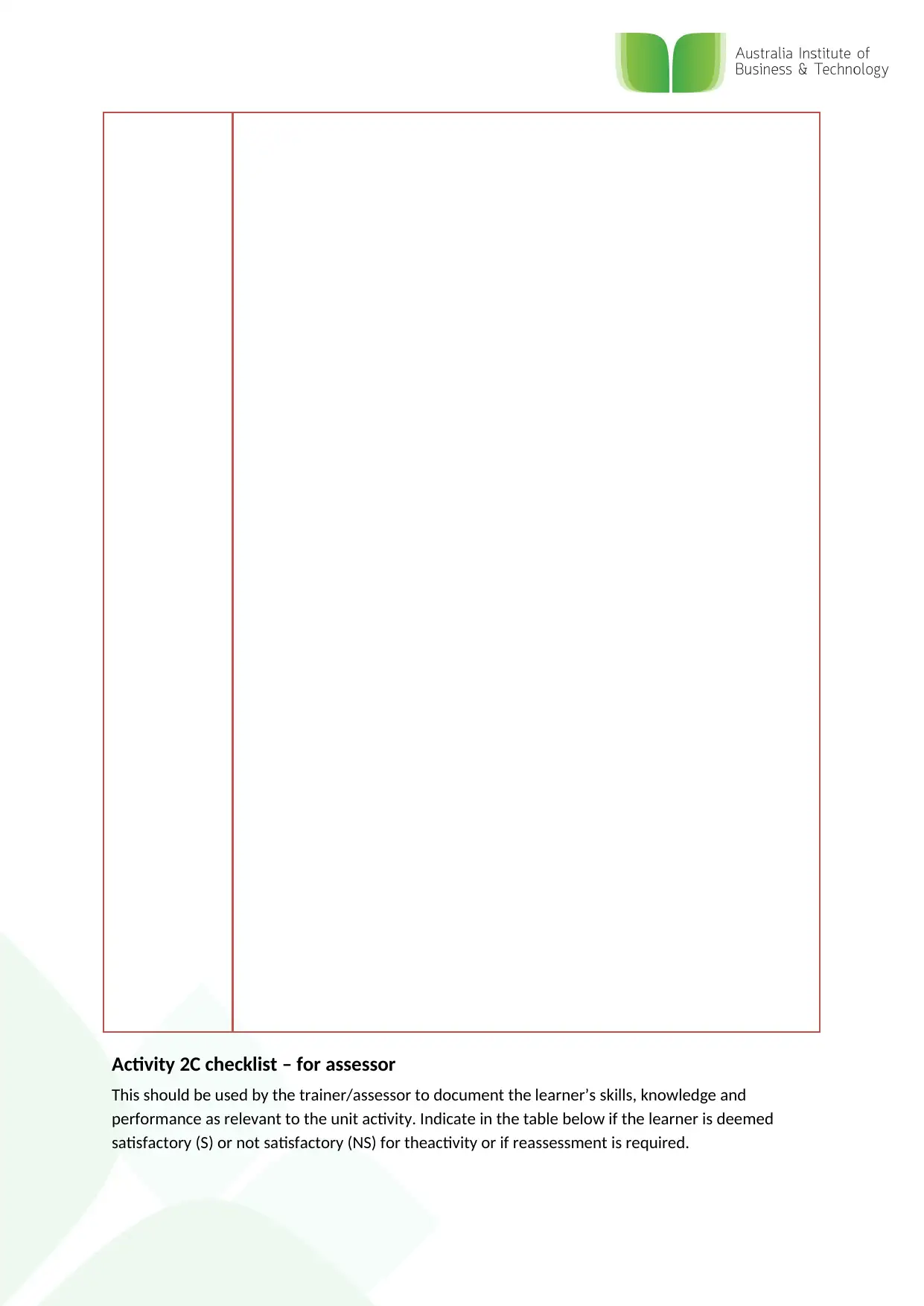
This should be used by the trainer/assessor to document the learner’s skills, knowledge and
performance as relevant to the unit activity. Indicate in the table below if the learner is deemed
satisfactory (S) or not satisfactory (NS) for theactivity or if reassessment is required.
Paraphrase This Document
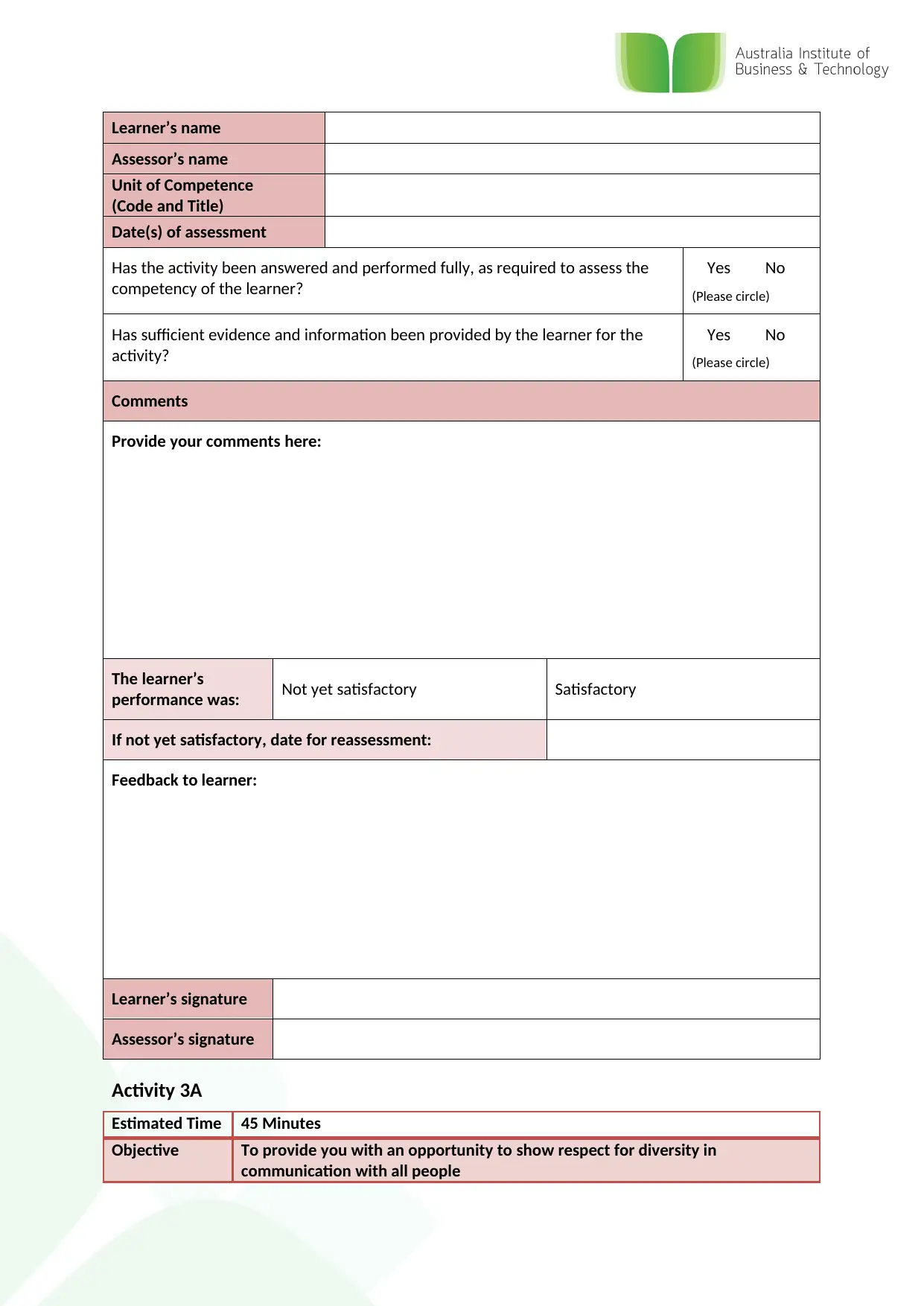
Assessor’s name
Unit of Competence
(Code and Title)
Date(s) of assessment
Has the activity been answered and performed fully, as required to assess the
competency of the learner?
Yes No
(Please circle)
Has sufficient evidence and information been provided by the learner for the
activity?
Yes No
(Please circle)
Comments
Provide your comments here:
The learner’s
performance was: Not yet satisfactory Satisfactory
If not yet satisfactory, date for reassessment:
Feedback to learner:
Learner’s signature
Assessor’s signature
Activity 3A
Estimated Time 45 Minutes
Objective To provide you with an opportunity to show respect for diversity in
communication with all people
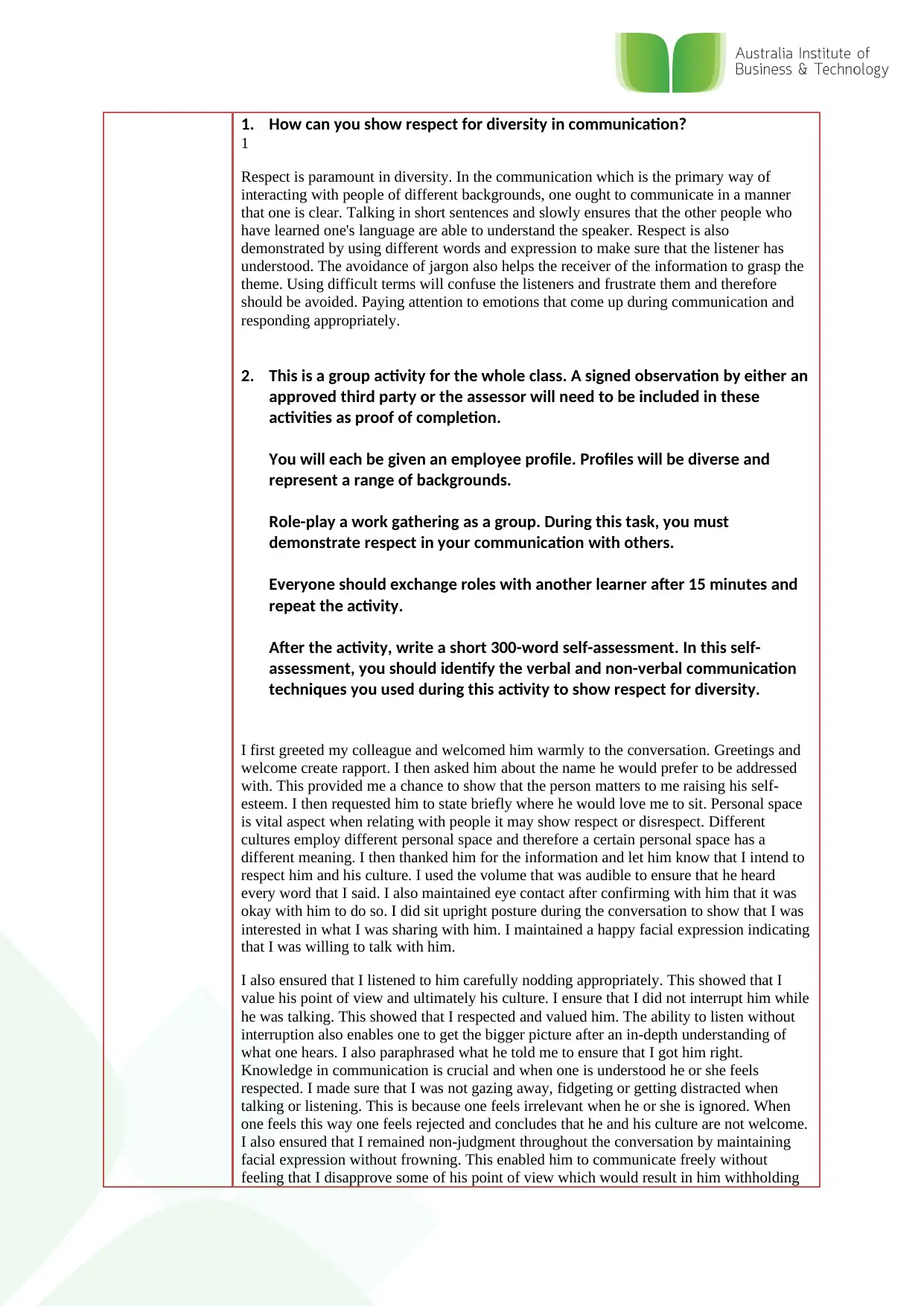
1
Respect is paramount in diversity. In the communication which is the primary way of
interacting with people of different backgrounds, one ought to communicate in a manner
that one is clear. Talking in short sentences and slowly ensures that the other people who
have learned one's language are able to understand the speaker. Respect is also
demonstrated by using different words and expression to make sure that the listener has
understood. The avoidance of jargon also helps the receiver of the information to grasp the
theme. Using difficult terms will confuse the listeners and frustrate them and therefore
should be avoided. Paying attention to emotions that come up during communication and
responding appropriately.
2. This is a group activity for the whole class. A signed observation by either an
approved third party or the assessor will need to be included in these
activities as proof of completion.
You will each be given an employee profile. Profiles will be diverse and
represent a range of backgrounds.
Role-play a work gathering as a group. During this task, you must
demonstrate respect in your communication with others.
Everyone should exchange roles with another learner after 15 minutes and
repeat the activity.
After the activity, write a short 300-word self-assessment. In this self-
assessment, you should identify the verbal and non-verbal communication
techniques you used during this activity to show respect for diversity.
I first greeted my colleague and welcomed him warmly to the conversation. Greetings and
welcome create rapport. I then asked him about the name he would prefer to be addressed
with. This provided me a chance to show that the person matters to me raising his self-
esteem. I then requested him to state briefly where he would love me to sit. Personal space
is vital aspect when relating with people it may show respect or disrespect. Different
cultures employ different personal space and therefore a certain personal space has a
different meaning. I then thanked him for the information and let him know that I intend to
respect him and his culture. I used the volume that was audible to ensure that he heard
every word that I said. I also maintained eye contact after confirming with him that it was
okay with him to do so. I did sit upright posture during the conversation to show that I was
interested in what I was sharing with him. I maintained a happy facial expression indicating
that I was willing to talk with him.
I also ensured that I listened to him carefully nodding appropriately. This showed that I
value his point of view and ultimately his culture. I ensure that I did not interrupt him while
he was talking. This showed that I respected and valued him. The ability to listen without
interruption also enables one to get the bigger picture after an in-depth understanding of
what one hears. I also paraphrased what he told me to ensure that I got him right.
Knowledge in communication is crucial and when one is understood he or she feels
respected. I made sure that I was not gazing away, fidgeting or getting distracted when
talking or listening. This is because one feels irrelevant when he or she is ignored. When
one feels this way one feels rejected and concludes that he and his culture are not welcome.
I also ensured that I remained non-judgment throughout the conversation by maintaining
facial expression without frowning. This enabled him to communicate freely without
feeling that I disapprove some of his point of view which would result in him withholding
⊘ This is a preview!⊘
Do you want full access?
Subscribe today to unlock all pages.

Trusted by 1+ million students worldwide
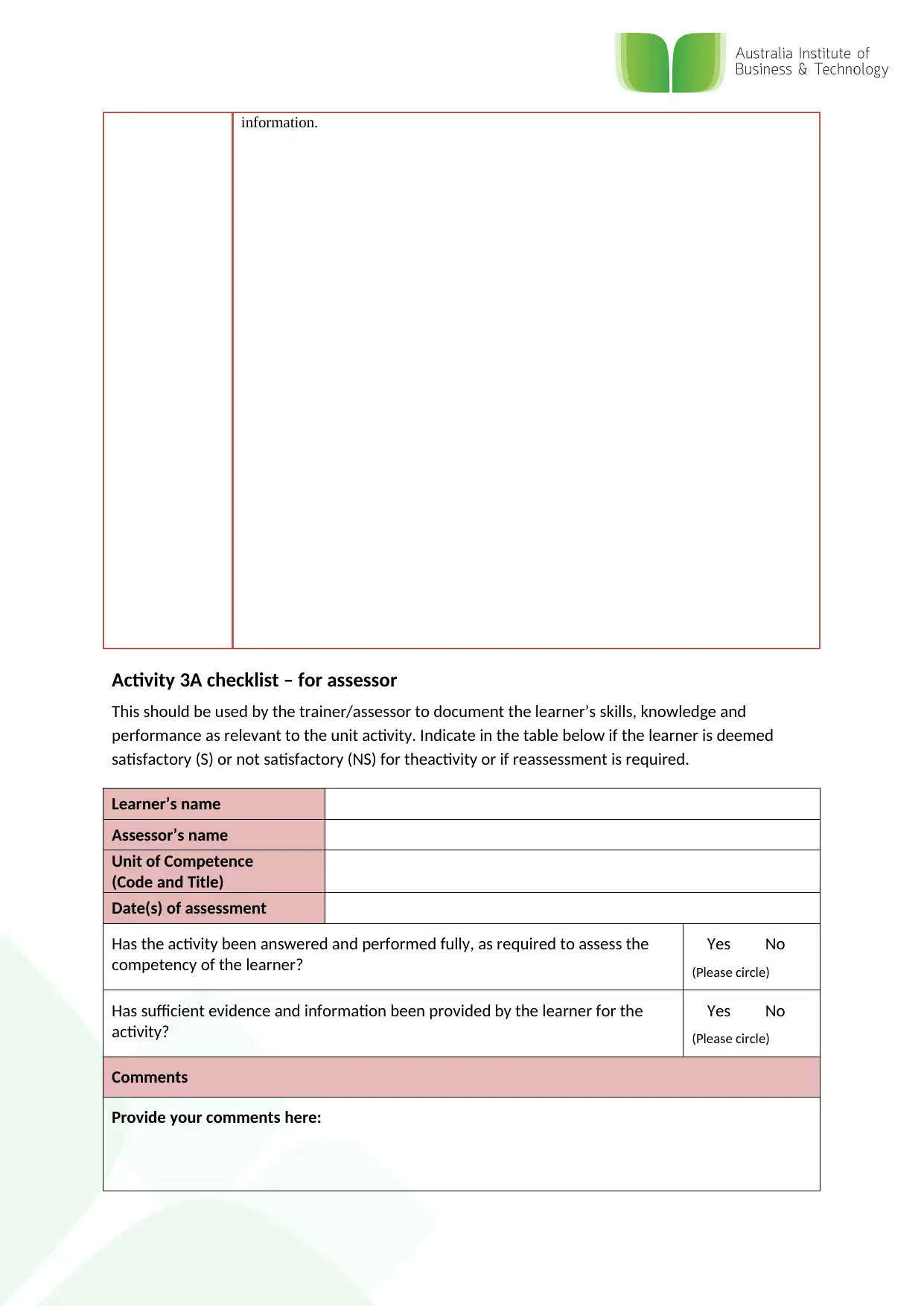
Activity 3A checklist – for assessor
This should be used by the trainer/assessor to document the learner’s skills, knowledge and
performance as relevant to the unit activity. Indicate in the table below if the learner is deemed
satisfactory (S) or not satisfactory (NS) for theactivity or if reassessment is required.
Learner’s name
Assessor’s name
Unit of Competence
(Code and Title)
Date(s) of assessment
Has the activity been answered and performed fully, as required to assess the
competency of the learner?
Yes No
(Please circle)
Has sufficient evidence and information been provided by the learner for the
activity?
Yes No
(Please circle)
Comments
Provide your comments here:
Paraphrase This Document

performance was: Not yet satisfactory Satisfactory
If not yet satisfactory, date for reassessment:
Feedback to learner:
Learner’s signature
Assessor’s signature
Activity 3B
Estimated Time 30 Minutes
Objective To provide you with an opportunity to use verbal and non-verbal
communication constructively to establish, develop and maintain effective
relationships, mutual trust and confidence
1. Describe three non-verbal communication techniques to maintain
relationships.
Maintaining eye contact is one way of keeping a relationship because it shows that you are
interested in what the other person is telling you. Nodding when agreeing with the other
person is essential as it shows that you are listening to him or her. Maintaining upright
open posture tells the other person that you are interested in what they are saying. People
love people who pay attention to them and therefore the three non-verbal cues are vital for
building a relationship.
2. This is a role-play activity to be conducted in pairs.
With a partner, discuss the following quote from Stephen R. Covey:
‘Strength lies in differences, not in similarities.’
What is your interpretation of this quote? What does it mean? How can it
be applied in work practice?
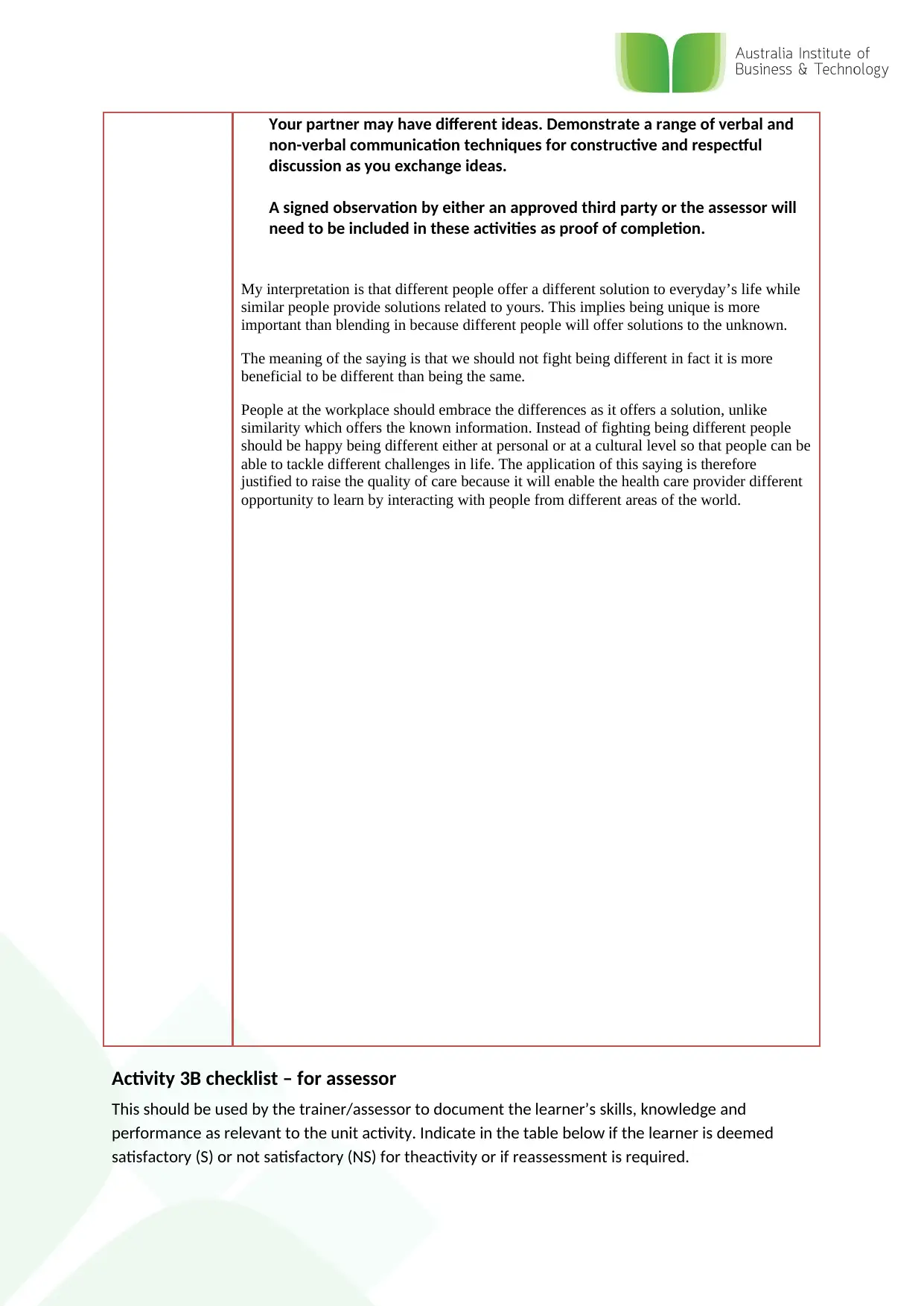
non-verbal communication techniques for constructive and respectful
discussion as you exchange ideas.
A signed observation by either an approved third party or the assessor will
need to be included in these activities as proof of completion.
My interpretation is that different people offer a different solution to everyday’s life while
similar people provide solutions related to yours. This implies being unique is more
important than blending in because different people will offer solutions to the unknown.
The meaning of the saying is that we should not fight being different in fact it is more
beneficial to be different than being the same.
People at the workplace should embrace the differences as it offers a solution, unlike
similarity which offers the known information. Instead of fighting being different people
should be happy being different either at personal or at a cultural level so that people can be
able to tackle different challenges in life. The application of this saying is therefore
justified to raise the quality of care because it will enable the health care provider different
opportunity to learn by interacting with people from different areas of the world.
Activity 3B checklist – for assessor
This should be used by the trainer/assessor to document the learner’s skills, knowledge and
performance as relevant to the unit activity. Indicate in the table below if the learner is deemed
satisfactory (S) or not satisfactory (NS) for theactivity or if reassessment is required.
⊘ This is a preview!⊘
Do you want full access?
Subscribe today to unlock all pages.

Trusted by 1+ million students worldwide
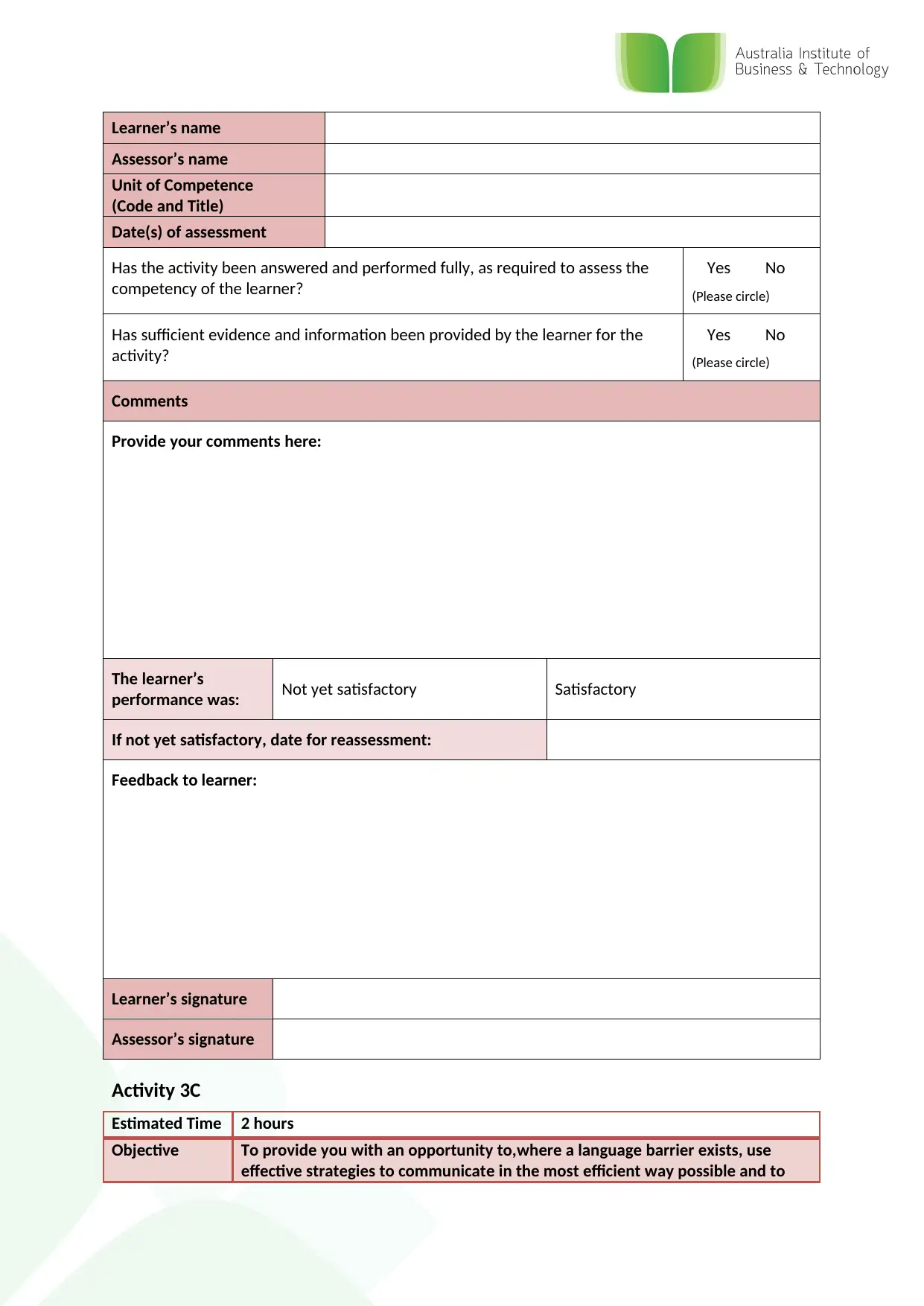
Assessor’s name
Unit of Competence
(Code and Title)
Date(s) of assessment
Has the activity been answered and performed fully, as required to assess the
competency of the learner?
Yes No
(Please circle)
Has sufficient evidence and information been provided by the learner for the
activity?
Yes No
(Please circle)
Comments
Provide your comments here:
The learner’s
performance was: Not yet satisfactory Satisfactory
If not yet satisfactory, date for reassessment:
Feedback to learner:
Learner’s signature
Assessor’s signature
Activity 3C
Estimated Time 2 hours
Objective To provide you with an opportunity to,where a language barrier exists, use
effective strategies to communicate in the most efficient way possible and to
Paraphrase This Document
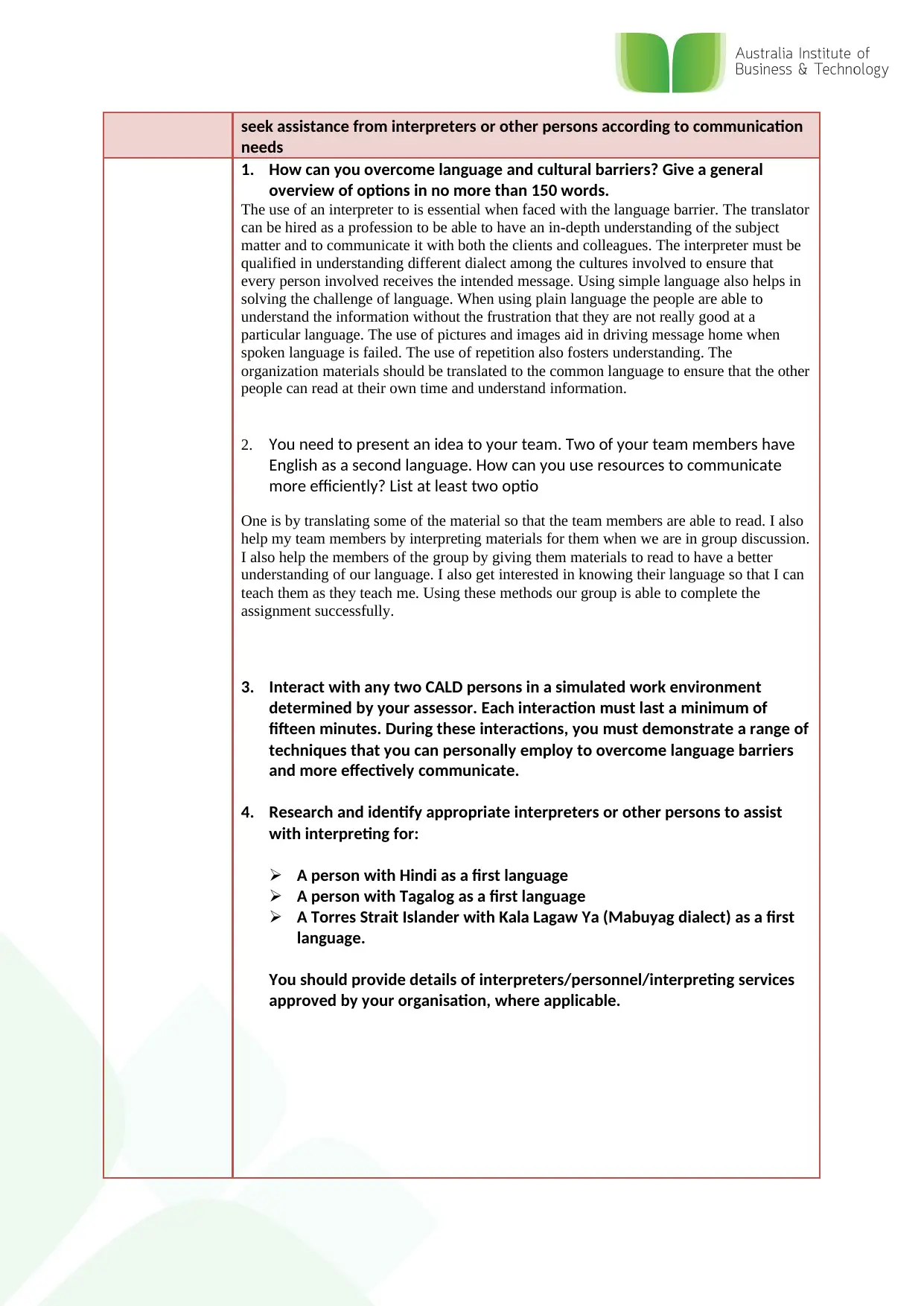
needs
1. How can you overcome language and cultural barriers? Give a general
overview of options in no more than 150 words.
The use of an interpreter to is essential when faced with the language barrier. The translator
can be hired as a profession to be able to have an in-depth understanding of the subject
matter and to communicate it with both the clients and colleagues. The interpreter must be
qualified in understanding different dialect among the cultures involved to ensure that
every person involved receives the intended message. Using simple language also helps in
solving the challenge of language. When using plain language the people are able to
understand the information without the frustration that they are not really good at a
particular language. The use of pictures and images aid in driving message home when
spoken language is failed. The use of repetition also fosters understanding. The
organization materials should be translated to the common language to ensure that the other
people can read at their own time and understand information.
2. You need to present an idea to your team. Two of your team members have
English as a second language. How can you use resources to communicate
more efficiently? List at least two optio
One is by translating some of the material so that the team members are able to read. I also
help my team members by interpreting materials for them when we are in group discussion.
I also help the members of the group by giving them materials to read to have a better
understanding of our language. I also get interested in knowing their language so that I can
teach them as they teach me. Using these methods our group is able to complete the
assignment successfully.
3. Interact with any two CALD persons in a simulated work environment
determined by your assessor. Each interaction must last a minimum of
fifteen minutes. During these interactions, you must demonstrate a range of
techniques that you can personally employ to overcome language barriers
and more effectively communicate.
4. Research and identify appropriate interpreters or other persons to assist
with interpreting for:
A person with Hindi as a first language
A person with Tagalog as a first language
A Torres Strait Islander with Kala Lagaw Ya (Mabuyag dialect) as a first
language.
You should provide details of interpreters/personnel/interpreting services
approved by your organisation, where applicable.
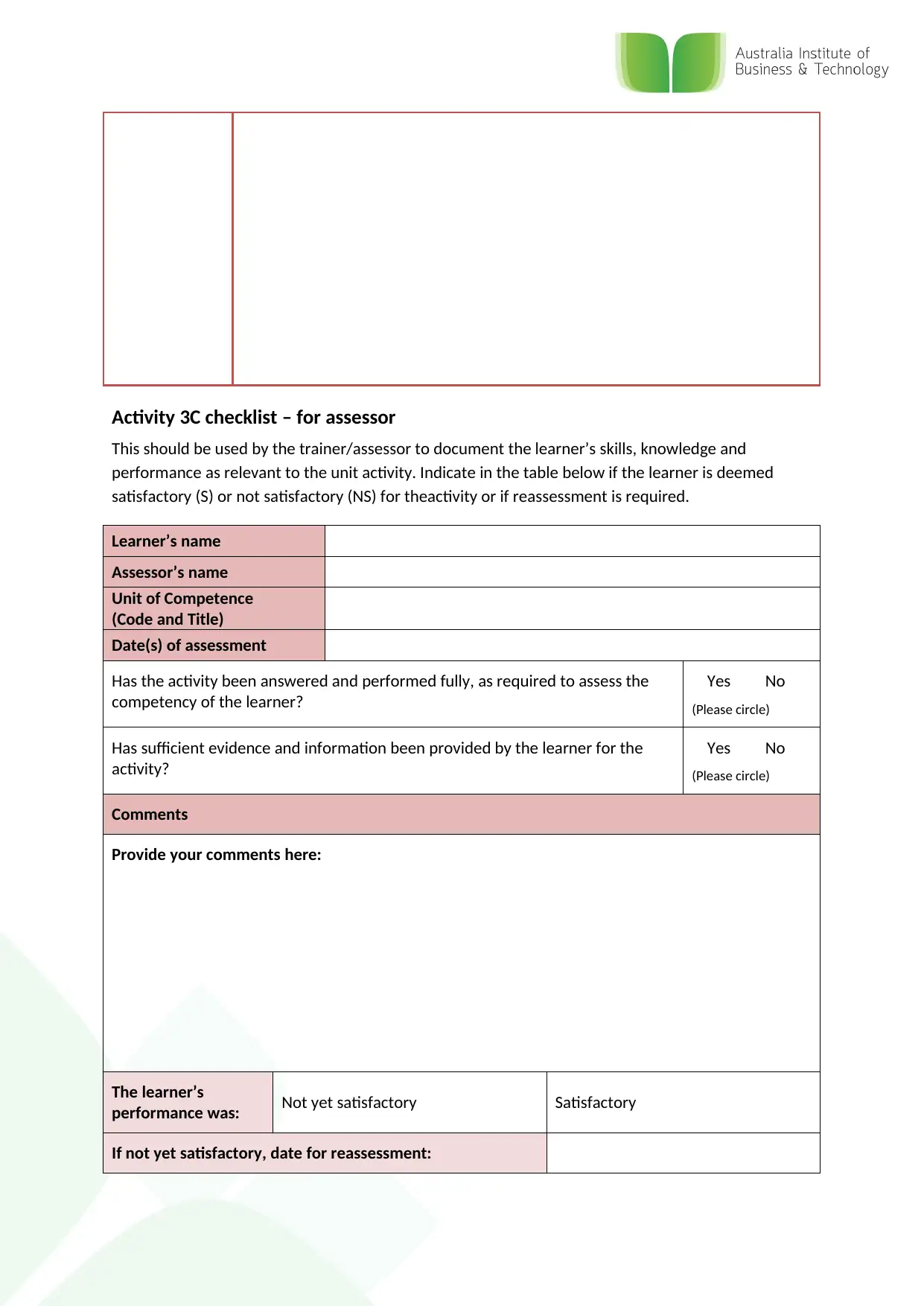
This should be used by the trainer/assessor to document the learner’s skills, knowledge and
performance as relevant to the unit activity. Indicate in the table below if the learner is deemed
satisfactory (S) or not satisfactory (NS) for theactivity or if reassessment is required.
Learner’s name
Assessor’s name
Unit of Competence
(Code and Title)
Date(s) of assessment
Has the activity been answered and performed fully, as required to assess the
competency of the learner?
Yes No
(Please circle)
Has sufficient evidence and information been provided by the learner for the
activity?
Yes No
(Please circle)
Comments
Provide your comments here:
The learner’s
performance was: Not yet satisfactory Satisfactory
If not yet satisfactory, date for reassessment:
⊘ This is a preview!⊘
Do you want full access?
Subscribe today to unlock all pages.

Trusted by 1+ million students worldwide
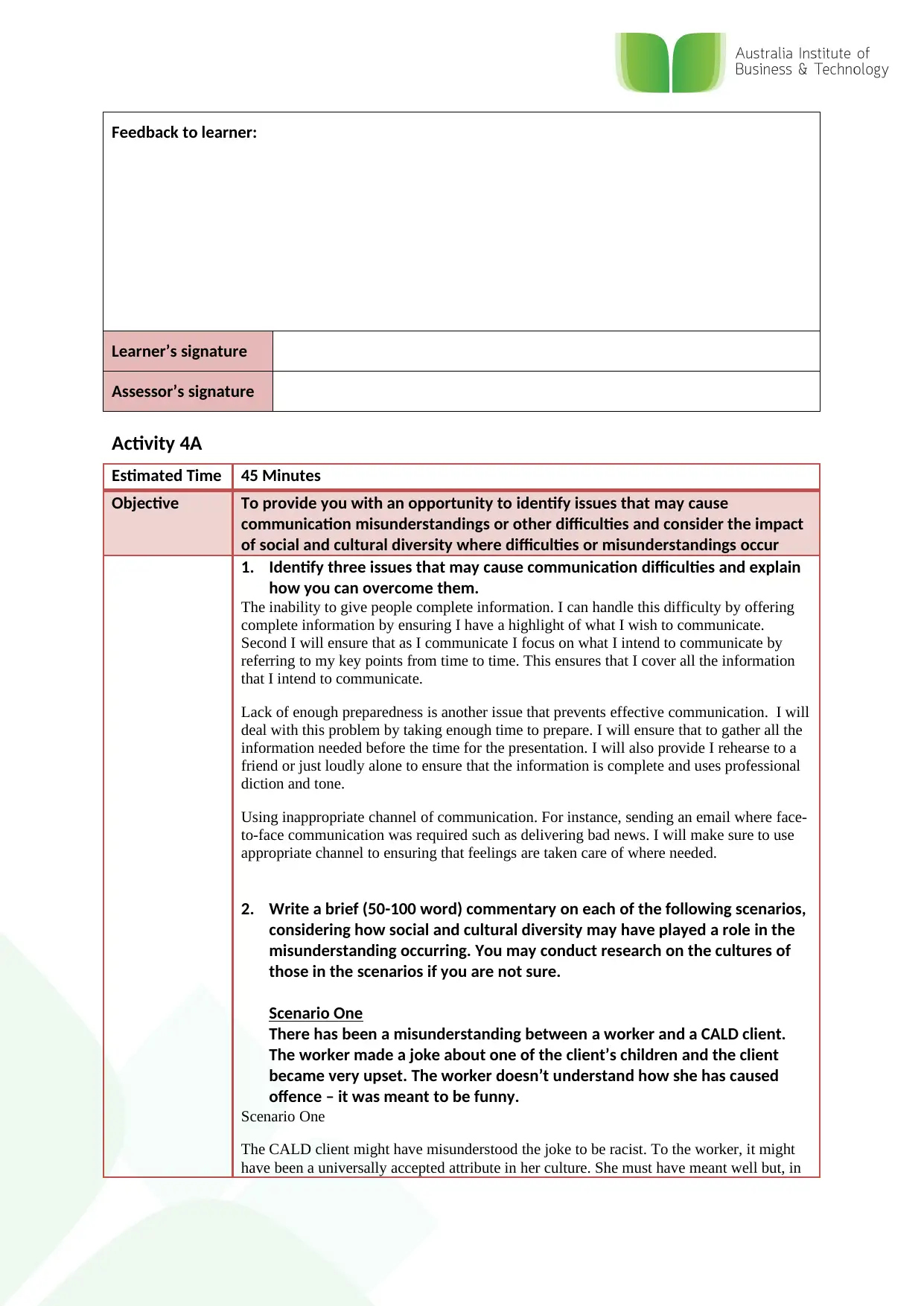
Learner’s signature
Assessor’s signature
Activity 4A
Estimated Time 45 Minutes
Objective To provide you with an opportunity to identify issues that may cause
communication misunderstandings or other difficulties and consider the impact
of social and cultural diversity where difficulties or misunderstandings occur
1. Identify three issues that may cause communication difficulties and explain
how you can overcome them.
The inability to give people complete information. I can handle this difficulty by offering
complete information by ensuring I have a highlight of what I wish to communicate.
Second I will ensure that as I communicate I focus on what I intend to communicate by
referring to my key points from time to time. This ensures that I cover all the information
that I intend to communicate.
Lack of enough preparedness is another issue that prevents effective communication. I will
deal with this problem by taking enough time to prepare. I will ensure that to gather all the
information needed before the time for the presentation. I will also provide I rehearse to a
friend or just loudly alone to ensure that the information is complete and uses professional
diction and tone.
Using inappropriate channel of communication. For instance, sending an email where face-
to-face communication was required such as delivering bad news. I will make sure to use
appropriate channel to ensuring that feelings are taken care of where needed.
2. Write a brief (50-100 word) commentary on each of the following scenarios,
considering how social and cultural diversity may have played a role in the
misunderstanding occurring. You may conduct research on the cultures of
those in the scenarios if you are not sure.
Scenario One
There has been a misunderstanding between a worker and a CALD client.
The worker made a joke about one of the client’s children and the client
became very upset. The worker doesn’t understand how she has caused
offence – it was meant to be funny.
Scenario One
The CALD client might have misunderstood the joke to be racist. To the worker, it might
have been a universally accepted attribute in her culture. She must have meant well but, in
Paraphrase This Document
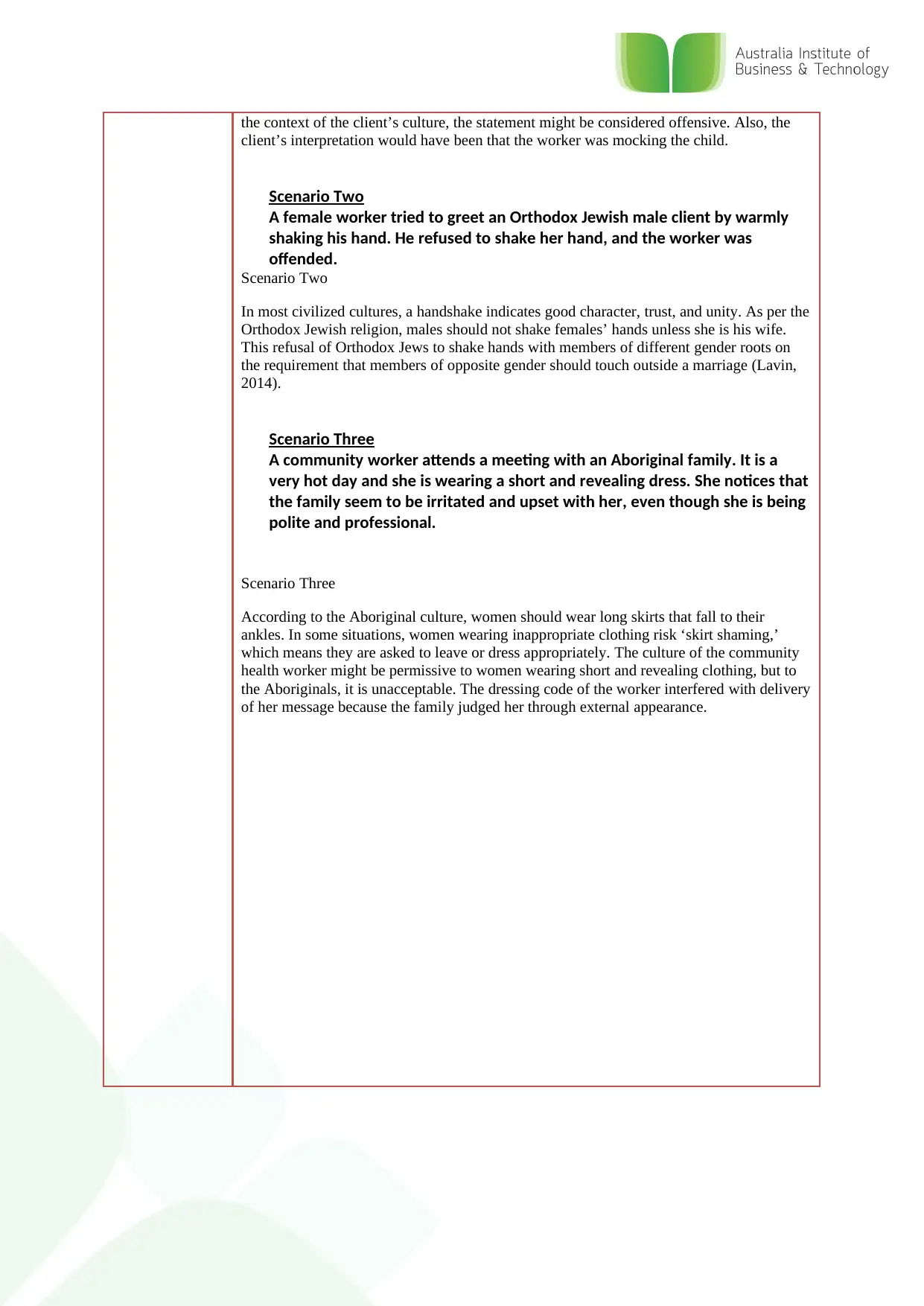
client’s interpretation would have been that the worker was mocking the child.
Scenario Two
A female worker tried to greet an Orthodox Jewish male client by warmly
shaking his hand. He refused to shake her hand, and the worker was
offended.
Scenario Two
In most civilized cultures, a handshake indicates good character, trust, and unity. As per the
Orthodox Jewish religion, males should not shake females’ hands unless she is his wife.
This refusal of Orthodox Jews to shake hands with members of different gender roots on
the requirement that members of opposite gender should touch outside a marriage (Lavin,
2014).
Scenario Three
A community worker attends a meeting with an Aboriginal family. It is a
very hot day and she is wearing a short and revealing dress. She notices that
the family seem to be irritated and upset with her, even though she is being
polite and professional.
Scenario Three
According to the Aboriginal culture, women should wear long skirts that fall to their
ankles. In some situations, women wearing inappropriate clothing risk ‘skirt shaming,’
which means they are asked to leave or dress appropriately. The culture of the community
health worker might be permissive to women wearing short and revealing clothing, but to
the Aboriginals, it is unacceptable. The dressing code of the worker interfered with delivery
of her message because the family judged her through external appearance.
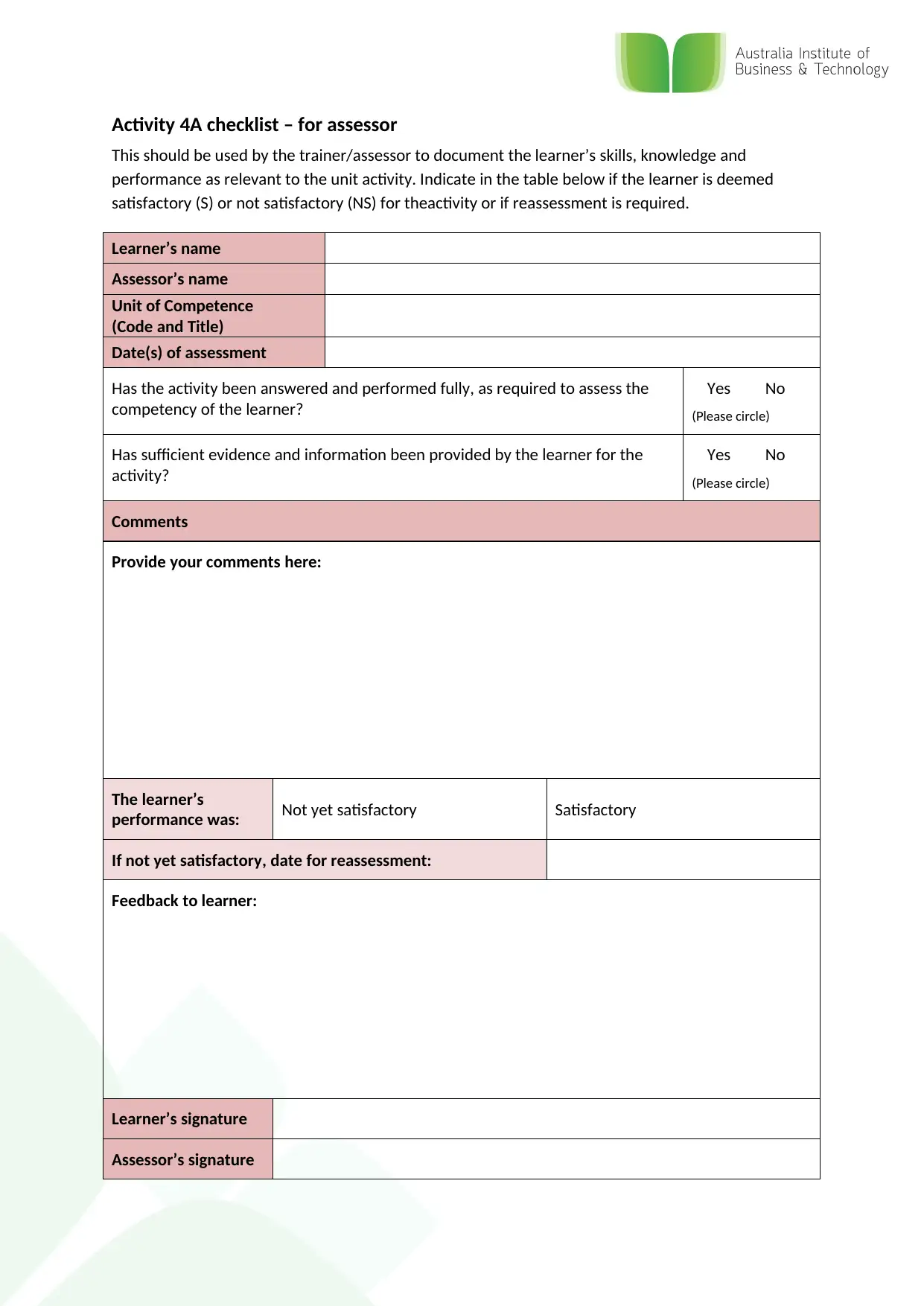
This should be used by the trainer/assessor to document the learner’s skills, knowledge and
performance as relevant to the unit activity. Indicate in the table below if the learner is deemed
satisfactory (S) or not satisfactory (NS) for theactivity or if reassessment is required.
Learner’s name
Assessor’s name
Unit of Competence
(Code and Title)
Date(s) of assessment
Has the activity been answered and performed fully, as required to assess the
competency of the learner?
Yes No
(Please circle)
Has sufficient evidence and information been provided by the learner for the
activity?
Yes No
(Please circle)
Comments
Provide your comments here:
The learner’s
performance was: Not yet satisfactory Satisfactory
If not yet satisfactory, date for reassessment:
Feedback to learner:
Learner’s signature
Assessor’s signature
⊘ This is a preview!⊘
Do you want full access?
Subscribe today to unlock all pages.

Trusted by 1+ million students worldwide
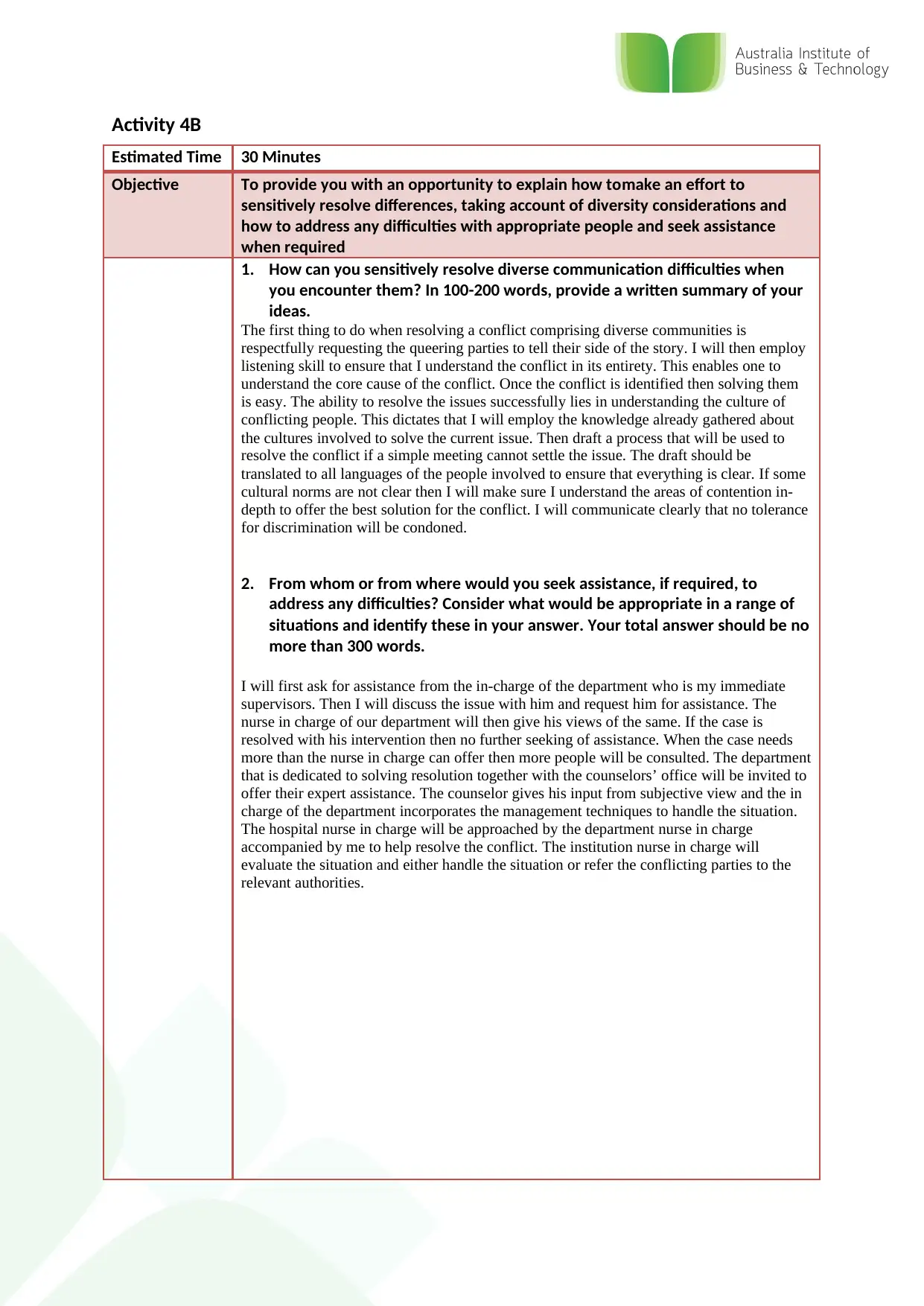
Estimated Time 30 Minutes
Objective To provide you with an opportunity to explain how tomake an effort to
sensitively resolve differences, taking account of diversity considerations and
how to address any difficulties with appropriate people and seek assistance
when required
1. How can you sensitively resolve diverse communication difficulties when
you encounter them? In 100-200 words, provide a written summary of your
ideas.
The first thing to do when resolving a conflict comprising diverse communities is
respectfully requesting the queering parties to tell their side of the story. I will then employ
listening skill to ensure that I understand the conflict in its entirety. This enables one to
understand the core cause of the conflict. Once the conflict is identified then solving them
is easy. The ability to resolve the issues successfully lies in understanding the culture of
conflicting people. This dictates that I will employ the knowledge already gathered about
the cultures involved to solve the current issue. Then draft a process that will be used to
resolve the conflict if a simple meeting cannot settle the issue. The draft should be
translated to all languages of the people involved to ensure that everything is clear. If some
cultural norms are not clear then I will make sure I understand the areas of contention in-
depth to offer the best solution for the conflict. I will communicate clearly that no tolerance
for discrimination will be condoned.
2. From whom or from where would you seek assistance, if required, to
address any difficulties? Consider what would be appropriate in a range of
situations and identify these in your answer. Your total answer should be no
more than 300 words.
I will first ask for assistance from the in-charge of the department who is my immediate
supervisors. Then I will discuss the issue with him and request him for assistance. The
nurse in charge of our department will then give his views of the same. If the case is
resolved with his intervention then no further seeking of assistance. When the case needs
more than the nurse in charge can offer then more people will be consulted. The department
that is dedicated to solving resolution together with the counselors’ office will be invited to
offer their expert assistance. The counselor gives his input from subjective view and the in
charge of the department incorporates the management techniques to handle the situation.
The hospital nurse in charge will be approached by the department nurse in charge
accompanied by me to help resolve the conflict. The institution nurse in charge will
evaluate the situation and either handle the situation or refer the conflicting parties to the
relevant authorities.
Paraphrase This Document
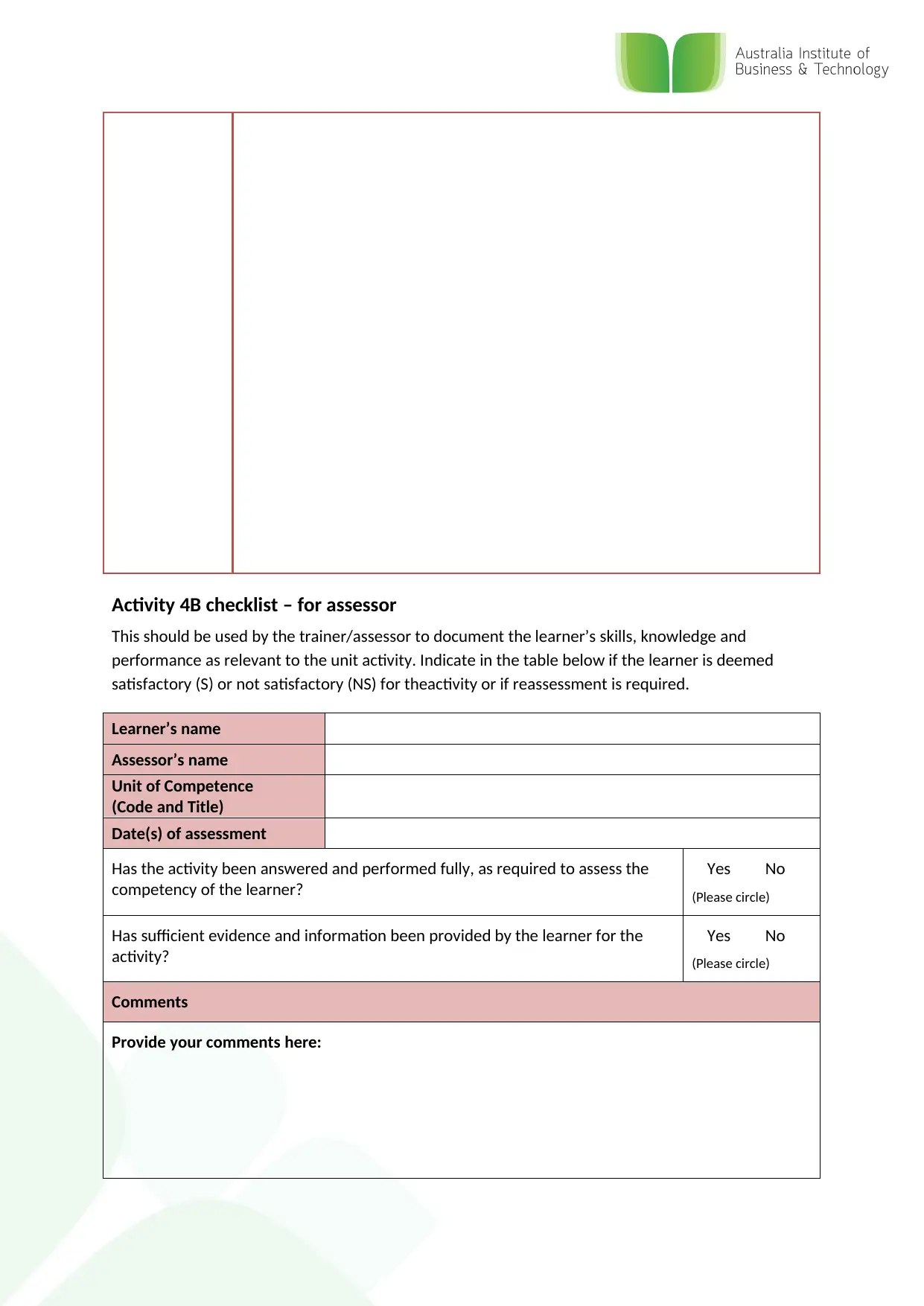
This should be used by the trainer/assessor to document the learner’s skills, knowledge and
performance as relevant to the unit activity. Indicate in the table below if the learner is deemed
satisfactory (S) or not satisfactory (NS) for theactivity or if reassessment is required.
Learner’s name
Assessor’s name
Unit of Competence
(Code and Title)
Date(s) of assessment
Has the activity been answered and performed fully, as required to assess the
competency of the learner?
Yes No
(Please circle)
Has sufficient evidence and information been provided by the learner for the
activity?
Yes No
(Please circle)
Comments
Provide your comments here:

performance was: Not yet satisfactory Satisfactory
If not yet satisfactory, date for reassessment:
Feedback to learner:
Learner’s signature
Assessor’s signature
Summative Assessments
The summative assessments are the major activities designed to assess your skills, knowledge and
performance, as required to show competency in this unit. These activities should be completed
after finishing the Learner Guide. You should complete these as stated below and as instructed by
your trainer/assessor.
Skills, knowledge and performance may be termed as:
Skills – skill requirements, required skills, essential skills, foundation skills
Knowledge – knowledge requirements, required knowledge, essential knowledge,
knowledge evidence
Performance – evidence requirements, critical aspects of assessment,performance
evidence.
Section A: Skills Activity
The Skills Activity is designed to be a series of demonstrative tasks that should be assessed by
observation (by the assessor or third party, depending on the circumstances).
It will demonstrate all of the skills required for this unit of competency – your assessor will provide
further instructions to you, if necessary.
Section B: Knowledge Activity (Q & A)
⊘ This is a preview!⊘
Do you want full access?
Subscribe today to unlock all pages.

Trusted by 1+ million students worldwide
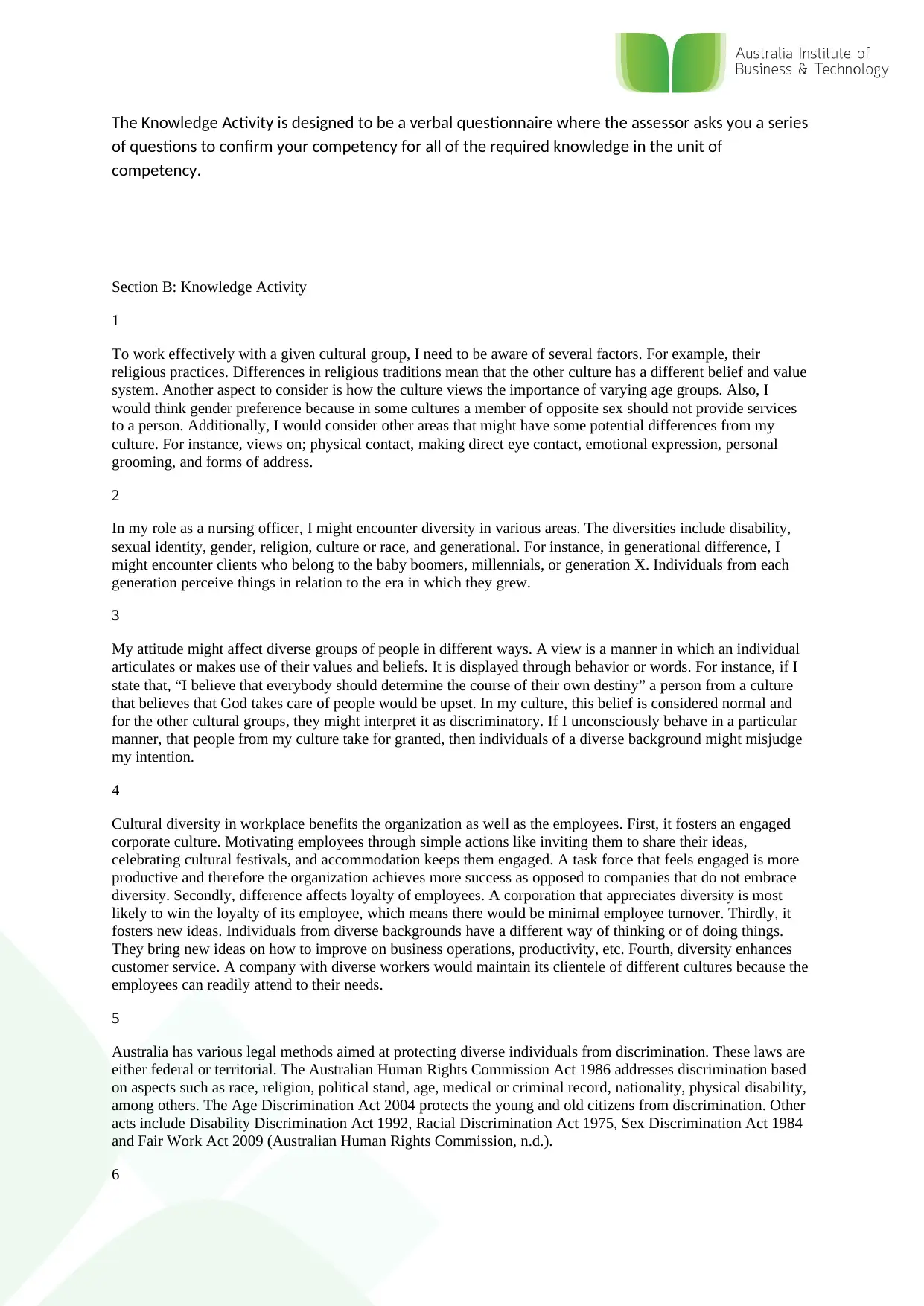
of questions to confirm your competency for all of the required knowledge in the unit of
competency.
Section B: Knowledge Activity
1
To work effectively with a given cultural group, I need to be aware of several factors. For example, their
religious practices. Differences in religious traditions mean that the other culture has a different belief and value
system. Another aspect to consider is how the culture views the importance of varying age groups. Also, I
would think gender preference because in some cultures a member of opposite sex should not provide services
to a person. Additionally, I would consider other areas that might have some potential differences from my
culture. For instance, views on; physical contact, making direct eye contact, emotional expression, personal
grooming, and forms of address.
2
In my role as a nursing officer, I might encounter diversity in various areas. The diversities include disability,
sexual identity, gender, religion, culture or race, and generational. For instance, in generational difference, I
might encounter clients who belong to the baby boomers, millennials, or generation X. Individuals from each
generation perceive things in relation to the era in which they grew.
3
My attitude might affect diverse groups of people in different ways. A view is a manner in which an individual
articulates or makes use of their values and beliefs. It is displayed through behavior or words. For instance, if I
state that, “I believe that everybody should determine the course of their own destiny” a person from a culture
that believes that God takes care of people would be upset. In my culture, this belief is considered normal and
for the other cultural groups, they might interpret it as discriminatory. If I unconsciously behave in a particular
manner, that people from my culture take for granted, then individuals of a diverse background might misjudge
my intention.
4
Cultural diversity in workplace benefits the organization as well as the employees. First, it fosters an engaged
corporate culture. Motivating employees through simple actions like inviting them to share their ideas,
celebrating cultural festivals, and accommodation keeps them engaged. A task force that feels engaged is more
productive and therefore the organization achieves more success as opposed to companies that do not embrace
diversity. Secondly, difference affects loyalty of employees. A corporation that appreciates diversity is most
likely to win the loyalty of its employee, which means there would be minimal employee turnover. Thirdly, it
fosters new ideas. Individuals from diverse backgrounds have a different way of thinking or of doing things.
They bring new ideas on how to improve on business operations, productivity, etc. Fourth, diversity enhances
customer service. A company with diverse workers would maintain its clientele of different cultures because the
employees can readily attend to their needs.
5
Australia has various legal methods aimed at protecting diverse individuals from discrimination. These laws are
either federal or territorial. The Australian Human Rights Commission Act 1986 addresses discrimination based
on aspects such as race, religion, political stand, age, medical or criminal record, nationality, physical disability,
among others. The Age Discrimination Act 2004 protects the young and old citizens from discrimination. Other
acts include Disability Discrimination Act 1992, Racial Discrimination Act 1975, Sex Discrimination Act 1984
and Fair Work Act 2009 (Australian Human Rights Commission, n.d.).
6
Paraphrase This Document
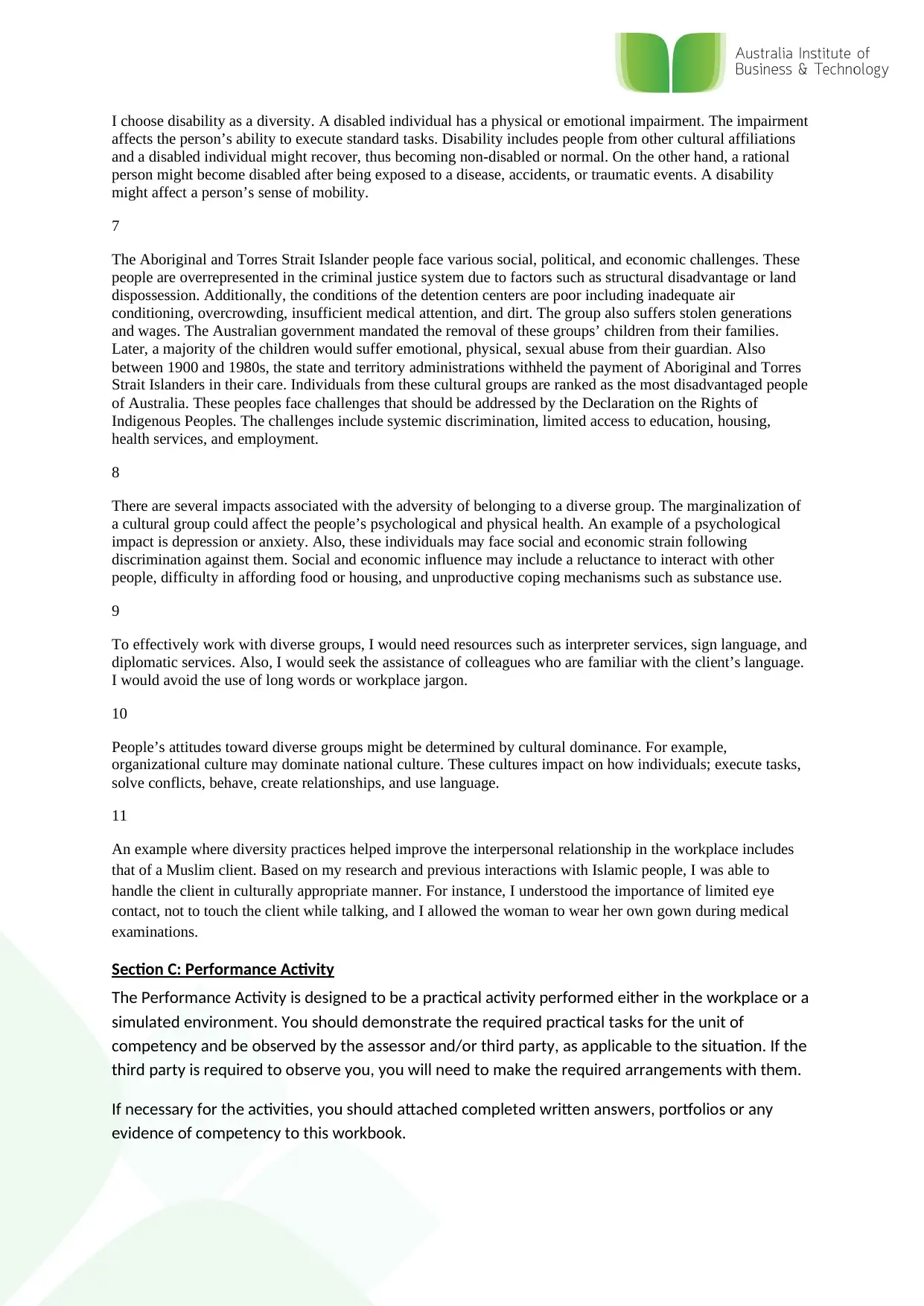
affects the person’s ability to execute standard tasks. Disability includes people from other cultural affiliations
and a disabled individual might recover, thus becoming non-disabled or normal. On the other hand, a rational
person might become disabled after being exposed to a disease, accidents, or traumatic events. A disability
might affect a person’s sense of mobility.
7
The Aboriginal and Torres Strait Islander people face various social, political, and economic challenges. These
people are overrepresented in the criminal justice system due to factors such as structural disadvantage or land
dispossession. Additionally, the conditions of the detention centers are poor including inadequate air
conditioning, overcrowding, insufficient medical attention, and dirt. The group also suffers stolen generations
and wages. The Australian government mandated the removal of these groups’ children from their families.
Later, a majority of the children would suffer emotional, physical, sexual abuse from their guardian. Also
between 1900 and 1980s, the state and territory administrations withheld the payment of Aboriginal and Torres
Strait Islanders in their care. Individuals from these cultural groups are ranked as the most disadvantaged people
of Australia. These peoples face challenges that should be addressed by the Declaration on the Rights of
Indigenous Peoples. The challenges include systemic discrimination, limited access to education, housing,
health services, and employment.
8
There are several impacts associated with the adversity of belonging to a diverse group. The marginalization of
a cultural group could affect the people’s psychological and physical health. An example of a psychological
impact is depression or anxiety. Also, these individuals may face social and economic strain following
discrimination against them. Social and economic influence may include a reluctance to interact with other
people, difficulty in affording food or housing, and unproductive coping mechanisms such as substance use.
9
To effectively work with diverse groups, I would need resources such as interpreter services, sign language, and
diplomatic services. Also, I would seek the assistance of colleagues who are familiar with the client’s language.
I would avoid the use of long words or workplace jargon.
10
People’s attitudes toward diverse groups might be determined by cultural dominance. For example,
organizational culture may dominate national culture. These cultures impact on how individuals; execute tasks,
solve conflicts, behave, create relationships, and use language.
11
An example where diversity practices helped improve the interpersonal relationship in the workplace includes
that of a Muslim client. Based on my research and previous interactions with Islamic people, I was able to
handle the client in culturally appropriate manner. For instance, I understood the importance of limited eye
contact, not to touch the client while talking, and I allowed the woman to wear her own gown during medical
examinations.
Section C: Performance Activity
The Performance Activity is designed to be a practical activity performed either in the workplace or a
simulated environment. You should demonstrate the required practical tasks for the unit of
competency and be observed by the assessor and/or third party, as applicable to the situation. If the
third party is required to observe you, you will need to make the required arrangements with them.
If necessary for the activities, you should attached completed written answers, portfolios or any
evidence of competency to this workbook.

1
Cultural bias is related to judging others based on one’s culture. My social perspective is that in some situations
I tend to pick out the differences that other people have from my culture. In the past, I was blind to the values
and beliefs of my community. An instance where I was biased is when I thought that all Muslims are of Arabic
descent. To improve my interaction with diverse groups, I would assess areas in which my culture overlaps with
that of my clients. Also, I would do some in-depth research on various groups to avoid generalizations based on
assumption. This identification would act to reduce cultural bias.
⊘ This is a preview!⊘
Do you want full access?
Subscribe today to unlock all pages.

Trusted by 1+ million students worldwide
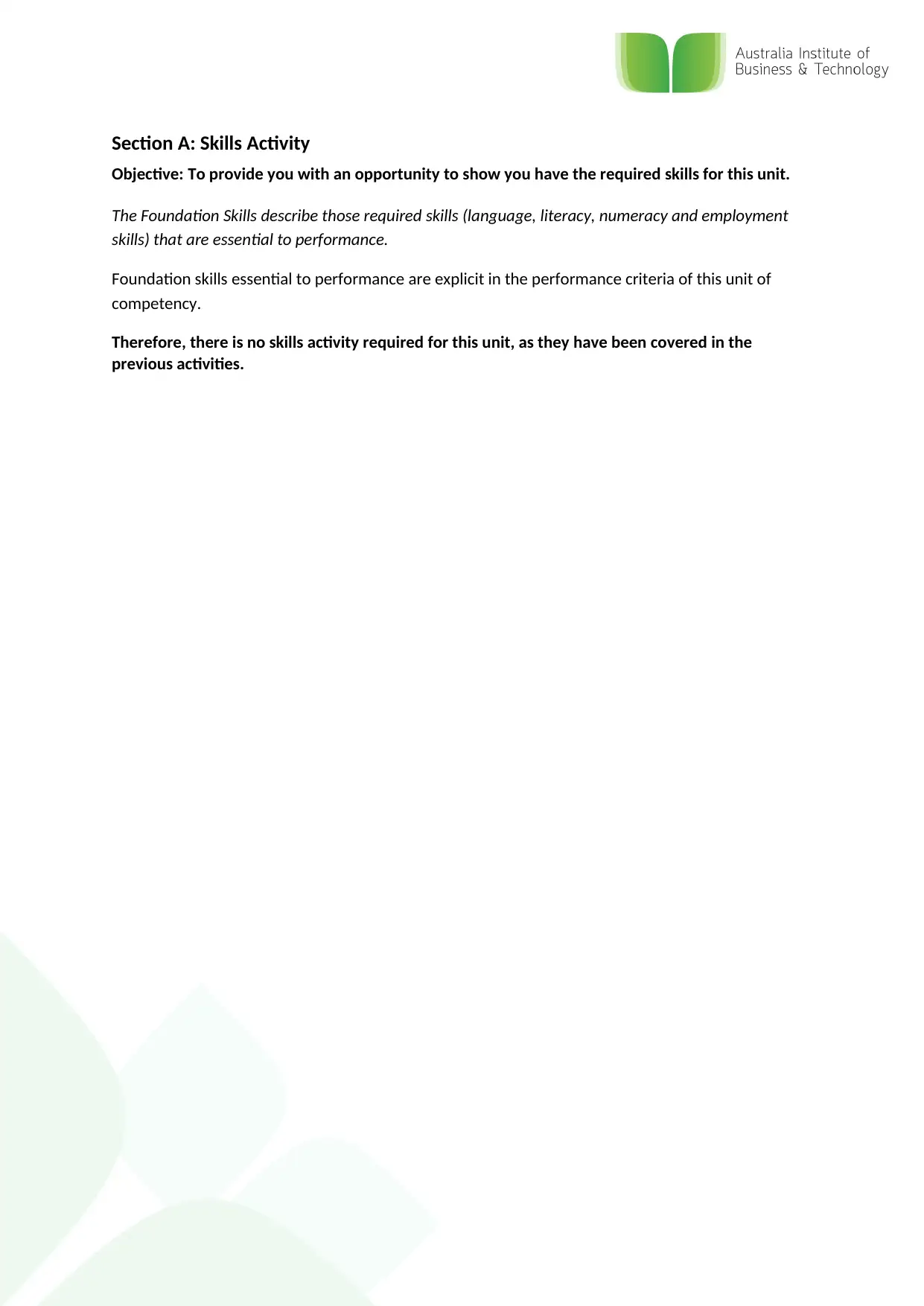
Objective: To provide you with an opportunity to show you have the required skills for this unit.
The Foundation Skills describe those required skills (language, literacy, numeracy and employment
skills) that are essential to performance.
Foundation skills essential to performance are explicit in the performance criteria of this unit of
competency.
Therefore, there is no skills activity required for this unit, as they have been covered in the
previous activities.
Paraphrase This Document

Objective: To provide you with an opportunity to show you have the required knowledge for this
unit.
The answers to the following questions will enable you to demonstrate your knowledge of:
Concepts of cultural awareness, cultural safety and cultural competence and how these
impact different work roles
Concepts and definitions of diversity
Own culture and the community attitudes, language, policies and structures of that culture
and how they impact on different people and groups
Features of diversity in Australia and how this impacts different areas of work and life:
o political
o social
o economic
o cultural
Legal and ethical considerations (international, national, state/territory, local) for working
with diversity, how these impact individual workers, and the consequences of breaches:
o discrimination:
age
disability
racial
sex
o human rights:
Universal declaration of human rights
relationship between human needs and human rights
frameworks, approaches and instruments used in the workplace
o rights and responsibilities of workers, employers and clients, including appropriate
action when rights are being infringed or responsibilities not being carried out
Key areas of diversity and their characteristics, including:
o culture, race, ethnicity
o disability
o religious or spiritual beliefs
o gender, including transgender
o intersex
o generational
o sexual orientation/sexual identity - lesbian, gay, bisexual, heterosexual
Key aspects, and the diversity, of Australia’s Aboriginal and/or Torres Strait Islander cultures,
including:
o social, political and economic issues affecting Aboriginal and/or Torres Strait Islander
people
o own culture, western systems and structures and how these impact on Aboriginal
and/or Torres Strait Islander people and their engagement with services
Potential needs of marginalised groups, including:
o protective factors
o physical, mental and emotional health issues/care needs
o consideration of impacts of discrimination, trauma, exclusion and negative attitudes
Resources that support individuals and organisations to embrace and respond to diversity
o language and cultural interpreters
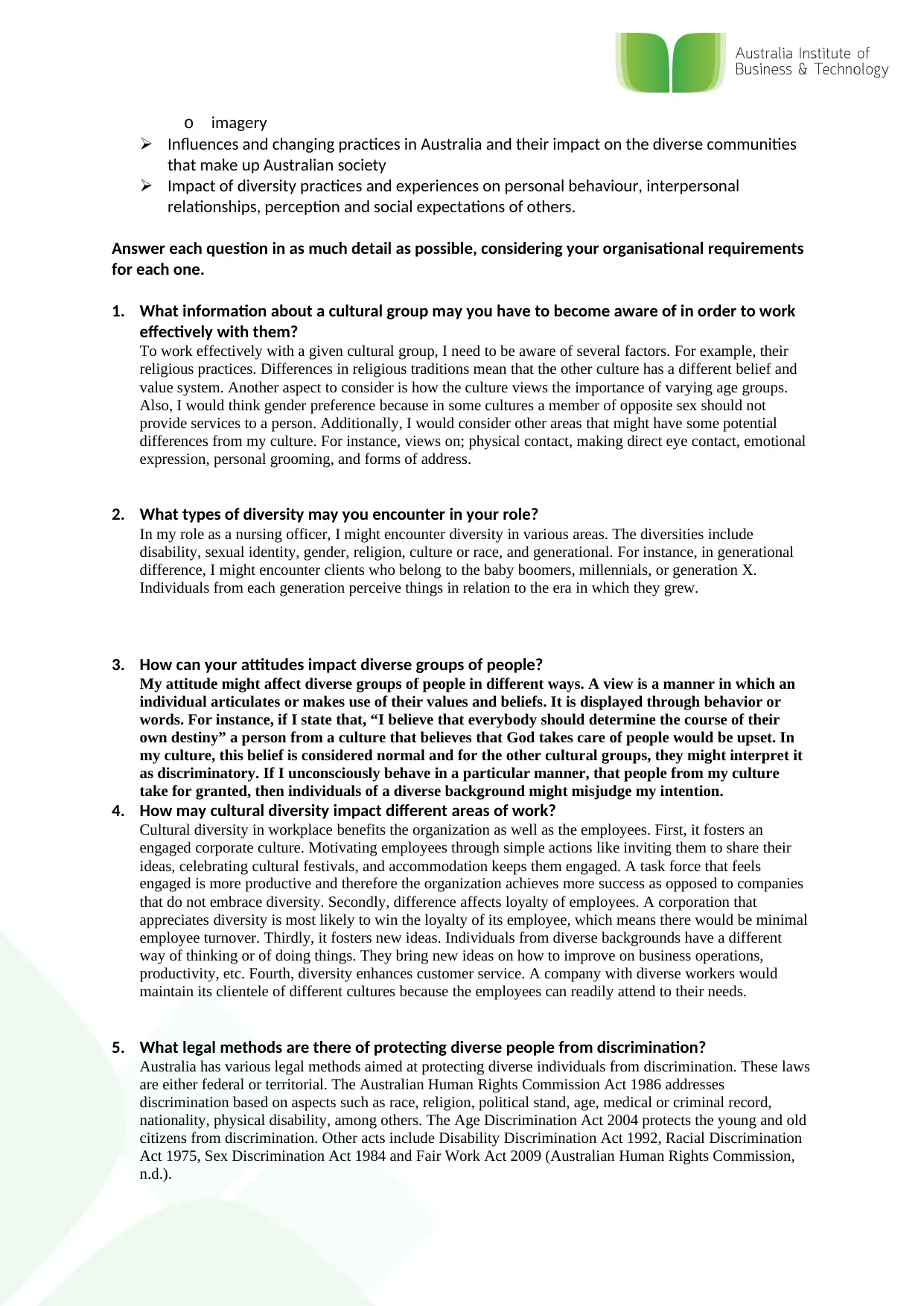
Influences and changing practices in Australia and their impact on the diverse communities
that make up Australian society
Impact of diversity practices and experiences on personal behaviour, interpersonal
relationships, perception and social expectations of others.
Answer each question in as much detail as possible, considering your organisational requirements
for each one.
1. What information about a cultural group may you have to become aware of in order to work
effectively with them?
To work effectively with a given cultural group, I need to be aware of several factors. For example, their
religious practices. Differences in religious traditions mean that the other culture has a different belief and
value system. Another aspect to consider is how the culture views the importance of varying age groups.
Also, I would think gender preference because in some cultures a member of opposite sex should not
provide services to a person. Additionally, I would consider other areas that might have some potential
differences from my culture. For instance, views on; physical contact, making direct eye contact, emotional
expression, personal grooming, and forms of address.
2. What types of diversity may you encounter in your role?
In my role as a nursing officer, I might encounter diversity in various areas. The diversities include
disability, sexual identity, gender, religion, culture or race, and generational. For instance, in generational
difference, I might encounter clients who belong to the baby boomers, millennials, or generation X.
Individuals from each generation perceive things in relation to the era in which they grew.
3. How can your attitudes impact diverse groups of people?
My attitude might affect diverse groups of people in different ways. A view is a manner in which an
individual articulates or makes use of their values and beliefs. It is displayed through behavior or
words. For instance, if I state that, “I believe that everybody should determine the course of their
own destiny” a person from a culture that believes that God takes care of people would be upset. In
my culture, this belief is considered normal and for the other cultural groups, they might interpret it
as discriminatory. If I unconsciously behave in a particular manner, that people from my culture
take for granted, then individuals of a diverse background might misjudge my intention.
4. How may cultural diversity impact different areas of work?
Cultural diversity in workplace benefits the organization as well as the employees. First, it fosters an
engaged corporate culture. Motivating employees through simple actions like inviting them to share their
ideas, celebrating cultural festivals, and accommodation keeps them engaged. A task force that feels
engaged is more productive and therefore the organization achieves more success as opposed to companies
that do not embrace diversity. Secondly, difference affects loyalty of employees. A corporation that
appreciates diversity is most likely to win the loyalty of its employee, which means there would be minimal
employee turnover. Thirdly, it fosters new ideas. Individuals from diverse backgrounds have a different
way of thinking or of doing things. They bring new ideas on how to improve on business operations,
productivity, etc. Fourth, diversity enhances customer service. A company with diverse workers would
maintain its clientele of different cultures because the employees can readily attend to their needs.
5. What legal methods are there of protecting diverse people from discrimination?
Australia has various legal methods aimed at protecting diverse individuals from discrimination. These laws
are either federal or territorial. The Australian Human Rights Commission Act 1986 addresses
discrimination based on aspects such as race, religion, political stand, age, medical or criminal record,
nationality, physical disability, among others. The Age Discrimination Act 2004 protects the young and old
citizens from discrimination. Other acts include Disability Discrimination Act 1992, Racial Discrimination
Act 1975, Sex Discrimination Act 1984 and Fair Work Act 2009 (Australian Human Rights Commission,
n.d.).
⊘ This is a preview!⊘
Do you want full access?
Subscribe today to unlock all pages.

Trusted by 1+ million students worldwide
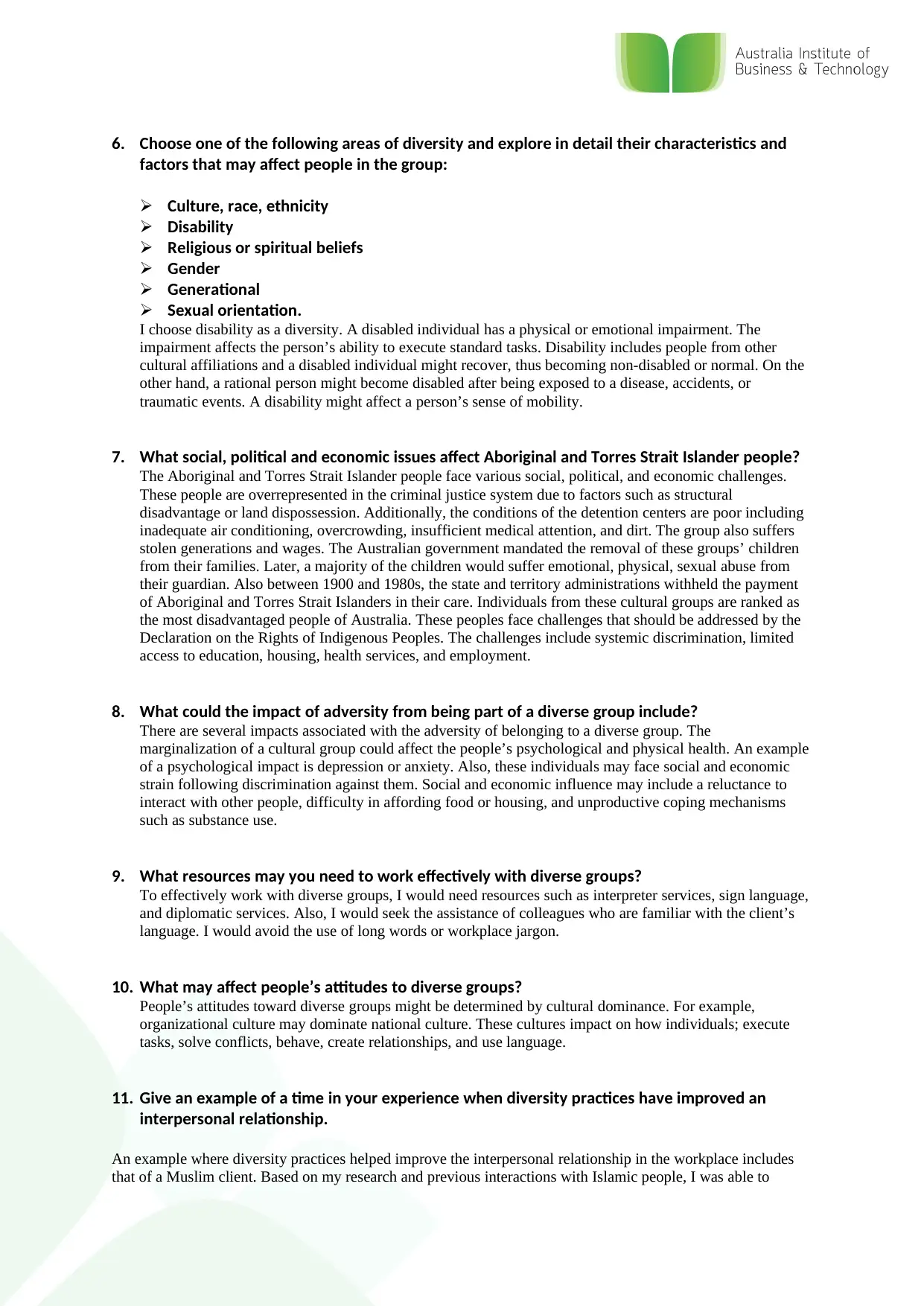
factors that may affect people in the group:
Culture, race, ethnicity
Disability
Religious or spiritual beliefs
Gender
Generational
Sexual orientation.
I choose disability as a diversity. A disabled individual has a physical or emotional impairment. The
impairment affects the person’s ability to execute standard tasks. Disability includes people from other
cultural affiliations and a disabled individual might recover, thus becoming non-disabled or normal. On the
other hand, a rational person might become disabled after being exposed to a disease, accidents, or
traumatic events. A disability might affect a person’s sense of mobility.
7. What social, political and economic issues affect Aboriginal and Torres Strait Islander people?
The Aboriginal and Torres Strait Islander people face various social, political, and economic challenges.
These people are overrepresented in the criminal justice system due to factors such as structural
disadvantage or land dispossession. Additionally, the conditions of the detention centers are poor including
inadequate air conditioning, overcrowding, insufficient medical attention, and dirt. The group also suffers
stolen generations and wages. The Australian government mandated the removal of these groups’ children
from their families. Later, a majority of the children would suffer emotional, physical, sexual abuse from
their guardian. Also between 1900 and 1980s, the state and territory administrations withheld the payment
of Aboriginal and Torres Strait Islanders in their care. Individuals from these cultural groups are ranked as
the most disadvantaged people of Australia. These peoples face challenges that should be addressed by the
Declaration on the Rights of Indigenous Peoples. The challenges include systemic discrimination, limited
access to education, housing, health services, and employment.
8. What could the impact of adversity from being part of a diverse group include?
There are several impacts associated with the adversity of belonging to a diverse group. The
marginalization of a cultural group could affect the people’s psychological and physical health. An example
of a psychological impact is depression or anxiety. Also, these individuals may face social and economic
strain following discrimination against them. Social and economic influence may include a reluctance to
interact with other people, difficulty in affording food or housing, and unproductive coping mechanisms
such as substance use.
9. What resources may you need to work effectively with diverse groups?
To effectively work with diverse groups, I would need resources such as interpreter services, sign language,
and diplomatic services. Also, I would seek the assistance of colleagues who are familiar with the client’s
language. I would avoid the use of long words or workplace jargon.
10. What may affect people’s attitudes to diverse groups?
People’s attitudes toward diverse groups might be determined by cultural dominance. For example,
organizational culture may dominate national culture. These cultures impact on how individuals; execute
tasks, solve conflicts, behave, create relationships, and use language.
11. Give an example of a time in your experience when diversity practices have improved an
interpersonal relationship.
An example where diversity practices helped improve the interpersonal relationship in the workplace includes
that of a Muslim client. Based on my research and previous interactions with Islamic people, I was able to
Paraphrase This Document
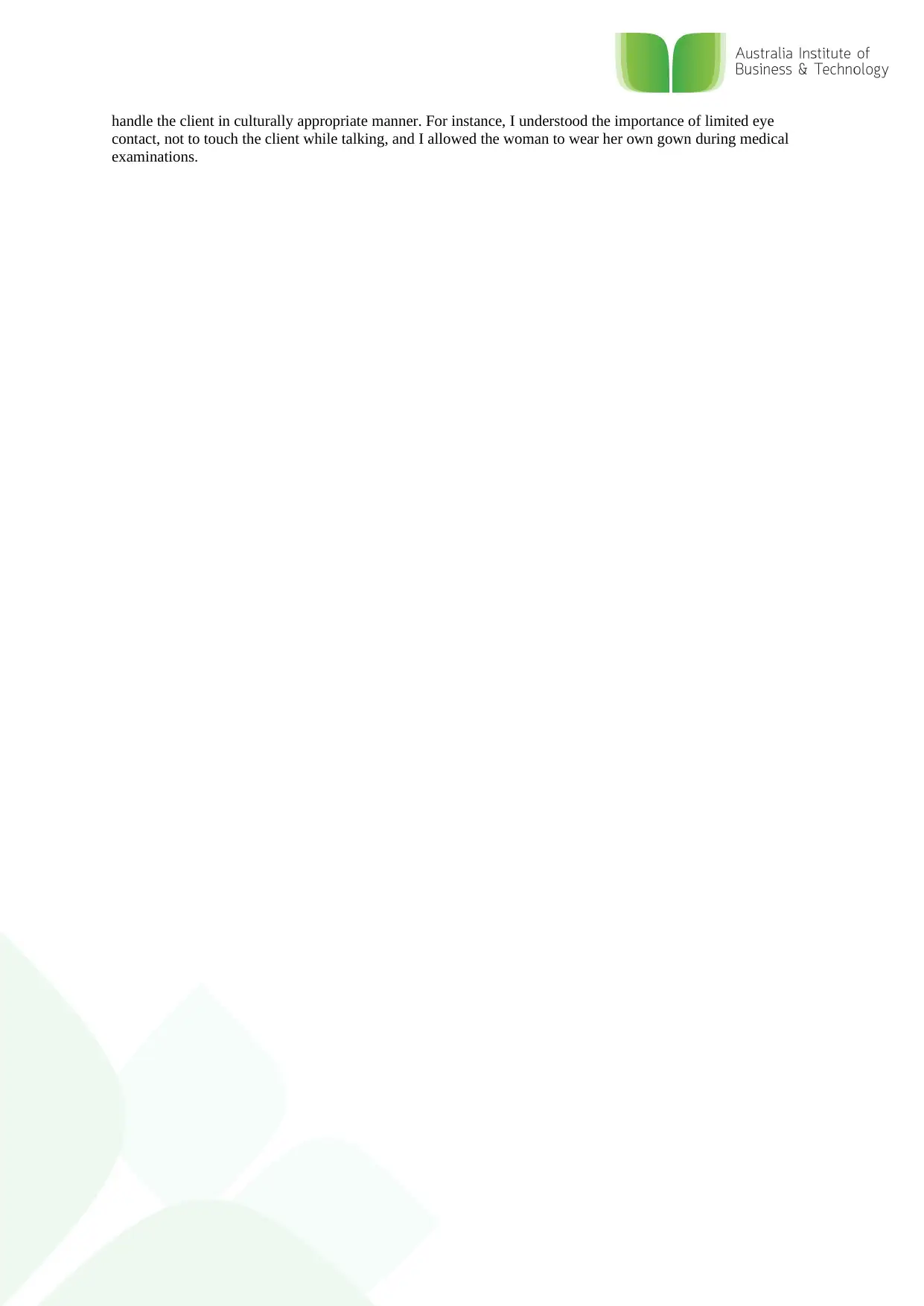
contact, not to touch the client while talking, and I allowed the woman to wear her own gown during medical
examinations.
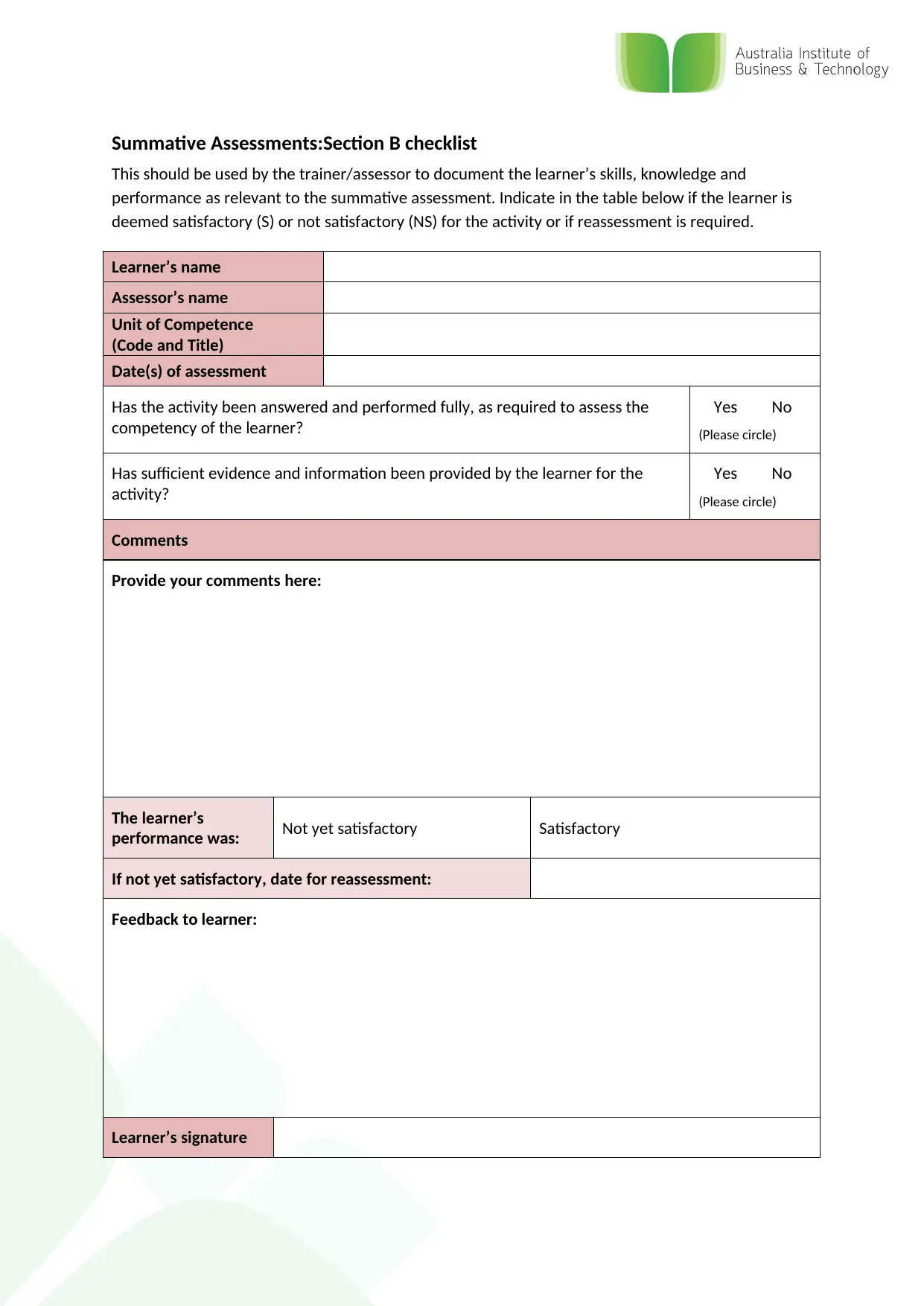
This should be used by the trainer/assessor to document the learner’s skills, knowledge and
performance as relevant to the summative assessment. Indicate in the table below if the learner is
deemed satisfactory (S) or not satisfactory (NS) for the activity or if reassessment is required.
Learner’s name
Assessor’s name
Unit of Competence
(Code and Title)
Date(s) of assessment
Has the activity been answered and performed fully, as required to assess the
competency of the learner?
Yes No
(Please circle)
Has sufficient evidence and information been provided by the learner for the
activity?
Yes No
(Please circle)
Comments
Provide your comments here:
The learner’s
performance was: Not yet satisfactory Satisfactory
If not yet satisfactory, date for reassessment:
Feedback to learner:
Learner’s signature
⊘ This is a preview!⊘
Do you want full access?
Subscribe today to unlock all pages.

Trusted by 1+ million students worldwide

Section C: Performance Activity
Objective: To provide you with an opportunity to demonstrate the required performance
elements for this unit.
This activity will enable you to demonstrate the followingperformanceevidence:
Undertaken a structured process to reflect on own perspectives on diversity
Recognised and respected the needs of people from diverse social and cultural backgrounds
in at least 3 different situations:
o selected and used appropriate verbal and non-verbal communication
o recognised situations where misunderstandings may arise from diversity and formed
appropriate responses.
Answer the activity in as much detail as possible, considering your organisational requirements.
1. Undertake a structured process to reflect on own perspectives on diversity.
Ensure that you:
Identify and reflect on your own social perspectives and biases
Identify your limitations in self and social awareness
Identify and act on ways to improve own self and social awareness.
Cultural bias is related to judging others based on one’s culture. My social perspective is that in
some situations I tend to pick out the differences that other people have from my culture. In the
past, I was blind to the values and beliefs of my community. An instance where I was biased is
when I thought that all Muslims are of Arabic descent. To improve my interaction with diverse
groups, I would assess areas in which my culture overlaps with that of my clients. Also, I would do
some in-depth research on various groups to avoid generalizations based on assumption. This
identification would act to reduce cultural bias.
2. In a workplace or simulated workplace environment, recognise and respect the needs of
people from diverse social and cultural backgrounds in at least 3 different situations.
Ensure that you:
Select and use appropriate verbal and non-verbal communication
Recognise situations where misunderstandings may arise from diversity and form
appropriate responses.
Scenario one
When communicating with a millennial, I would try and keep my conversation brief and precise. Also, I
would make sure that I provide him or her with all the necessary details. It will also help if I use various
communication channels such as Skype. I would even not joke about age since this group expects to be
treated with respect.
Scenario two
As a healthcare worker, I would ensure a nonjudgmental attitude while interacting with people of different
sexual orientations. I would ensure that I establish trust and rapport with the client by asking questions just
Paraphrase This Document
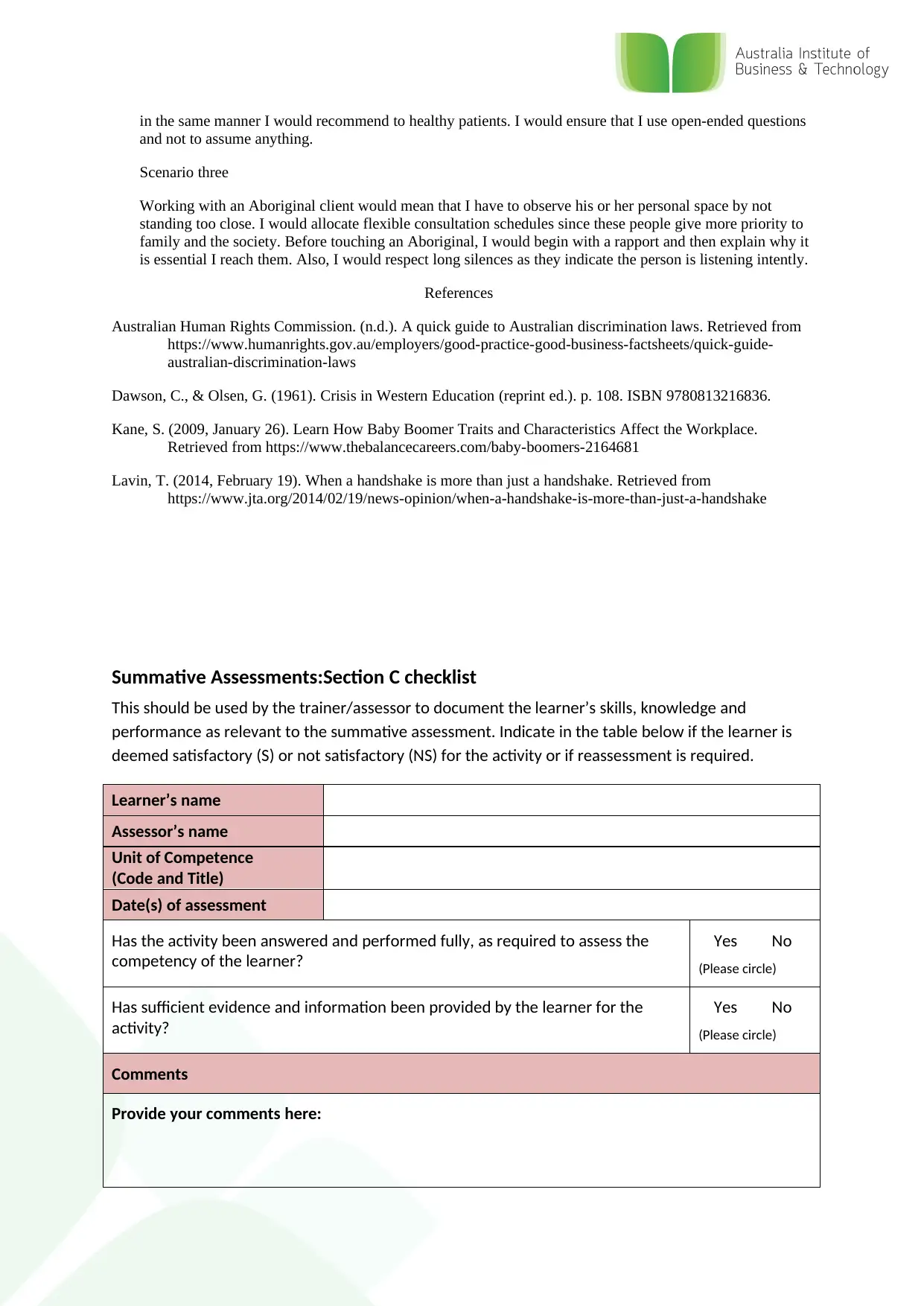
and not to assume anything.
Scenario three
Working with an Aboriginal client would mean that I have to observe his or her personal space by not
standing too close. I would allocate flexible consultation schedules since these people give more priority to
family and the society. Before touching an Aboriginal, I would begin with a rapport and then explain why it
is essential I reach them. Also, I would respect long silences as they indicate the person is listening intently.
References
Australian Human Rights Commission. (n.d.). A quick guide to Australian discrimination laws. Retrieved from
https://www.humanrights.gov.au/employers/good-practice-good-business-factsheets/quick-guide-
australian-discrimination-laws
Dawson, C., & Olsen, G. (1961). Crisis in Western Education (reprint ed.). p. 108. ISBN 9780813216836.
Kane, S. (2009, January 26). Learn How Baby Boomer Traits and Characteristics Affect the Workplace.
Retrieved from https://www.thebalancecareers.com/baby-boomers-2164681
Lavin, T. (2014, February 19). When a handshake is more than just a handshake. Retrieved from
https://www.jta.org/2014/02/19/news-opinion/when-a-handshake-is-more-than-just-a-handshake
Summative Assessments:Section C checklist
This should be used by the trainer/assessor to document the learner’s skills, knowledge and
performance as relevant to the summative assessment. Indicate in the table below if the learner is
deemed satisfactory (S) or not satisfactory (NS) for the activity or if reassessment is required.
Learner’s name
Assessor’s name
Unit of Competence
(Code and Title)
Date(s) of assessment
Has the activity been answered and performed fully, as required to assess the
competency of the learner?
Yes No
(Please circle)
Has sufficient evidence and information been provided by the learner for the
activity?
Yes No
(Please circle)
Comments
Provide your comments here:
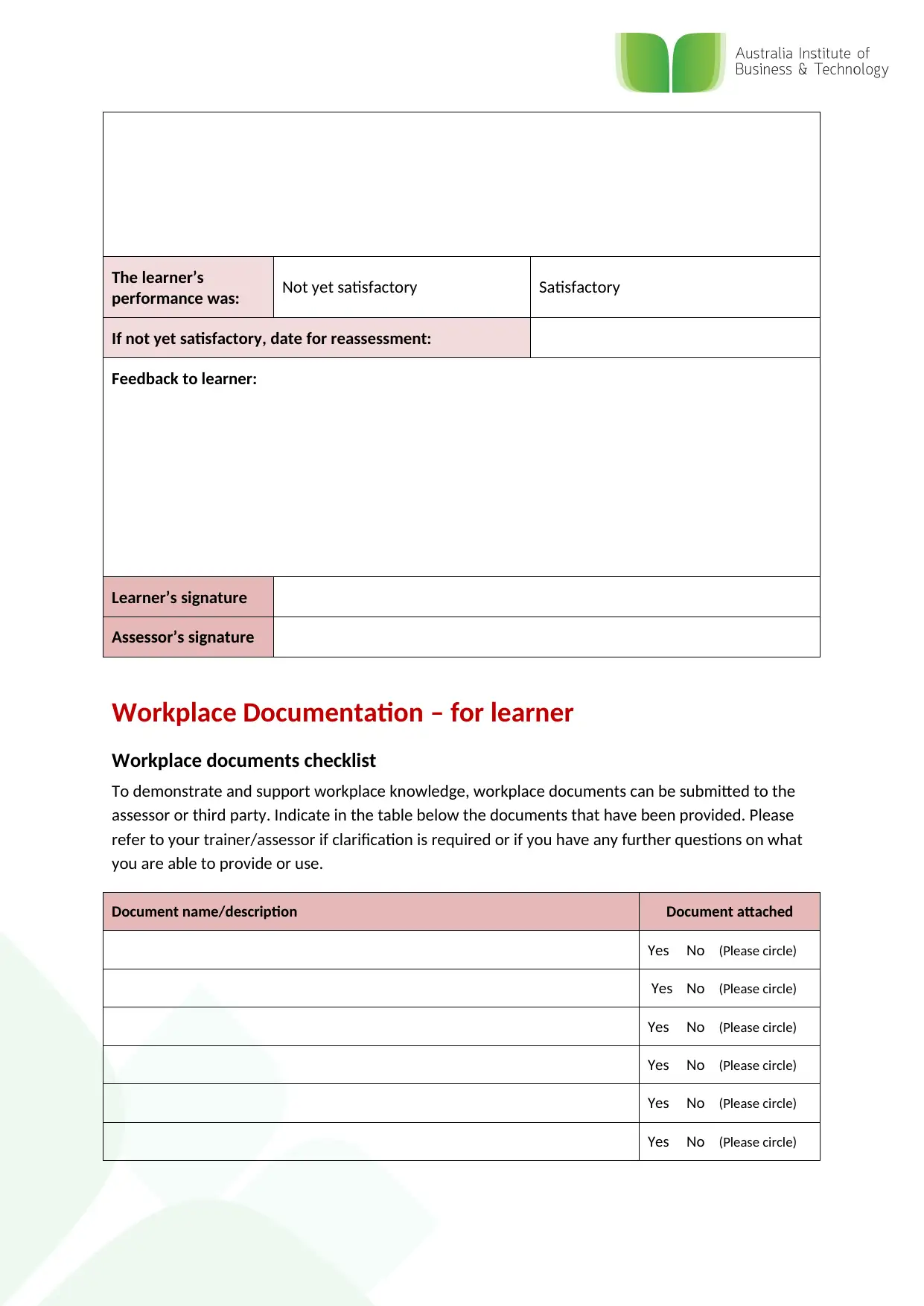
performance was: Not yet satisfactory Satisfactory
If not yet satisfactory, date for reassessment:
Feedback to learner:
Learner’s signature
Assessor’s signature
Workplace Documentation – for learner
Workplace documents checklist
To demonstrate and support workplace knowledge, workplace documents can be submitted to the
assessor or third party. Indicate in the table below the documents that have been provided. Please
refer to your trainer/assessor if clarification is required or if you have any further questions on what
you are able to provide or use.
Document name/description Document attached
Yes No (Please circle)
Yes No (Please circle)
Yes No (Please circle)
Yes No (Please circle)
Yes No (Please circle)
Yes No (Please circle)
⊘ This is a preview!⊘
Do you want full access?
Subscribe today to unlock all pages.

Trusted by 1+ million students worldwide
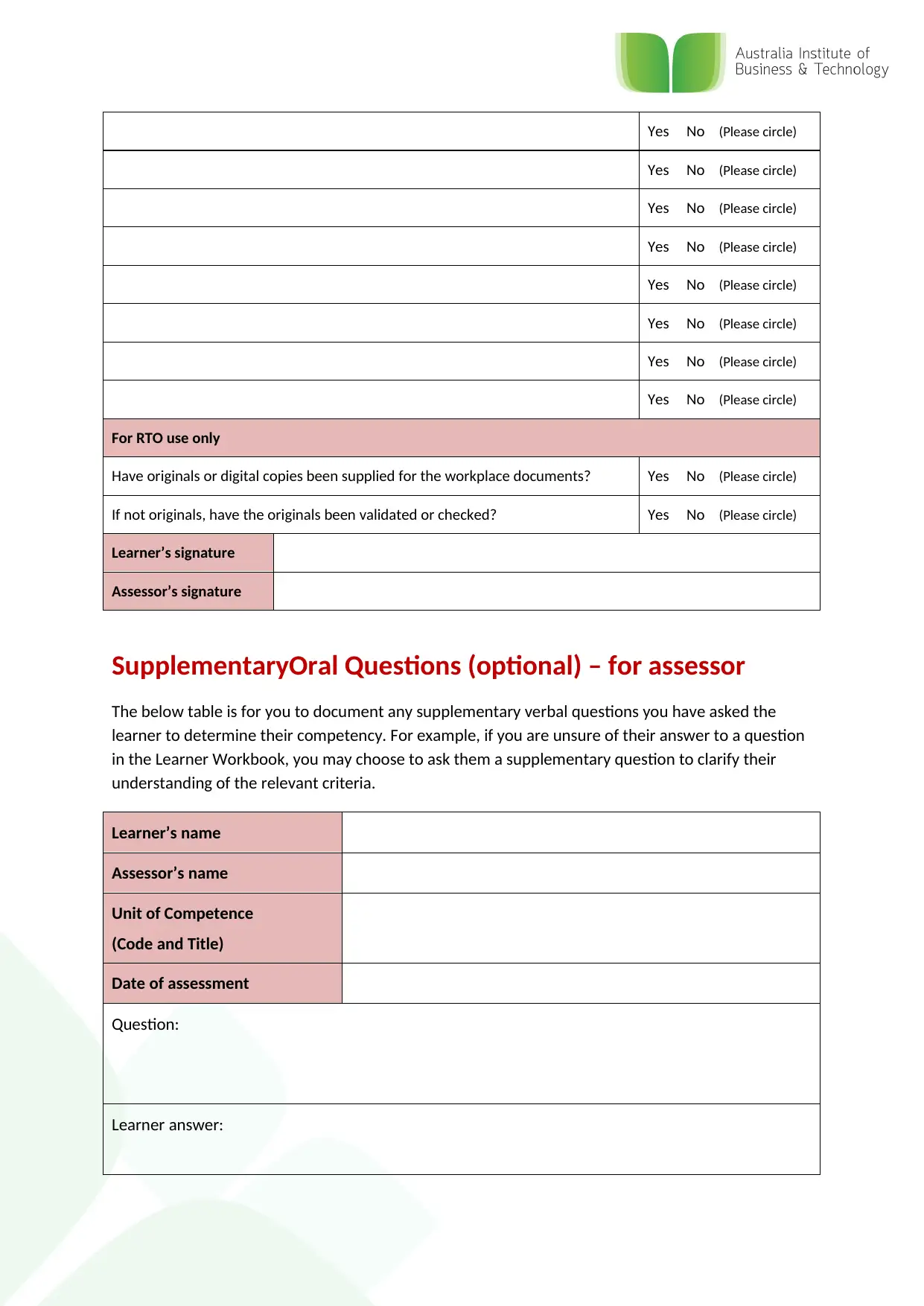
Yes No (Please circle)
Yes No (Please circle)
Yes No (Please circle)
Yes No (Please circle)
Yes No (Please circle)
Yes No (Please circle)
Yes No (Please circle)
For RTO use only
Have originals or digital copies been supplied for the workplace documents? Yes No (Please circle)
If not originals, have the originals been validated or checked? Yes No (Please circle)
Learner’s signature
Assessor’s signature
SupplementaryOral Questions (optional) – for assessor
The below table is for you to document any supplementary verbal questions you have asked the
learner to determine their competency. For example, if you are unsure of their answer to a question
in the Learner Workbook, you may choose to ask them a supplementary question to clarify their
understanding of the relevant criteria.
Learner’s name
Assessor’s name
Unit of Competence
(Code and Title)
Date of assessment
Question:
Learner answer:
Paraphrase This Document
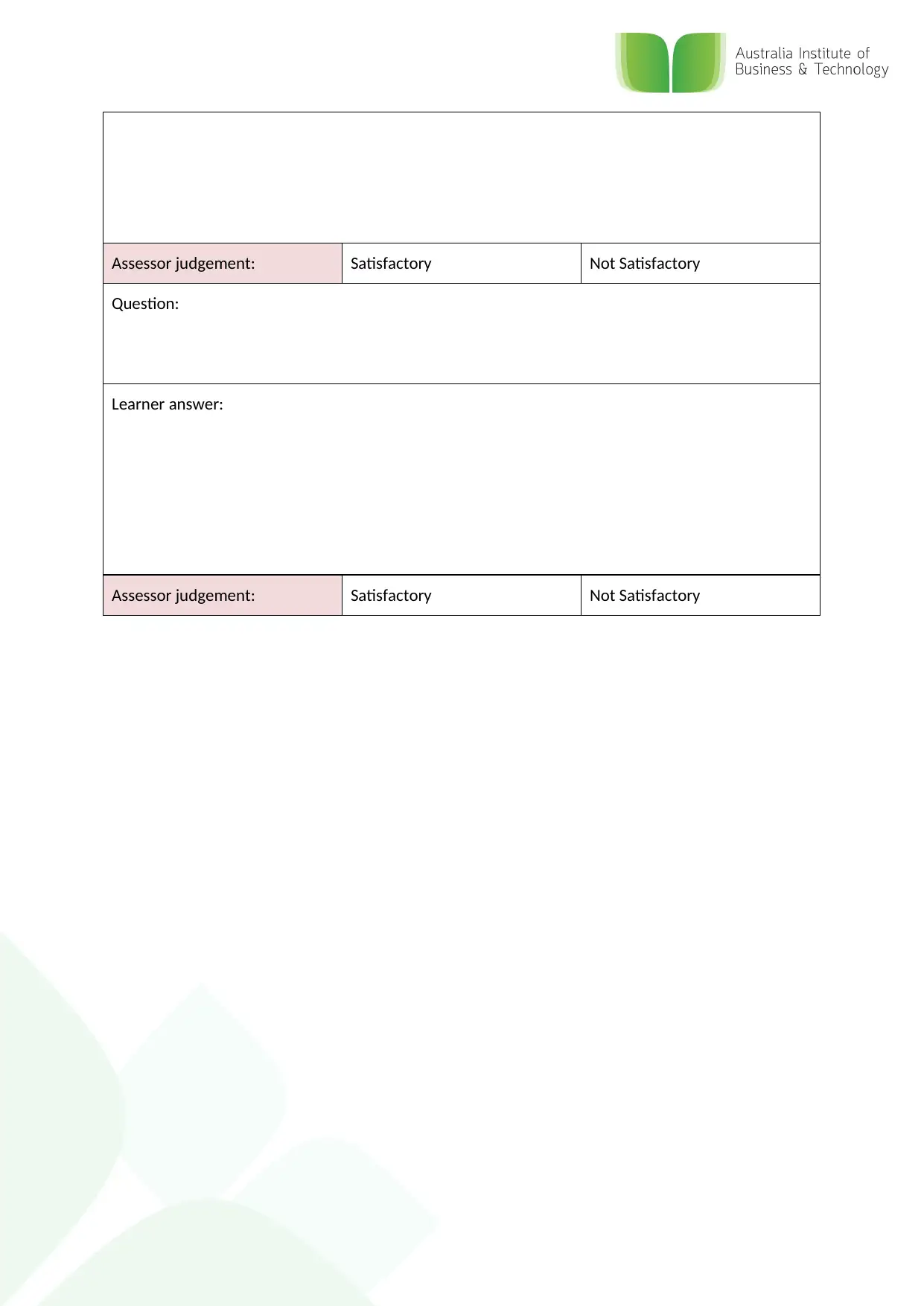
Question:
Learner answer:
Assessor judgement: Satisfactory Not Satisfactory
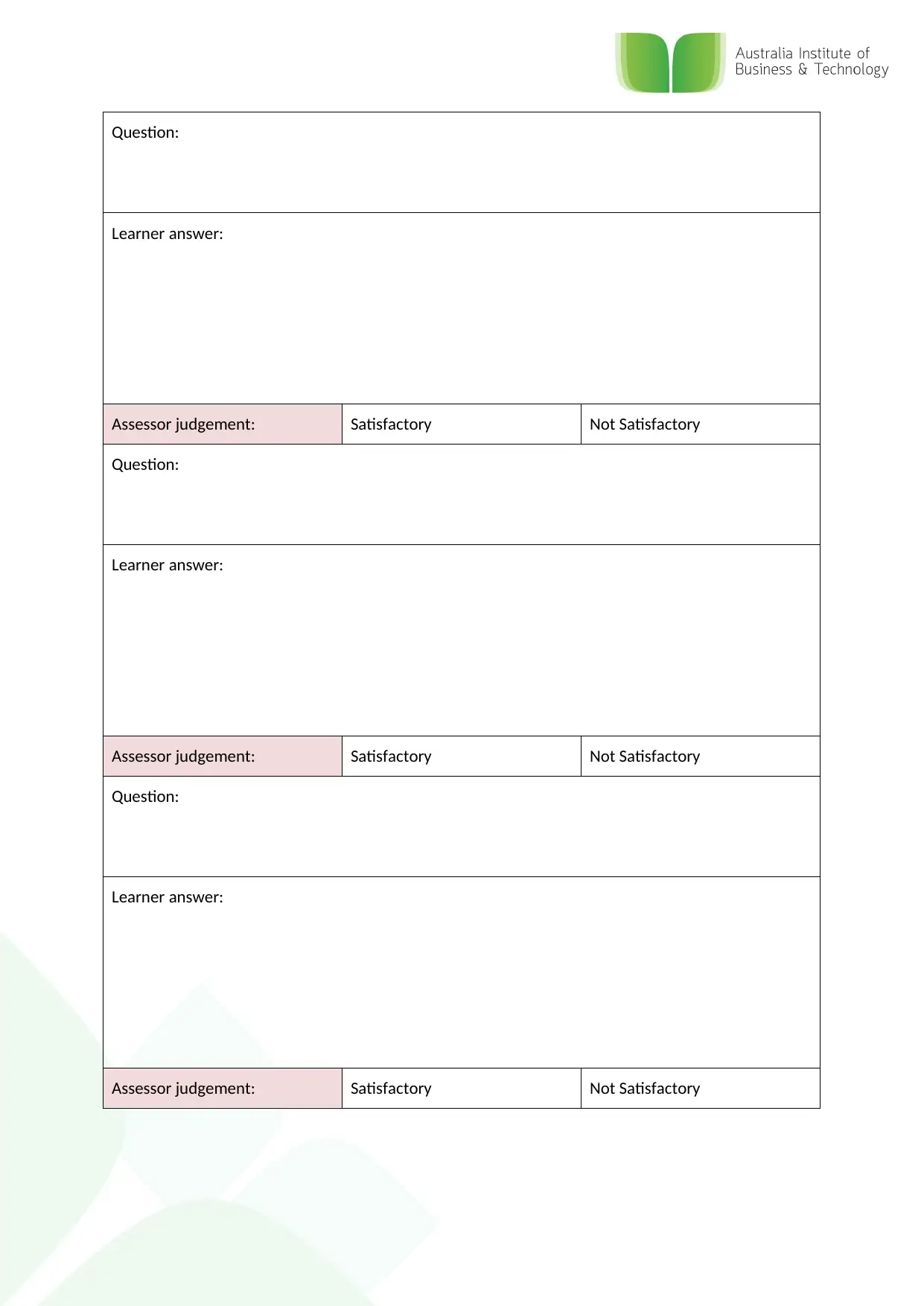
Learner answer:
Assessor judgement: Satisfactory Not Satisfactory
Question:
Learner answer:
Assessor judgement: Satisfactory Not Satisfactory
Question:
Learner answer:
Assessor judgement: Satisfactory Not Satisfactory
⊘ This is a preview!⊘
Do you want full access?
Subscribe today to unlock all pages.

Trusted by 1+ million students worldwide
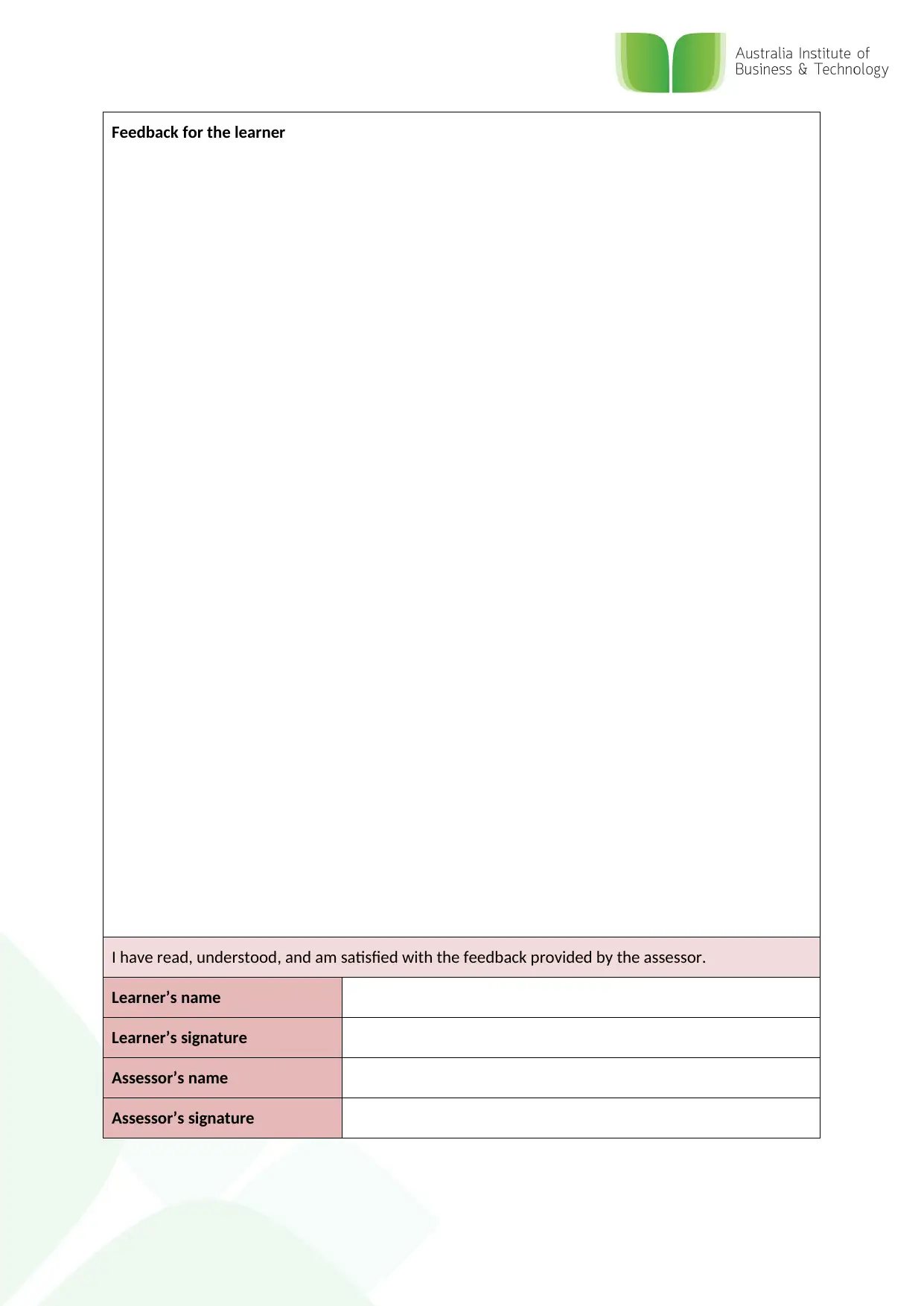
I have read, understood, and am satisfied with the feedback provided by the assessor.
Learner’s name
Learner’s signature
Assessor’s name
Assessor’s signature
Paraphrase This Document
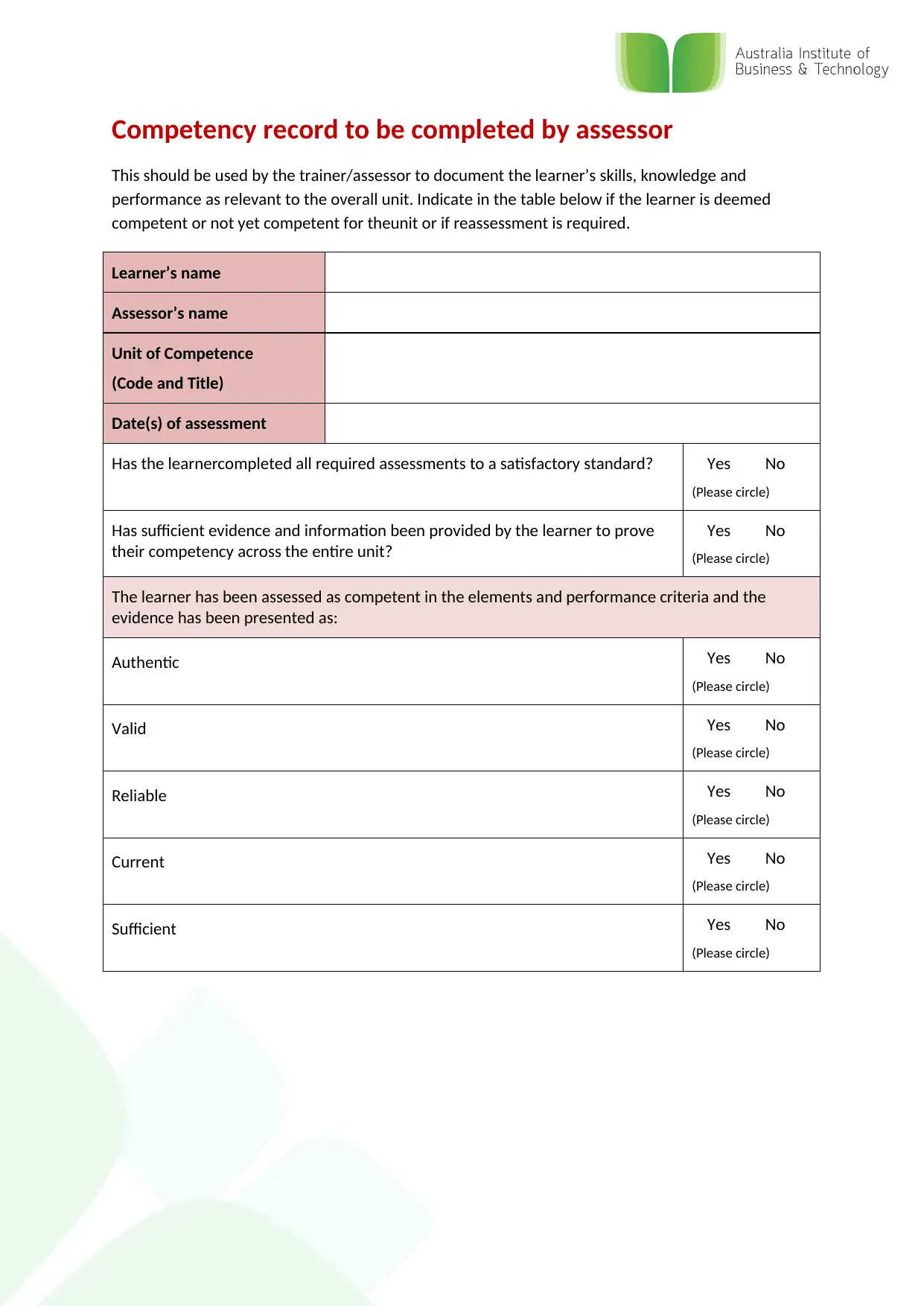
This should be used by the trainer/assessor to document the learner’s skills, knowledge and
performance as relevant to the overall unit. Indicate in the table below if the learner is deemed
competent or not yet competent for theunit or if reassessment is required.
Learner’s name
Assessor’s name
Unit of Competence
(Code and Title)
Date(s) of assessment
Has the learnercompleted all required assessments to a satisfactory standard? Yes No
(Please circle)
Has sufficient evidence and information been provided by the learner to prove
their competency across the entire unit?
Yes No
(Please circle)
The learner has been assessed as competent in the elements and performance criteria and the
evidence has been presented as:
Authentic Yes No
(Please circle)
Valid Yes No
(Please circle)
Reliable Yes No
(Please circle)
Current Yes No
(Please circle)
Sufficient Yes No
(Please circle)
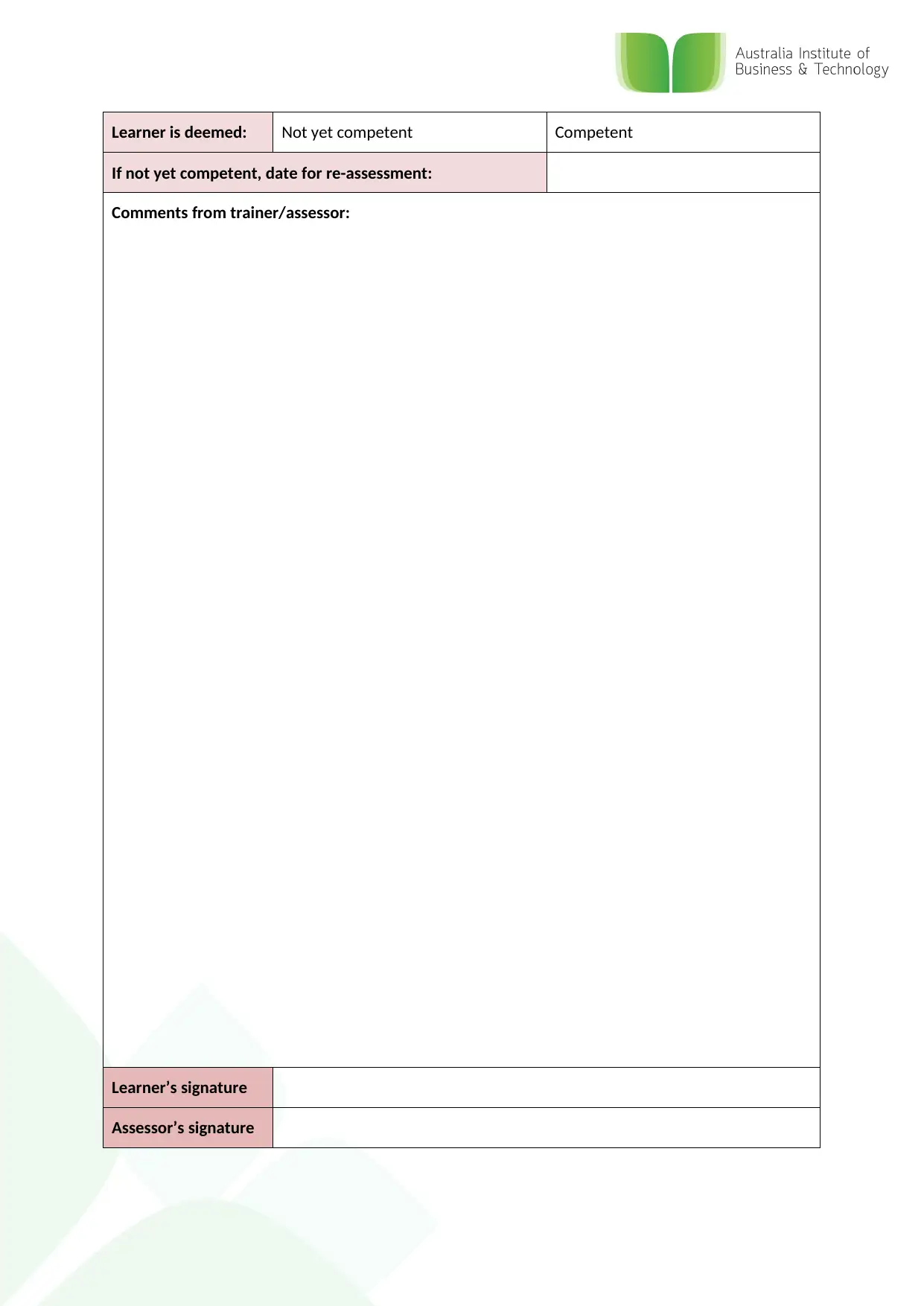
If not yet competent, date for re-assessment:
Comments from trainer/assessor:
Learner’s signature
Assessor’s signature
⊘ This is a preview!⊘
Do you want full access?
Subscribe today to unlock all pages.

Trusted by 1+ million students worldwide
Related Documents
Your All-in-One AI-Powered Toolkit for Academic Success.
+13062052269
info@desklib.com
Available 24*7 on WhatsApp / Email
![[object Object]](/_next/static/media/star-bottom.7253800d.svg)
© 2024 | Zucol Services PVT LTD | All rights reserved.





